Sonim Technologies P35F008AA 3G Quad Band GSM/UMTS Digital Mobile Phone User Manual 15 XP5520 UserMan
Sonim Technologies, Inc. 3G Quad Band GSM/UMTS Digital Mobile Phone 15 XP5520 UserMan
UserMan

1
USER
GUIDE
SONIM XP5520
BOLT
English
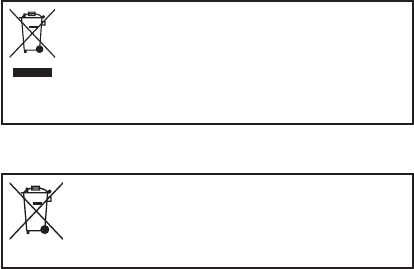
2
Copyright © 2011 Sonim Technologies, Inc.
SONIM and the Sonim logo are trademarks of Sonim
Technologies, Inc. Other company and product names
may be trademarks or registered trade-marks of the
respective owners with whom they are associated.
Disposal of Old Electrical and Electronic Equipment
The symbol of the crossed-out wheeled
bin indicates that within the countries in
the European Union, this product, and any
enhancements marked with this symbol,
can not be disposed as unsorted waste
but must be taken to separate collection at
their end- of-life.
Disposal of Battery
Please check local regulations for disposal
of batteries. The battery should never be
placed in municipal waste. Use a battery
disposal facility if available.

3
Contents
General Information———————— 7
Phone Models Covered
Network Services
Sonim Support Information
Use the Guide Effectively
Your Safety Guidelines———————— 10
Battery Performance
Battery Replacement
Avoid Short Circuit
Avoid High Temperatures
Battery Disposal
Personal Medical Devices
Child Safety
Emergency Calls
SAR Information
Getting Started with XP5520 BOLT———————— 15
Battery Usage
Inserting the Battery
Removing the Battery
Charging the Battery
Set Battery Alert
Your SIM Card
Inserting the SIM Card
Removing the SIM Card
Switching On
Home Screen
Key Shortcuts in Home Screen
Getting Started with XP5520 BOLT———————— 22
Basic Settings
Keypad Functions
Your Sonim XP5520 BOLT———————— 27
Main Menu
Main Menu Icons
Home Screen Indicators
Key Operations without Your SIM Card
Managing Calls———————— 31
Dial a Number
Dial an International Number
Dial a Number via Contacts
Dial a Number via the Call History
Managing Call History
Call Timers
Call Settings
Auto Answer
Any key Answer
Call Waiting
Caller ID
Call Forwarding
Call Barring
Fixed Number Dialing
Advanced Settings
Receive a Call
Record a Call
Managing Phone Settings———————— 35
Time and Date Settings
Schedule Power On/Off Settings
Language Settings
Display Settings
Customizing Dedicated Keys
Managing Speed Dial Numbers
Power Saving Settings
Auto Keypad Lock
Connecting to Hearing Aid
Managing Network Settings———————— 37
Network Selection
Preferences
Data Connection
Data Account
Service Selection
A-GPS Settings

4
Managing Security Settings———————— 40
Restore Factory Settings
Managing Connectivity———————— 41
Sending Data via Bluetooth
Receiving Data via Bluetooth
USB Function
Managing Your Files———————— 44
Managing Contacts———————— 46
Add a New Contact
View the Contact Details
Sending a Message from Contacts
Dialing a Number from Contacts
Edit the Contact Details
Delete Contact
Copy Numbers between Phone and SIM
Move Numbers between Phone and SIM
Sending Contact
Selecting Multiple Contacts
Caller Groups
Phonebook Settings
Searching Contacts
Managing Messages———————— 51
Write Message
Manage Your Messages
Inbox
Drafts
Outbox
Sent Messages
Archive
Conguring Email Accounts
Write Email
Email Inbox
Email Outbox
Email Sent
Email Draft
Broadcast Messages
Templates
Message Settings
SMS Settings
MMS Settings
Managing Proles———————— 59
Sound Settings
Calendar
Alarm
Calculator
Unit Converter
World Clock
Sound Recorder
Notes
Stopwatch
Text Reader
SIM Card Menu
Network Prole Settings
GPS Navigator
Self Serve
Installing Java Application from WAP
Installing Java Application from Memory Card
WAP Browser———————— 65
Managing PTT Services———————— 66
Activating the PTT service
Login and Logout the PTT Service
Public Subscriber Privilege
Corporate Subscriber Privilege
Corporate-Public Subscriber Privilege
PTT Key Functions
PTT Display Icons
Manage PTT Settings
Managing PTT Calls
Direct PTT Calls
Calls from PTT Contacts List
Contents

5
Sending Alerts
Block Incoming PTT Calls
Manage PTT Contact List
Manage PTT Groups
Manage PTT Favorite Contacts
Manage PTT Favorite Groups
Managing Multimedia Files———————— 76
Camera
Camera Options
Media Player
FM Radio
Hardcoded Shortcuts———————— 79
Using Menory Card———————— 80
Inserting Memory card into the Phone
Using PC- TOOLS———————— 81
Installation of PC-Tools
Using PC-Tools with XP5520 Phone
End User License Agreement———————— 82
Comprehensive 3 Year Warranty
Our Warranty
What We Will Do
Phone Care
Conditions
FCC Statement
Index———————— 86
Contents

6
• Make sure to register within 30 days from date of purchase to activate and take advantage of this Comprehensive
Product Warranty. Sonim reserves the right to refuse warranty service otherwise.
• Refer to
www.sonimtech.com/register for further details.

7
Congratulations on the purchase of a Sonim XP5520™
BOLT mobile phone. This phone is a GSM/GPRS/EDGE/
UMTS enabled handset with quad-band capabilities and
has an intuitive, feature-rich user interface, which allows
you to make the best use of the offered functions.
Phone Models Covered
This user guide covers Sonim XP5520 BOLT™ phone
model XP5520-A-R1. The model name can be read on
the phone label under the battery.
This device utilizes the following 2G RF bands: GSM
850, GSM 900, DCS 1800, PCS 1900 MHz bands and
supports the UMTS 850 MHz, 1900 MHz and 2100 MHz
bands.
Network Services
These are additional services that you can avail through
your network service provider. To make the best of these
services, you must subscribe to them through your
service provider and obtain instructions for their use from
your service provider.
Sonim Support Information
For additional product and support information, visit
www.sonimtech.com.
Use the Guide Effectively
Familiarize yourself with the terminology and symbols
used in the guide to help you use your phone effectively.
HOME SCREEN This is the screen displayed when
the phone is in idle condition.
PRESS Means to press and release a key
immediately. For example, Press
2 means that you press the key
on the keypad that is labelled
with the numeral 2 and the
alphabets “ABC”.
General Information
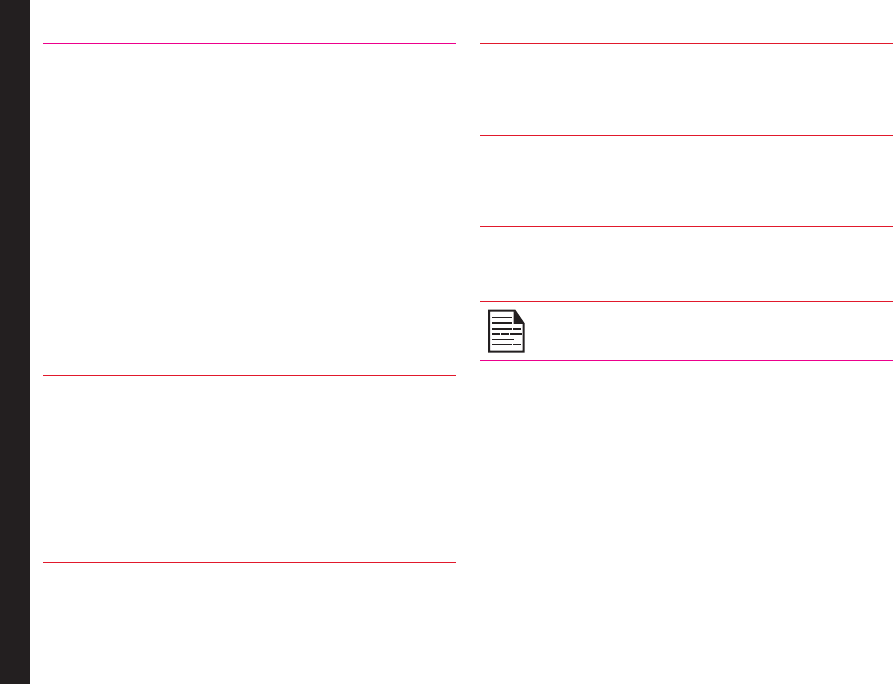
8
SELECT Means to either press the
Left or Right Selection Key
to apply the command
indicated at the bottom
of the screen. The Center
navigation key can also be
used to select options. For
example, if this guide says
Select Menu > Messages
> Write message, you
must press the Left
Selection Key to select
Menu, scroll to Messages
and press the Left
Selection Key, scroll to
Write message and press
the Left Selection Key.
To return to the previous
screen, press the Right
Selection Key.
PRESS & HOLD Means to press and hold
a key for 2 seconds before
releasing the key. This
action is typically used
when trying to switch on/
off the phone or when
using shortcut keys to
access specic functions.
For example: press
and hold 1 to access
voicemail.
MENU OPTIONS Press Options to display
menu options on the
screen. The selection keys
are used to accomplish
the indicated option.
SELECT MENU Means to press the Left
Selection Key to select
the Menu option or press
the Menu key (centre) for
the same result.
A MENU ITEM SUFFIXED
WITH THREE DOTS (…)
Means more options are
available but only one has
been mentioned in the
guide.
Signies a Note.
General Information

9
Options Commonly Used across Menu Items
The following are common actions used across various
menu items:
BACK Displays the previous
screen. Use the Right
Selection Key to perform
this function.
CLEAR Deletes data character by
character. Use the Right
Selection Key to perform
this function.
OK Conrms an action. Use
the Left Selection Key or
the Menu key to perform
this function.
CLEAR KEY Use this key to delete
while editing a message
or delete a selected item
in a list.
BACK KEY Use this key to display the
previous screen.
General Information
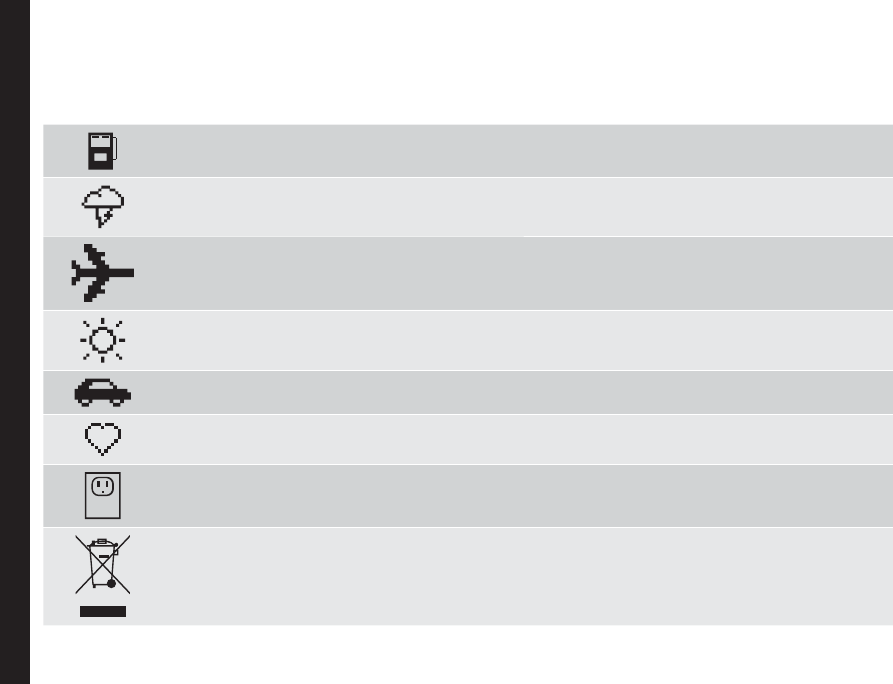
10
Please read and understand the following safety guidelines before you use the phone. These guidelines provide details
to enable you to operate your phone safely and conform to any legal requirements regarding the use of cellular phones.
Do not to use the phone at a refuelling point. Observe restrictions when using radio equipment at
fuel depots, chemical plants or where blasting operations are in progress.
Electrical interference may obstruct the use of your phone. Observe restrictions in hospitals and
near medical equipment.
Switch off your cellular phone when in an aircraft. Wireless phones can cause interference or danger
to an aircraft. In an aircraft, the phone can be used in flight mode.
Do not expose the battery to high temperatures (in excess of 60°C).
Adhere to road safety laws. Do not hold/use a phone while you are driving; find a safe place to stop
first. Use hands-free microphone while you are driving.
Avoid using the phone in close proximity to personal medical devices,
such as pacemakers and hearing aids.
Use only Sonim XP5520 approved charging equipment to charge your phone and avoid damage to
your phone.
The symbol of the crossed-out wheeled bin indicates that within the countries in the European
Union, this product, and any enhancements marked with this symbol, can not be disposed as
unsorted waste but must be taken to separate collection at their end-of-life.
Your Safety Guidelines
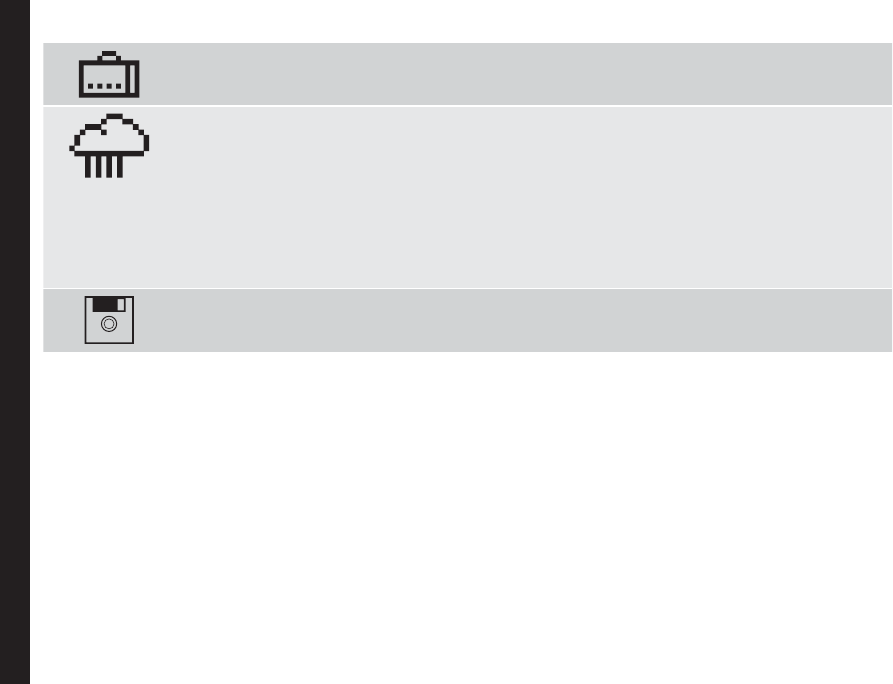
11
Ensure that only qualied personnel install or repair your phone.
The Sonim XP5520 is water-proof and can be submerged to 2 metres for 30 minutes.
• Ensure to properly close the rubber cover of the charging connector and audio connector, to
avoid deposits of water drops on these connectors, when the phone is immersed in water.
• Water droplets may condense under the display cover if the phone is immersed in water
with signicant drop in temperature. This does not indicate water leakage. The droplets will
disappear at room temperature.
The Sonim XP5520 is dust-resistant, rugged and shock-resistant. However, it is not dust-proof
or unbreakable if subjected to overwhelming impact. For best results and long product life, one
should protect the Sonim XP5520 from salt water, dust and strong impacts.
Make back-up copies of important information stored in your phone or maintain a written record.
Your Safety Guidelines
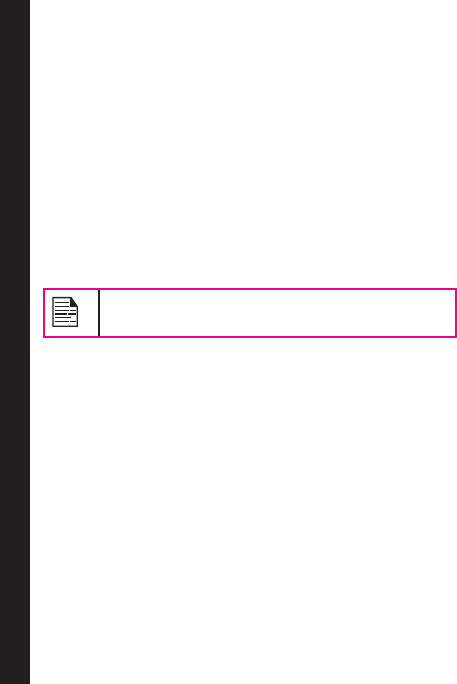
12
Battery Performance
A rechargeable battery powers your device. Use the
battery only for its intended purpose. Never use any
charger or battery that is damaged. If the battery is
completely discharged, it may take a few minutes before
the charging indicator appears on the display or before
any calls can be made. The full performance of a new
battery is achieved only after three to four complete
charge and discharge cycles. The battery can be charged
and discharged hundreds of times but it will eventually
wear out. Unplug the charger from the electrical plug and
the device when not in use. Ensure that you do not leave
the fully charged battery connected to the charger for
longer time. If left unused, a fully charged battery will lose
its charge over time.
There is a risk of explosion while charging if the
battery has been replaced by an incorrect type.
Battery Replacement
When the talk and standby times are noticeably shorter
than normal, replace the battery with an original Sonim
battery. If a replacement battery is being used for the rst
time or if the battery has not been used for a prolonged
period, it may be necessary to connect the charger and
then disconnect and reconnect it to begin charging the
battery.
Avoid Short Circuit
Do not short-circuit the battery. An accidental short-
circuit can occur when a metallic object such as a coin,
clip, or pen causes direct connection of the positive (+)
and negative (-) terminals of the battery. (These look
like metal strips on the battery.) This might happen, for
example, when you carry a spare battery in your pocket
or purse. A short-circuit at the terminals may damage the
battery or the connecting object.
Avoid High Temperatures
Leaving the battery in hot or cold places, such as in a
closed car in summer or winter conditions, will reduce
the capacity and lifetime of the battery. For the best
results, try to keep the battery between -20°C and +55°C
(-4°F and 131°F). A device with a hot or cold battery
may not work temporarily, even when the battery is fully
charged. Battery performance is particularly limited in
temperatures well below freezing.
Battery Disposal
Do not dispose off batteries in a re as they may explode.
Batteries may also explode if damaged. Dispose of
batteries according to local regulations and recycle when
possible. Do not dispose as household waste. Do not
dismantle, open or shred cells or batteries. In the event of
a battery leak, do not allow the liquid to come in contact
with the skin or eyes. In the event of leak or a hazard
seek medical help immediately.
Personal Medical Devices
Mobile phones may affect the operation of cardiac
pacemakers and other implanted equipment. Please
avoid placing the mobile phone over the pacemaker, for
example in your breast pocket. When using the mobile
phone, place it at the ear opposite the pacemaker. If a
minimum distance of 15 cm (6 inches) is kept between
the mobile phone and the pacemaker, the risk of
interference is limited. If you suspect that interference
is taking place, immediately turn off your mobile phone.
Contact your cardiologist for more information. For
other medical devices, consult your physician and the
Your Safety Guidelines

13
Your Safety Guidelines
manufacturer of the device. Comply with instructions to
switch off the device or deactivate the RF transmitter
when required, especially when posted in hospitals and
aeroplanes. Equipment used in these places may be
sensitive to radio waves emitted from the device and
adversely affect their operation. Also, observe restrictions
at gas stations or other areas with ammable atmosphere
or when close to electro-explosive devices.
Child Safety
Do not allow children to play with your mobile phone or
its accessories. Keep it out of their reach. They could
hurt themselves or others, or could accidentally damage
the mobile phone or accessories. Your mobile phone and
its accessories may contain small parts, which could be
detached and create a choking hazard.
Emergency Calls
Mobile phones operate using radio signals, which cannot
guarantee connection under all conditions. Therefore
you should never rely solely upon any mobile phone for
essential communications (e.g. medical emergencies).
Emergency calls may not be possible in all areas, on all
cellular networks, or when certain network services and/
or mobile phone features are in use. Check with your
local service provider.
SAR Information
The Sonim XP5520 BOLT has been certified in
compliance with the Government’s requirements for
exposure to Radio Waves.
When communicating over the wireless network, the
mobile phone emits via the radio frequency waves low
levels of radio energy. The Specic Absorption Rate, or
SAR, is the amount of RF energy absorbed by the body
while using the phone and is expressed in watts/kilogram
(W/kg).
Governments around the world have adopted
comprehensive international safety guidelines, developed
by scientic organizations, for example, ICNIRP
(International Commission on Non-Ionizing Radiation
Protection) and IEEE (The Institute of Electrical and
Electronics Engineers Inc.). These guidelines establish
permitted levels of radio wave exposure for the general
population.
Tests for SAR are conducted using standardized methods
with the phone transmitting at its highest certied power
level in all used frequency bands.
SAR Data Information for residents in the United
States and Canada.
In the United States and Canada, the SAR limit for
mobile phones used by the public is 1.6 watts/kilogram
averaged over one gram of tissue. The standard
incorporates a margin of safety to give additional
protection for the public and to account for any variations
in measurements.
Before a phone model is available for sale to the public
in the US, it must be tested and certied by the Federal
Communications Commission (FCC) that it does not
exceed the limit established by the government-adopted
requirement for safe exposure. The tests are performed
in positions and locations (that is, by the ear and worn on
the body) as required by the FCC for each model.
The highest SAR value for the Sonim XP5520-A-R1
phone when tested by Sonim for use:
• By the ear is 1.35 W/kg (1 g).
• Worn on the body is 1.28 W/kg (1 g).

14
Your Safety Guidelines
For body-worn operation, this phone meets FCC RF
exposure guidelines provided that it is used with a non-
metallic accessory with the handset at least 1.5 cm from
the body, or with the original Sonim accessory intended
for this phone and worn on the body. Use of other
accessories may not ensure compliance with FCC RF
exposure guidelines.
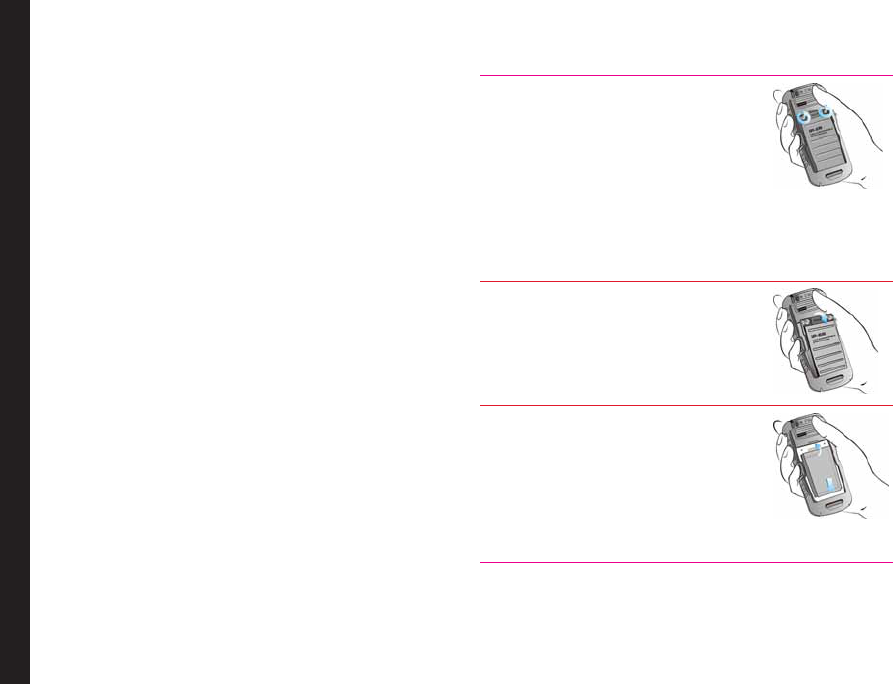
15
Getting Started with XP5520 BOLT
This section provides information on using your Sonim
XP5520 phone.
The list of items in the Sonim XP5520 phone box are:
• Tip sheet
• Quick Start Guide
• Welcome Letter
• Battery
• Screw driver
• Wired headset
• USB Adaptor
• Data Cable
• USB Wall Charger
Battery Usage
• Use only a Sonim XP5520 certied battery that is
designed for this phone model.
• The use of other batteries may void the warranty
terms of your phone and cause damage.
• It is recommended to protect the battery
from extreme temperature environments and
moisture.
• Please keep the battery out of the reach of children.
Inserting the Battery
1 Unscrew Cover
To open the battery cover,
rotate both the battery cover
screws in an counter clockwise
direction (as shown in the gure).
Sometimes, the battery cover
may be tight and some extra
effort is required to open it. You
can use the screwdriver provided
to open the screws.
2 Lift Cover
Lift the back cover to reveal the
battery slot.
3 Insert Battery
Insert the battery and ush into
the battery slot such that the
three metallic contacts at the top
of the battery are aligned with
the metallic contacts within the
battery compartment.
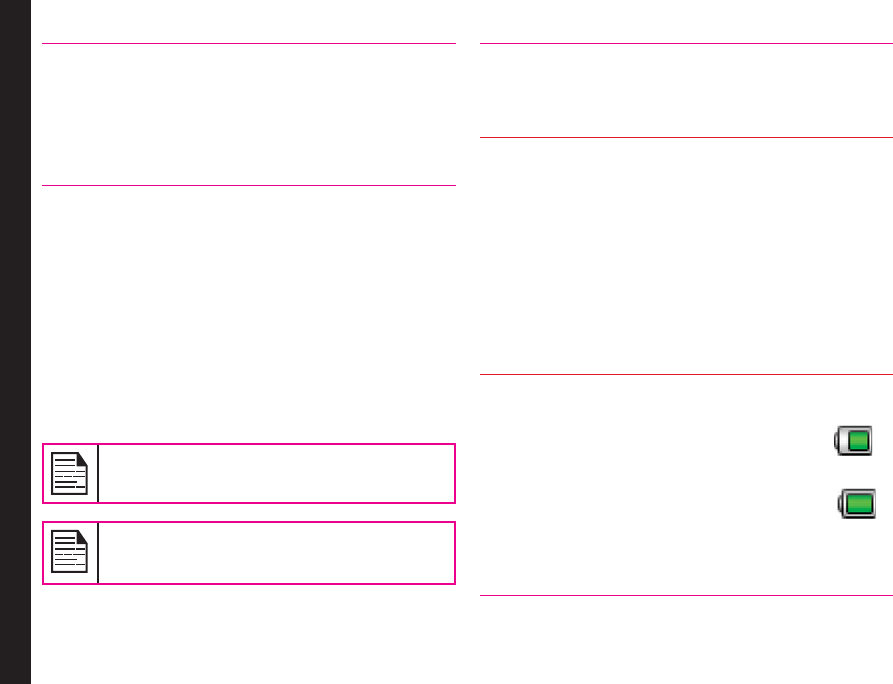
16
Getting Started with XP5520 BOLT
4 Close Cover
Close the battery cover. Rotate the battery
cover screws in clockwise direction. You
can use the screwdriver provided to tighten
the screws. Ensure not to overtighten the
screws.
Removing the Battery
Follow steps 1 and 2 of “Inserting the Battery” on page 15.
To remove the battery, lift the cover behind the phone and
raise the upper end of the battery from the slot. Follow
step 4 of “Inserting the Battery” on page 15 to close the
cover.
Charging the Battery
The battery delivered with your mobile phone is not fully
charged. We recommend that you charge your mobile for
5 hours before you use your mobile phone for the rst
time.
There is a risk of explosion while charging if the
battery has been replaced by an incorrect type.
If the battery is completely out of charge, it can
take several minutes for the charging icon to
appear when the charger is connected.
1 Insert Charger
Insert the charger plug into a power outlet
2 Connect to Phone
The charger port is located on the left side
of the phone. To access the charger port,
lift the cover with the USB sign. Insert the
3.5 mm jack/connector of the charger to
the port. You can also use the standard
USB cable and adaptor to charge the
phone battery. Insert the adaptor to the
charger port of the phone. Connect one
end of the standard USB cable to the
adaptor and the other end of the USB
cable to the PC.
3 Charging Animation/Icon
If the battery is being charged when the
phone is switched off,only the battery
icon is displayed. If the battery is being
charged while the phone is switched on,
the bars in the battery charge icon on the
home screen shows animation indicating
that the battery is being charged. After
the phone is fully charged the battery bars
on the display stop scrolling. You can
disconnect the charger from the phone.

17
Getting Started with XP5520 BOLT
Set Battery Alert
When you set the battery alert, every time the battery
charge is low you hear an alarm. To set the battery
alert select Menu > Settings > Profiles > any profile >
Options > Customize > Extra tone > Warning. Select to
activate the alert.
Your SIM Card
Purchase a SIM card from a mobile operator. The SIM
card associates your network services (for example,
phone number, data services, and so on) with your
phone.
Inserting the SIM Card
1 Switch Off Phone
Ensure that the phone is switched off.
2 Lift Cover
Lift the battery cover and remove
the battery. For instructions refer
“Inserting the Battery” on page 15.
3 Place SIM Card
Place the SIM card by pushing it
upward in the designated slot located
under the battery.
4 Lock Cover
Reinsert the battery and the cover.
Turn the battery cover screws
clockwise to lock the battery cover.
Removing the SIM Card
1 Switch Off Phone
Ensure the phone is switched off.
2 Lift Cover
Lift the battery cover and remove
the battery. For
instructions refer “Inserting the
Battery” on page 15.
3 Remove SIM Card
Remove the SIM card by pushing
it downward from the slot.
4 Lock Cover
Reinsert the battery and the cover.
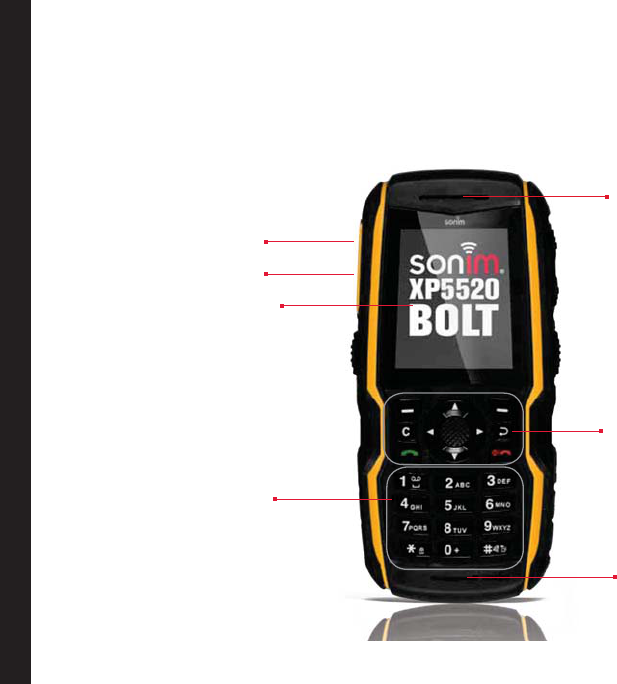
18
Parts of the Sonim XP5520 BOLT Phone
The Sonim XP5520 keypad has 11 function keys
and 12 alphanumeric keys. The left side of
the phone has one key and the right side
of the phone has three keys.
Getting Started with XP5520 BOLT
Ear piece
Display screen
Function keys
Headset port
Charger/USB port
Alphanumeric keys
Microphone
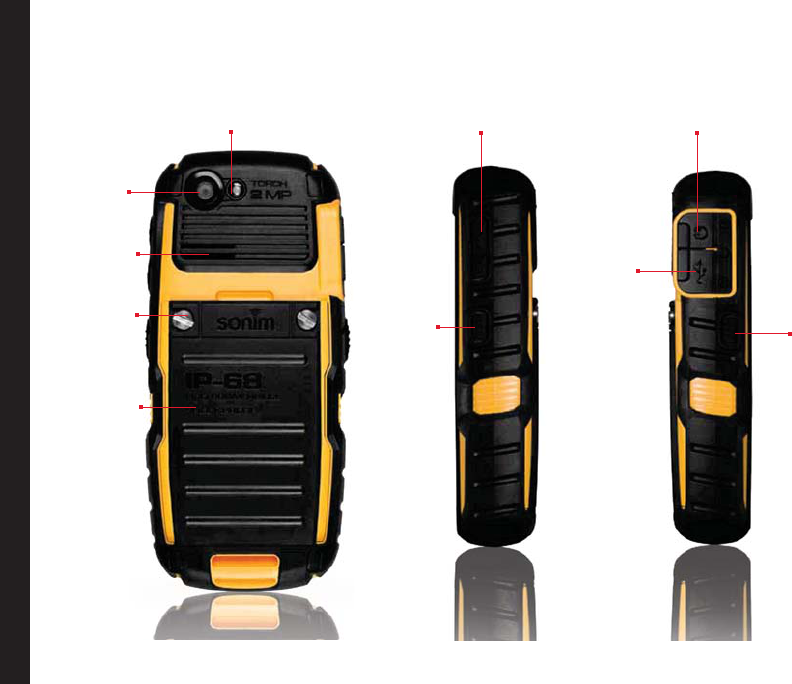
19
Getting Started with XP5520 BOLT
Parts of the Sonim XP5520 BOLT Phone
Torc h
Loud speaker
Battery cover
screws
Battery cover
Volume keys
Torch
(press
and hold)
Headset port
Charger/
USB port
PTT/GPS
navigation
Camera
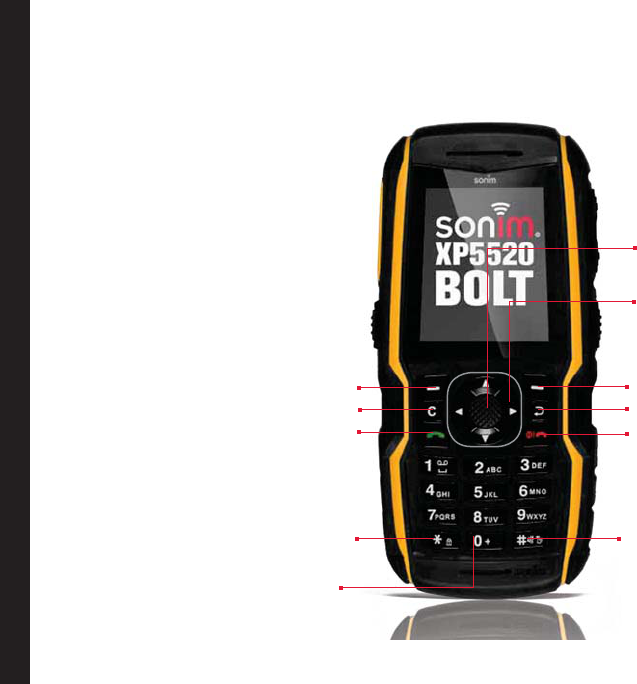
20
Sonim XP5520 BOLT Keypad
The following gure represents different keys in the phone key pad.
Getting Started with XP5520 BOLT
Some features are enabled only if
the SIM card is present.
Menu key
Navigation arrow keys
(Up/Down/Left/Right)
Right Selection Key (RSK)
Power On/Off/End call
Back Key
Left Selection Key (LSK)
Call/Accept/Send
Clear Key
Press and hold to turn
on/off meeting mode
Press and hold to display + (before
dialing an international number)
Press and hold to lock the keypad
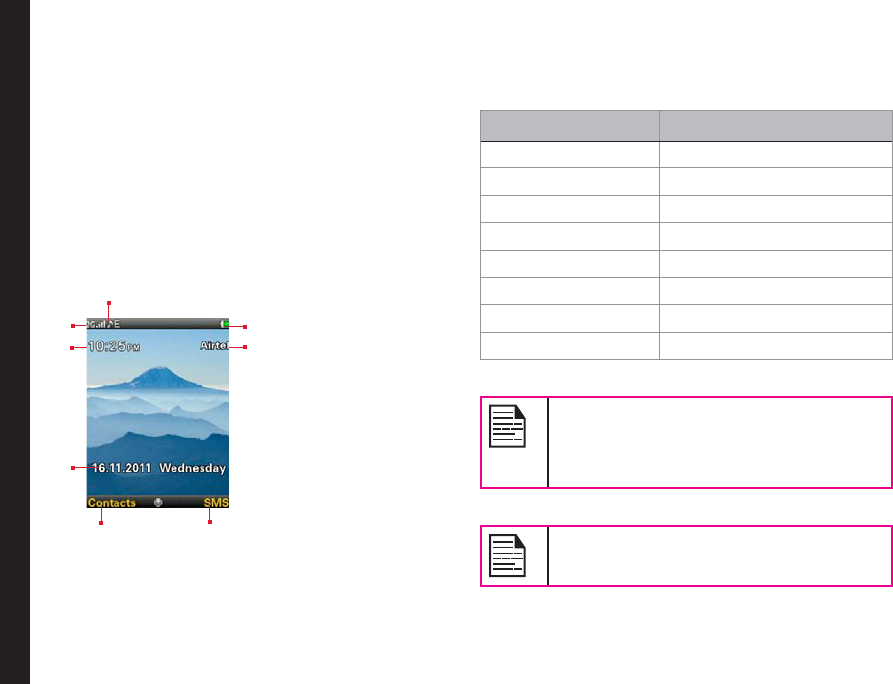
21
Getting Started with XP5520 BOLT
Switching On
Press and Hold the Power ON/OFF key for 2 seconds to
Power ON the phone.
When the phone is switched on, it tries to register with
the network. After successful registration, the name of
the service provider is displayed.
Home Screen
Details such as the name of the service provider, date
and time, battery charge status, and data service
connectivity are displayed when the phone is in standby
mode. Other optional indicators alarm and call forward
will be displayed, if the feature is activated.
1. DISPLAY ICONS
2. BATTERY
CHARGE
INDICATOR
3. SERVICE
PROVIDER
4. RSK COMMAND
5. LSK COMMAND
6. DATE AND DAY
7. TIME
8. SIGNAL
STRENGTH
INDICATOR
Key Shortcuts in Home Screen
The following can be accessed from the home screen.
Press To Access
Menu Key Main menu
Left Selection Key Contacts
Right Selection Key Messages
Call/Accept/Send Key All calls list
Up Arrow Calendar
Down Arrow Proles
Left Arrow New message
Right Arrow Browser
The four functions that are performed using
the arrow keys are set as factory defaults,
To change these functions, select Menu >
Settings > Phone settings > Dedicated key.
Select the required arrow key and select OK.
You cannot use the arrow keys when a
notication for example: 1 missed call, is
displayed on the home screen.
1
2
3
5 4
8
7
6
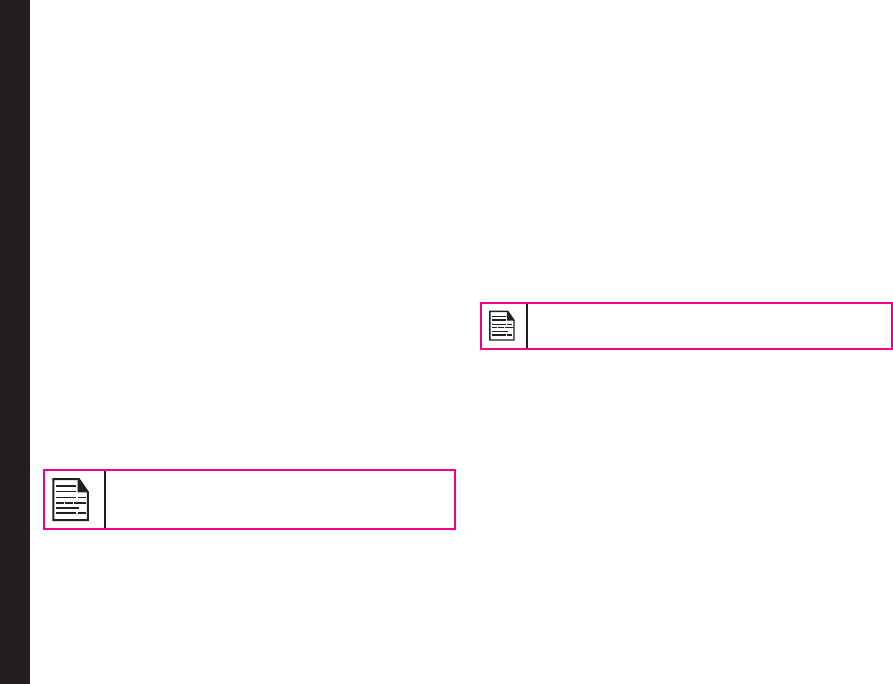
22
Getting Started with XP5520 BOLT
Basic Settings
Security Settings
To prevent unauthorized use of your phone, you can set a
PIN code. The PIN is operator dependent.
1. Select Menu > Settings > Security settings > PIN
protection > On. Input PIN message pops up. Enter
the PIN. Select OK. After this is set, every time you
power on the phone, you will be requested to enter
the PIN. If the PIN code is wrong you cannot access
the phone.
2. To change the PIN code select Menu > Settings >
Security settings > Change PIN. You can change
codes for PIN and PIN2. Contact your service
provider for details.
Phonelock Mode
In the phonelock mode, the phone can be unlocked only
by entering a password.
To enter the phonelock password, select Menu >
Settings > Security settings > Phone lock. Enter the
default phone lock password, to lock the phone. Enter
the password again to unlock the phone.
The default password for phonelock is 1234.
If the phone lock is enabled, you will be requested to
enter the password, when ever you power on the phone.
Auto Keypad Lock
To lock the keypad, select Menu > Settings > Phone
settings > Auto keypad lock. You can choose to switch
it off by selecting None or enable the feature by setting
time.
You can also press and hold the ‘*’ to lock the keypad.
To unlock the keypad, press ‘LSK’ and then ‘*’ key.
Date and Time
To set the Date and Time, select Menu > Settings >
Phone settings > Time and date > Set time/date.
Silent Mode
In the silent mode, the alerts for Calls, Organizer, SMS,
and battery status are disabled. Select Menu > Settings
> Profiles > Silent.
SIM Lock: Based on you service contract, Your
phone may be locked to a specic Operator.
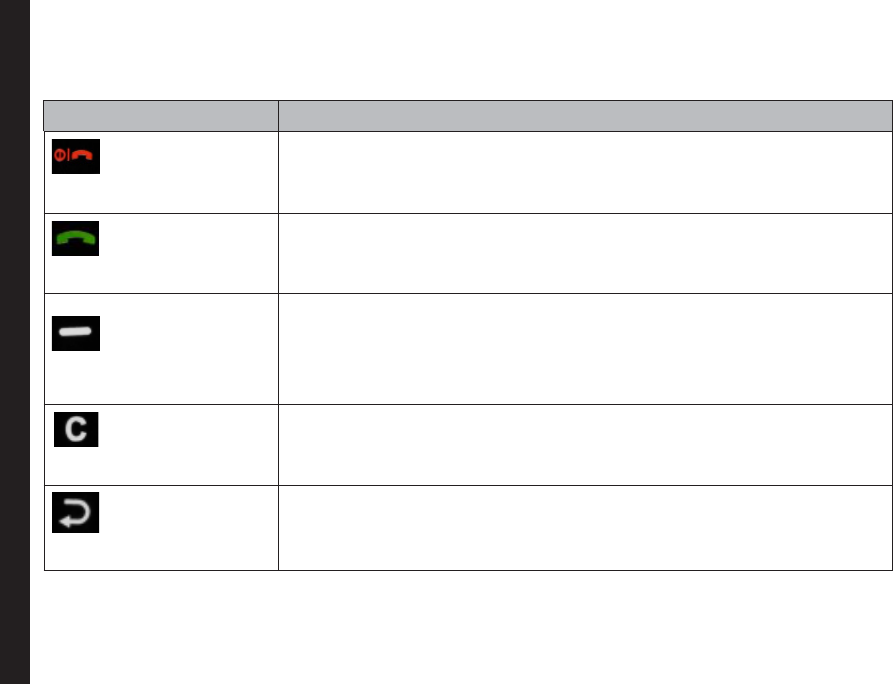
23
Getting Started with XP5520 BOLT
Keypad Functions
The following table displays the various keys and the corresponding functions they perform:
Keypad key Operations
POWER ON/OFF/END CALL
• Press to end a call.
• Press and hold to switch on or switch off the mobile phone.
• Press when in Menu or Edit modes to return to Standby mode.
• Press to reject an incoming call.
CALL/ACCEPT/SEND
• Press to answer an incoming call.
• After entering a phone number, press to make a call.
• Press while in Standby mode to access All calls list.
LSK/RSK
These keys are present immediately below the display screen.
• Press the Left Selection Key (LSK) or Right Selection Key (RSK) to select the
function indicated at the bottom of the screen. The indicated functions can
vary according to different program denitions.
• Press LSK to access the Contacts in standby mode.
• Press RSK to access the Messages in standby mode.
CLEAR (C)
This key is present below the LSK key.
• Press this key to delete the text, while editing a message
• Long press this key to delete the complete message.
• Press this key to delete a selected item in a list.
BACK
This key is present below the RSK key. Press this key to display the previous
screen.
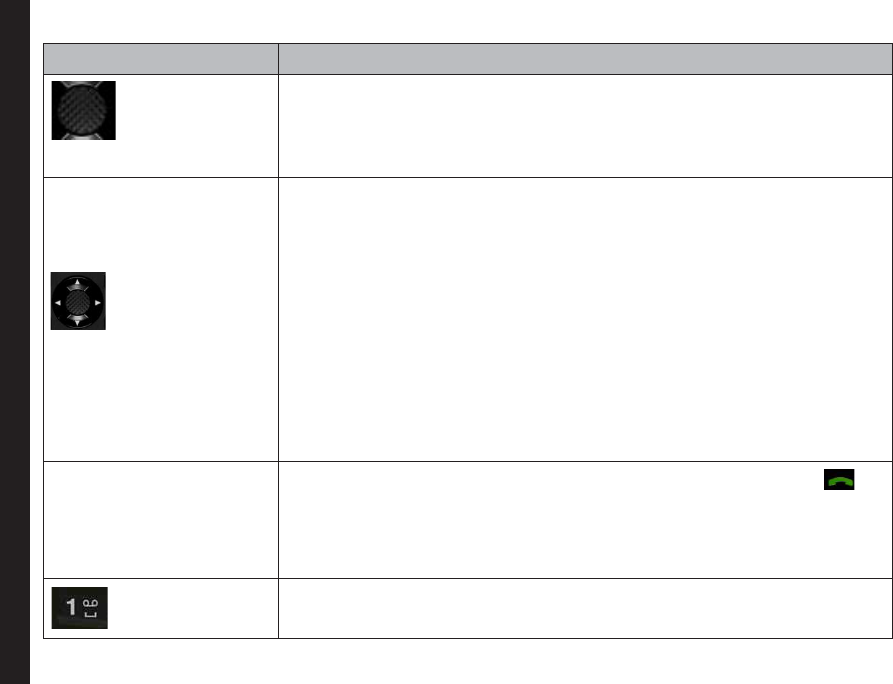
24
Getting Started with XP5520 BOLT
Keypad key Operations
MENU KEY (CENTRE)
Present at the centre of the navigation keys.
• Press while in standby mode to enter the main menu.
• Press when required to be used as a toggle key to select or clear a checkbox.
• Press to perform similar tasks as the Left Selection Key.
• Press to select the OK command.
NAVIGATION KEYS
The Left and Right Selection Keys and Power On/Off keys surround this key group.
There are arrows on the key that denote the direction to scroll for information
displayed on the screen.
UP/DOWN
• Press to move the cursor up or down in the text editor.
• Press to view the pages in the text editor.
• Press to browse menus/lists at the same level.
• Press to browse the main menu.
LEFT/RIGHT
• Press to navigate between tabs.
• Press to move the cursor left or right in the text editor.
• Press to browse the main menu.
• Press to view the previous or next picture when previewing pictures.
ALPHA-NUMERIC KEYS
• Press the required keys to enter the desired phone number and press to
make a call. Alternatively, enter the number and select Options > Call to dial
the number.
• Press and hold any numeric key to access the shortcut /speed dial number
assigned, while in standby mode.
• Enter text while in the text editor.
• Press and hold in standby mode to access your Voice mail.
• When entering text, press to enter space.
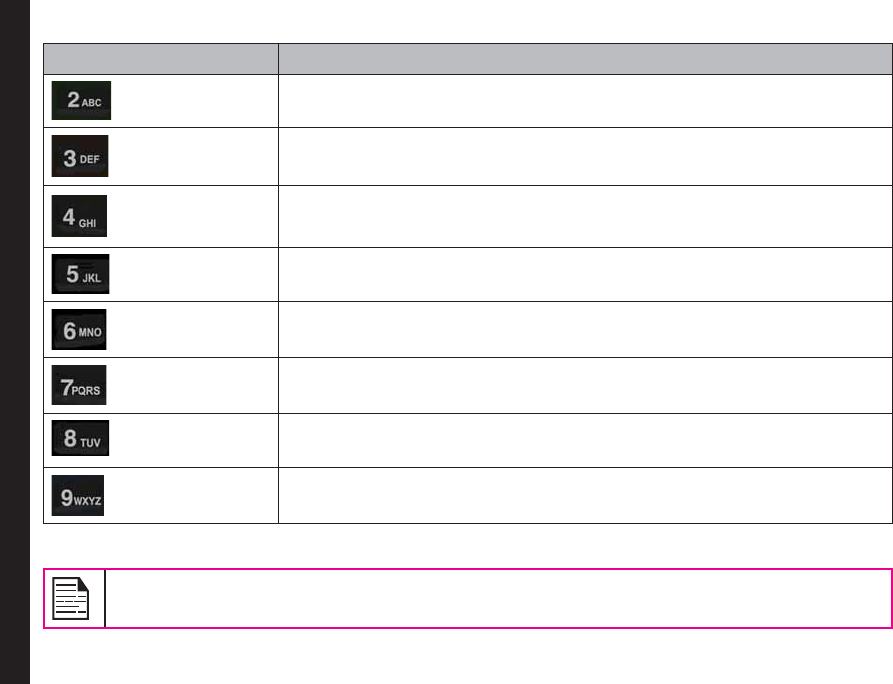
25
Getting Started with XP5520 BOLT
Keypad key Operations
Press and hold to set access Tone settings
Press and hold to access the Proles.
Press and hold to set the alarm.
Press and hold to access the calendar.
Press and hold to access the Bluetooth.
Press and hold to access the Browser.
Press and hold to access shortcuts.
Press and hold to access language list.
The above preset functions of number keys (from 2 to 9) can also be changed to the speed dial
functionality. For more information refer, “Managing Speed Dial Numbers” on page 36 .
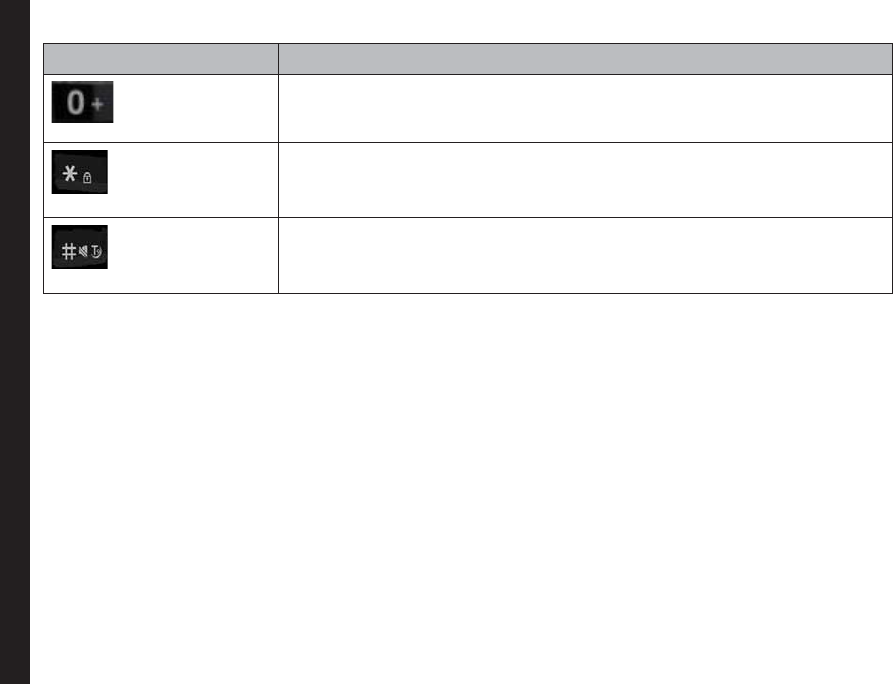
26
Getting Started with XP5520 BOLT
Keypad key Operations
• Press and hold to display ‘+’ used for dialing an international number, while in
standby mode.
• On editor screen, press 0 to get “.” in T9 or normal mode.
• Press and hold to lock the keypad.
• With backlight on, press LSK followed by this key to unlock the keypad.
• When entering text, press to display special characters, for example, period,
comma, and so on. Press and hold to display the text input languages.
• Press and hold in standby mode to switch between Meeting on/off modes.
• When entering text, press to switch between lower case, upper case or
numeric.
• Press and hold to enable/disable T9 mode.
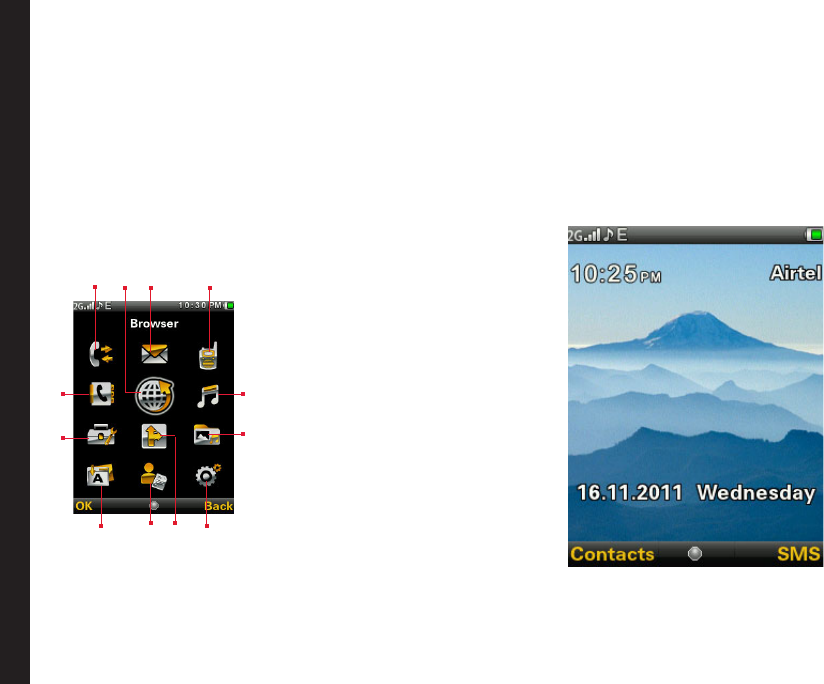
27
Your Sonim XP5520 BOLT
This model is a bar type phone with a single LCD screen.
The graphic eld of the screen is 240 (w) and 320 (h)
pixels. The TFT technology used displays 262K colours.
Main Menu
To access the phone menu, press the Menu key. The
main menu which comprises the following 12 items
appears.
Main Menu Icons
1. CALLS
2. BROWSER
3. MESSAGES
4. PUSH-TO-TALK
5. MULTIMEDIA
6. MY FILES
7. SETTINGS
8. GPS NAVIGATOR
9. SELF SERVE
10. APPLICATIONS
11. TOOLS
12. PHONEBOOK
Home Screen Indicators
The home screen indicators are visible when the phone
is in standby mode. Some icons indicate the status of
certain functions of the phone, for example, the battery
charge indicator, the network status indicator, the date
and time etc. Some icons are displayed only if the
specic service is activated.
1 234
9
5
7
8
12
10
11 6
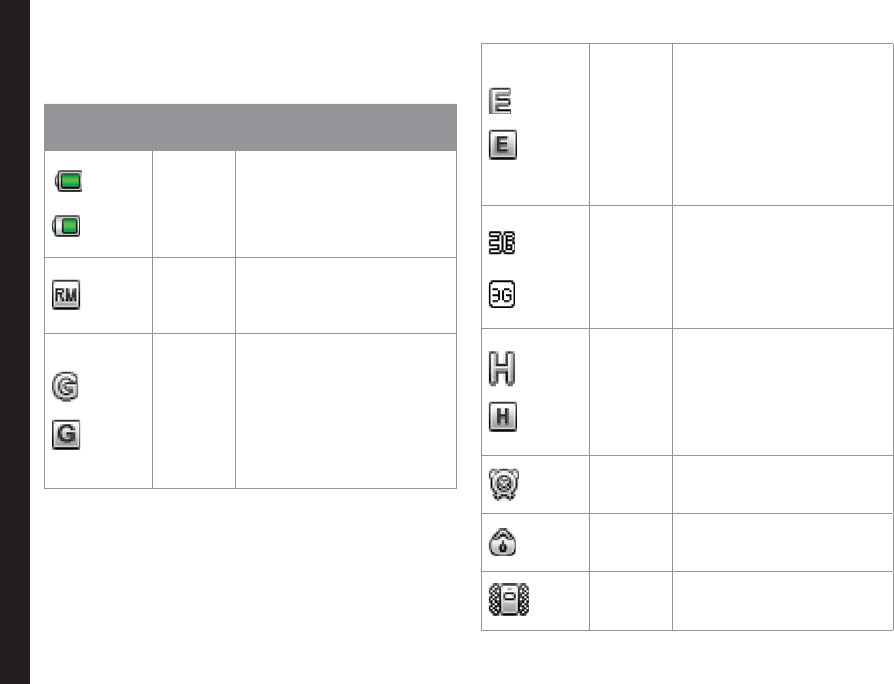
28
Your Sonim XP5520 BOLT
The following table describes the display indicators on
the top bar of the home screen in the Sonim XP5520
phone. These icons depend on the selected theme.
Display
Indicators Name Description
Battery
Full green indicator
represents maximum battery
charge.
Green indicator with empty
space indicates decline in
battery charge.
Roam
ing
This icon is only displayed
when your phone is
registered with a non home
network.
GPRS
G icon indicates that the
phone is attached to 2G
network and GPRS feature
is available in the phone.
Boxed G icon indicates
that the phone is in active
data connection and GPRS
feature is available in the
phone.
EDGE
E icon indicates that the
phone is attached to 2G
network and EDGE feature
is available in the phone.
Boxed E icon indicates
that the phone is in active
data connection and EDGE
feature is available in the
phone.
3G
3G icon indicates that the
phone is attached to 3G
packet network
Boxed 3G icon indicates
that the phone is in active
data connection in 3G
packet network.
HSPA
H icon indicates that the
phone is attached to HSPA
packet network
Boxed 3G icon indicates
that the phone is in active
data connection in HSPA
packet network.
Alarm
Clock
Indicates that the alarm
clock has been set.
Stop
watch
Indicates that the
Stopwatch is running.
Meet
ing
Indicates that the phone is
on meeting mode.
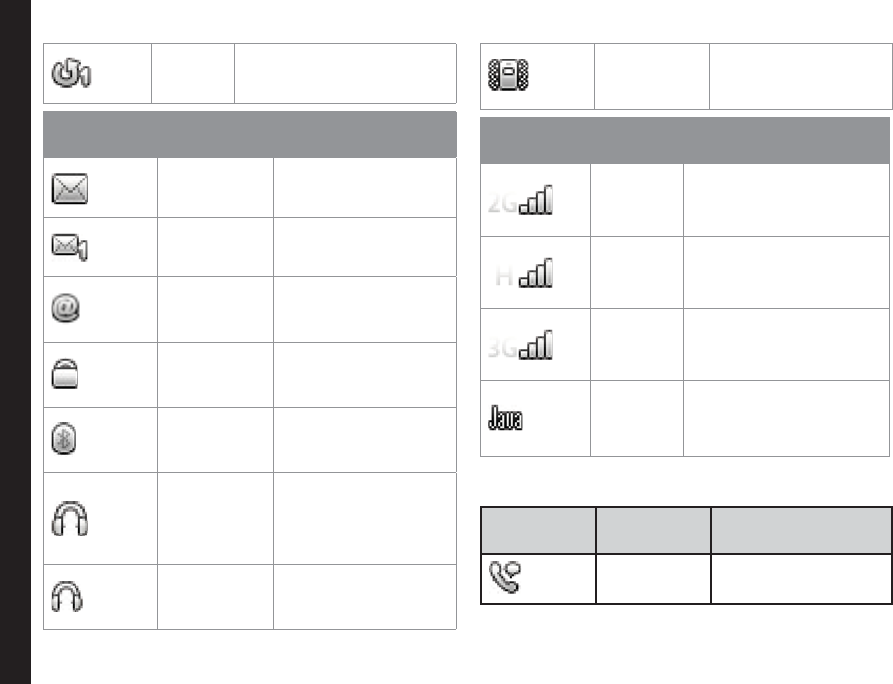
29
Your Sonim XP5520 BOLT
Call
Forward
Indicates that the
call forward function is
enabled.
Display
Indicators Name Description
Unread
Message
Indicates that there are
unread messages in
the inbox.
Voice
Message
Indicates a new voice
message.
Unread
email
Message
Indicates a new email
message.
Keypad Lock Indicates that the
keypad is locked.
Bluetooth
Connec-
tivity
Indicates that
bluetooth is active.
Bluetooth
CarKit/
Headset
Connec-
tivity
Indicates that your
device is paired
and connected to a
carkit or headset with
bluetooth connectivity.
Wired
Headset
Indicates that a wired
headset is connected.
Both
Vibration
and Ringing
Indicates that the
phone performs both
vibration and ringing.
Display
Indicators Name Description
2G
Indicates the signal
strength when registered
to 2G network.
HSPA
Indicates the signal
strength when registered
to HSPA network.
3G
Indicates the signal
strength when registered
to 3G network.
JAVA
Indicates that the Java
application is active
and is available in the
background.
The following table describes the display indicators on
the call screen in the Sonim XP5520 phone:
Display
indicators Name Description
Active Call Indicates an active
call.
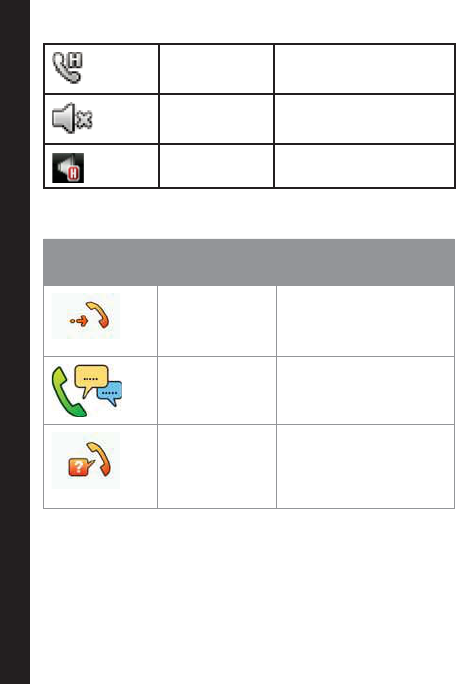
30
Your Sonim XP5520 BOLT
Call on Hold Indicates a call on
hold.
Call on Mute Indicates a call on
mute.
Handsfree
Call
Indicates a handsfree
call.
The following table describes the display indicators on
the home screen in the Sonim XP5520 phone:
Display
Indicators Name Description
Incoming
Call
Indicates an incoming
call.
Outgoing
Call
Indicates an outgoing
call.
Missed Call Indicates a missed
call.
Key Operations without Your SIM Card
Menus Accessible
The following menus can be accessed on the phone
without the SIM card:
• Settings
• Phone settings
• AGPS settings
• Security settings
• Connectivity - Bluetooth
• Phonebook
• My les
• Tools
• Applications
• Multimedia

31
Managing Calls
This section provides information on managing calls.
Dial a Number
1. Use the numeric keys to enter the number and press
.
2. Alternatively you can enter the desired phone
number and select Options > Call.
Dial an International Number
Press and hold the numeric key 0 till the + symbol is
displayed. Enter the Country code, Area code (without
preceding 0) and the phone number and press or
select Options> Call.
Dial a Number via Contacts
You can dial a number directly from Contacts.
To Locate a Phone Number
1. On the home screen, select Contacts. Scroll to the
phone number.
2. Press to dial the number OR select Options >
Call OR press the call key. Press or select End
to disconnect.
Dial a Number via the Call History
The Call History comprises separate lists for All calls,
Missed calls, Dialled calls and Received calls.
1. To access the Call history, press OR select
Menu > Calls > Call history. All the available call
history is displayed.
2. Select a list, scroll to the number and press to
dial the number.
Managing Call History
Contacts within the call history have the following
options:
• View: You can view the details of the call such
as the type of call, name, number, call time, call
duration and times of call.
• Call: You can call the selected contact.
• Send message: You can send an SMS/MMS to the
number. Enter the SMS/MMS and select Options to
view the send options and send it accordingly.
• Save to Phonebook: You can save the number in
Contacts (if it is not saved). This option is displayed
only if the number is not saved.
• Edit before call: You can edit the number before
dialing.
• Delete: You can delete the number from the Call
history.
• Delete all: You can delete all the numbers from the
Call history.
Call Timers
• To view the total time spent on the last call, select
Menu > Calls > Call history > Options > Advanced
> Call timers > Last call.
• To view the total time spent on outgoing calls, select
Menu > Calls > Call history > Options > Advanced
> Call timers > Dialled calls.
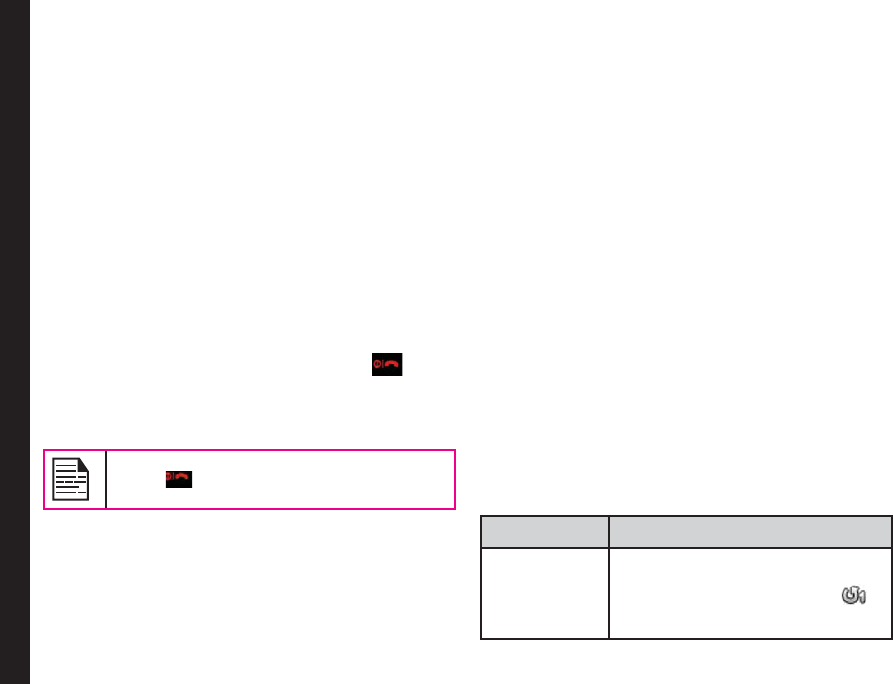
32
Managing Calls
• To view the total time spent on incoming calls, select
Menu > Calls > Call history > Options > Advanced
> Call timers > Received calls.
• To reset the time of all calls, select Menu > Calls >
Call history > Options > Advanced > Call timers >
Reset all.
Call Settings
Auto Answer
Auto answer is enabled only if wired headset is
connected to the phone. When auto answer is activated,
your incoming calls will automatically be answered.
Select Menu > Calls > Call settings > Earphone auto
answer > On.
Any key Answer
When enabled, you can press any key except to
answer a call.
To activate this feature, select Menu > Calls > Call
settings > Any key answer > On.
Long pressing (press and hold) the Power on/
off key during a call will only end the call
and not switch off the phone.
Call Waiting
When call waiting is enabled and the phone is in
conversation, the incoming number is displayed when
you receive a call.
1. To enable this facility, select Menu > Calls > Call
settings > Call waiting > Activate.
2. To cancel this facility, select Menu > Calls > Call
settings > Call waiting > Deactivate. You will not
be prompted when you receive an incoming call
while your phone is busy. The caller will receive a
busy signal.
3. To verify the call waiting status, select Menu > Calls
> Call settings > Call waiting > Query Status.
Caller ID
When you make a call, you can select whether or not to
display your id to the receiver.
• Select Menu > calls > Call settings > Caller ID >
Set by network, to allow the network operator to
define the Caller ID settings.
• Select Menu > Calls > Call settings > Caller ID >
Hide ID, to hide your id from the receiver.
• Select Menu > Calls > Call settings > Caller ID >
Send ID, to display the ID to the receiver.
Call Forwarding
You can forward your incoming calls to a number in
the Contacts or a new number, provided your network
operator supports this service. To access call forward
settings, select Menu > Calls > Call settings > Call
Forward. The Call forward options are mentioned below:
Options Function
Forward all
voice calls
Forward all incoming calls to a
pre-designated number. When All
calls divert is enabled, the icon
is displayed at the top of the screen
when the phone is in standby mode.
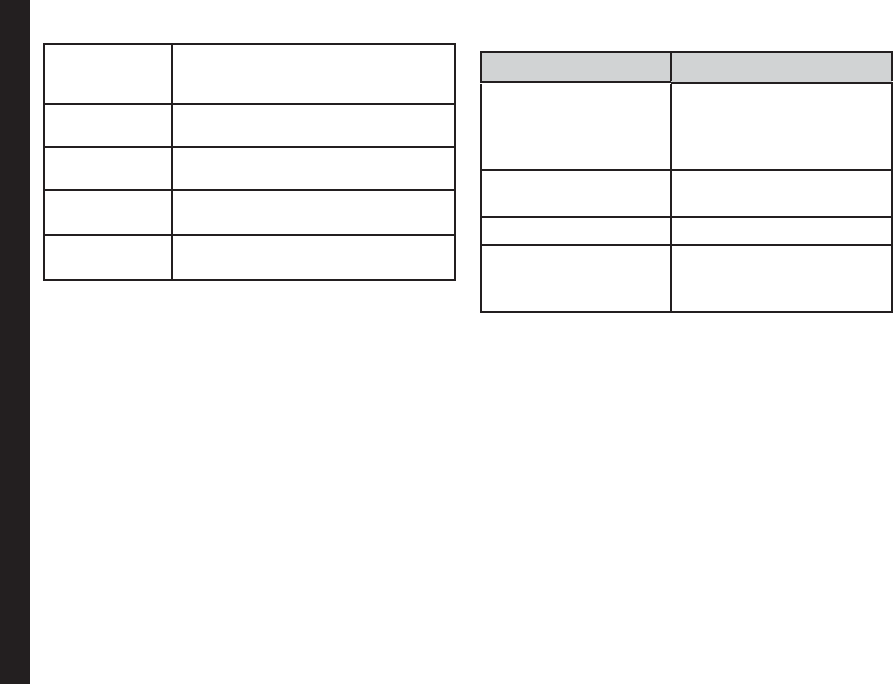
33
Managing Calls
Forward if
unreachable
Forward calls when your phone is
switched off or is out of coverage
area.
Forward if no
answer
Forward calls when you do not
answer incoming calls.
Forward if
busy
Forward calls when your phone is
busy.
Forward all
data calls
Forward all data calls when your
phone is in roaming.
Cancel all
forwards
Deactivates the call forward option.
Call Barring
You can set the Call barring facility for all incoming and
outgoing calls, international calls, local and home only
calls.
1. To set call barring settings, select Menu > Calls >
Call settings > Call barring > select the required
call barring option.
2. Enter the call barring password. Contact your
network provider for call barring password. This
password will be sent to the network for verication.
The Call barring options are:
Options Function
Outgoing calls All voice calls or
International voice calls or
International voice calls
except home.
Incoming calls All voice calls or voice calls
when roaming
Cancel all Deactivates call barring.
Change barring
password
You can change the barring
password by entering a new
password.
Fixed Number Dialing
A set of numbers are stored in the SIM as xed numbers
and only those numbers can be dialed from the phone.
You can make calls from contacts or dial the number if
the selected number is stored in xed numbers list. You
can however receive calls from any number. You cannot
make calls to the numbers which are not stored in xed
numbers list.
1. Select Menu > Calls > Call settings > Fixed Dial >
Mode > On. Enter the PIN2 to activate xed number
dialing.
2. Select Fixed Dial List to add a new number and to
view the numbers present in the list.
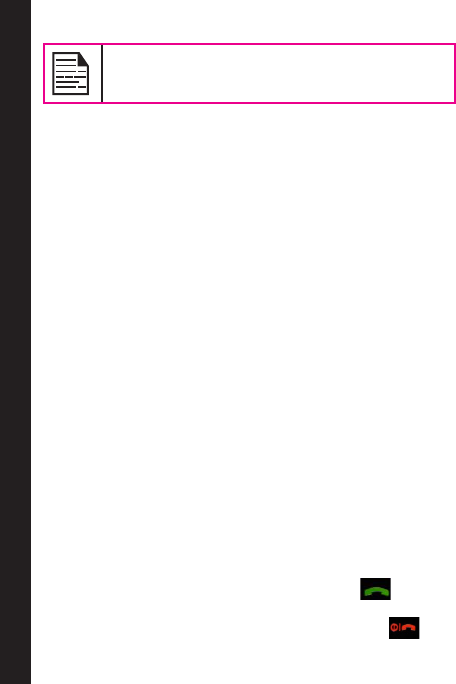
34
Managing Calls
Contact your service provider, for PIN2.
Advanced Settings
Auto Redial
When auto redial is enabled, your phone will
automatically redial within a set interval, if a call does not
connect.
1. To enable this function select Menu > Calls > Call
settings > Advance settings > Auto redial > On.
2. If the attempt to call is not successful, you will be
prompted with the message Auto redial? Select OK
to redial. Select Back to return to home screen.
Call Time Display
You can select Menu > Calls > Call settings >
Advanced settings > Call time display > On to activate
the call time display.
Call Time Reminder
When enabled, you receive a beep/tone as prompt at
the set time period during a conversation. Select Menu
> Calls > Call settings > Advance settings > Call time
reminder > On. Select OK and set the reminder time.
You can set the reminder time between 30 to 60 seconds.
Receive a Call
1. To receive a call, press the Accept key OR
press Left Selection key. Select Accept.
2. To reject a call press the Power on/off key OR
press Right Selection key. Select Reject.
3. To receive another call while you are already
speaking, enable the call waiting feature for calls.
Select Menu > Calls > Call settings > Call waiting
> Activate.
Record a Call
1. While making a call or receiving a call, select
Options > Sound recorder.
2. Select Stop to stop the recording. Save the record.
3. The recorded le is saved in the location My files >
Phone (or Memory card) > Audio.
Depending on the settings, the storage location can be
phone or Memory card.

35
Managing Phone Settings
This section provides information on the various settings
for the phone. To access, select Menu > Settings >
Phone settings.
Time and Date Settings
You can set and display the date and time on the phone.
You can also select the display format.
• Set home city: To set the home city, select Phone
settings > Time and date > Set home city.
• Set time/date: To set the date and time, select
Phone settings > Time and date > Set time/date.
• Set format: To set date and time format, select
Phone settings > Time and date > Set format.
• The date formats supported are DD MM YYYY ,
MM DD YYYY, YYYY MM DD with the different
date separators.
• The time formats supported are 24 hr. and 12
hr.
• Update with time zone: To update the time
automatically, when the time zone (home city) is
changed, select Phone settings > Time and date >
Update with time zone > select On.
• Auto Update time: To synchronize the time and
date with the network details, select Phone settings
> Time and date > Auto update time > On. This
feature requires network support.
Schedule Power On/Off Settings
To enable this feature, select Phone settings > Schedule
Power on/off > Select the time > Status > Enable and
Power on/of. Select the time after which the phone
should be automatically switched on. Select OK. Select
Disable to disable this feature.
Language Settings
You can change the phone’s interaction language by
selecting your preferred language. To set the language
based on the SIM card, select Phone settings >
Language > Automatic. All the menu items, user
feedback messages and text entry language are
displayed in the language set based on the SIM card.
Display Settings
You can activate and modify the display settings. Select
Phone settings > Display.
1. Wallpaper: Allows you to set the background screen
display using the embedded pictures available in
your phone or from your own pictures that you have
downloaded on to your phone or memory card. The
selected wallpaper is displayed on the home screen.
2. Screensaver: Select this to make the screen saver
appear on the home screen. User can select the
screensaver image.
3. Show date and time: Select this to display date and
time on the home screen.
4. Themes: Allows you to set the color theme and
icons for the main menu and other screens. There
are two themes available. Select Theme 1 or Theme
2. Select Options to activate the selected theme,
update the theme automatically after set time
period, and set the theme display order.
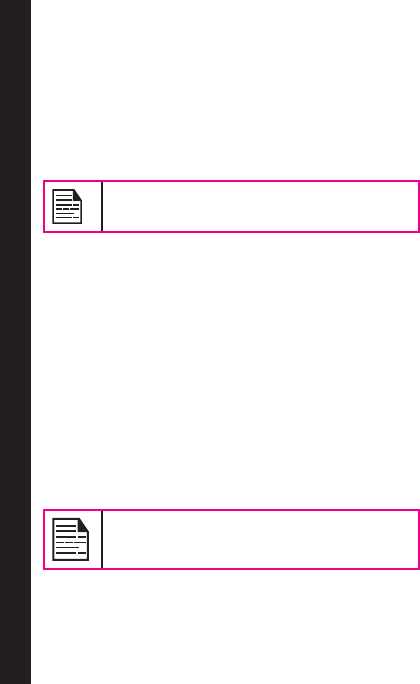
36
Managing Phone Settings
Customizing Dedicated Keys
Dedicated keys are the navigation keys set to access
specic functions. To assign specic function to the keys,
select Menu > Settings > Phone settings > Dedicated
key > Select a key > press center key > select the new
function > select OK. You can also change the specic
function previously assigned to the key.
When pre-dened functions are activated,
speed dial numbers will be disabled.
Managing Speed Dial Numbers
This option enables you to dial a number quickly via a
shortcut.
1. Select Menu > Settings > Phone settings >
Dedicated key > Speed dial. Select Status > On.
The shortcut is set.
2. To add a new contact, select Set numbers. Select
the number key (from 2 to 9) to which you want to
assign the speed dial. Select the contact from the
phonebook and save. The Speed dial is set.
3. To make a call, press and hold the shortcut
designated number key for Speed dial from home
screen.
When speed dial is activated, pre-dened
functions set using Dedicated keys will be
disabled.
Power Saving Settings
You can set the backlight level and duration. Select Menu
> Settings > Phone settings > Power saving > LCD
backlight. Select the brightness level for the backlight
of the screen. The screen display is active for the period
chosen by you. The screen display active time can be
selected between 5-60 sec.
Auto Keypad Lock
To lock the keypad automatically, when the phone is in
idle state, select Menu > Settings > Phone settings
> Auto keypad lock. Select the time after which the
keypad will be automatically locked. Select None to
disable this feature.
Connecting to Hearing Aid
To enable coupling with a hearing aid device operating
in telecoil/microphone mode, select Menu > Settings
> Phone settings > Hearing aid > On. Once HAC is
enabled, the “HAC” symbol is displayed in the indicator
bar. Select Off to disable this feature.
HAC Rating
The FCC has created a rating system for cellular phones
regarding their HAC-related performance. This rating
helps consumers with hearing disabilities to nd phones
that will work well with their hearing aid devices. The
HAC rating and measurement procedure are described
in the American National Standards Institute (ANSI)
C63.19:2007.
ANSI C63.19 contains two rating standards: an “M” rating
from 1 to 4 for hearing aids operating in microphone
mode, and a “T” rating from 1 to 4 for hearing aids
operating in telecoil mode.
M-Rating stands for Microphone rating and indicates
the amount of reduction of RF interference between the
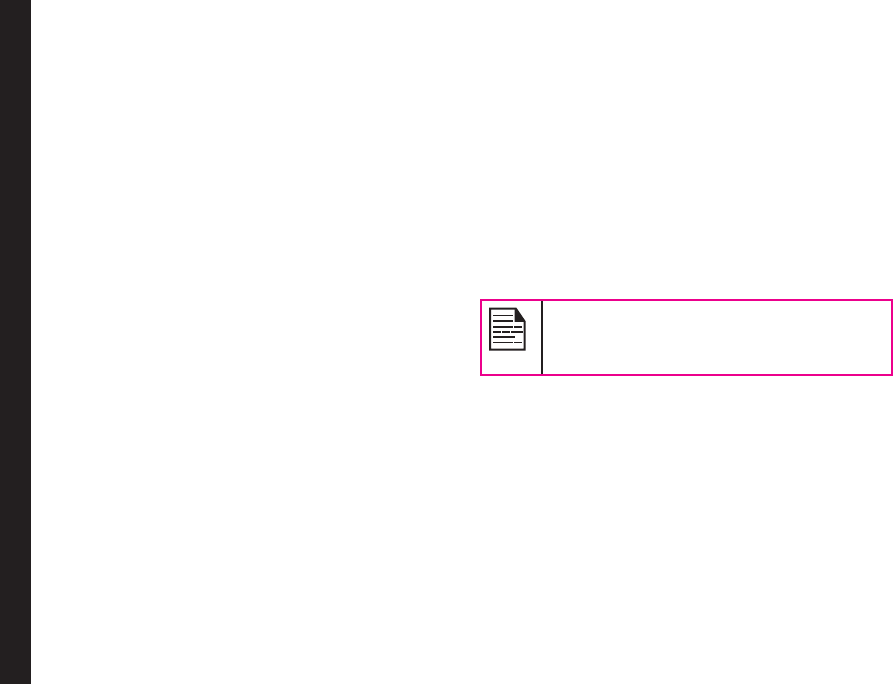
37
Managing Network Settings
telephone and the hearing aid in acoustic coupling mode
(also called microphone mode).
Phones rated M3 or M4 meet FCC requirements and
generate less interference to hearing devices set in
microphone mode.T-Rating stands for Telecoil rating and
represents inductive coupling with hearing aids that are
operating in telecoil mode. A telecoil is a small piece of
tightly wrapped wire, built into some hearing aids. While
the microphone of a hearing aid picks up all sounds, the
telecoil will only pick up an electromagnetic signal from
the telephone. Thus, users of telecoil-equipped hearing
aids are able to communicate over the telephone without
the amplication of unwanted background noise.
Phones rated T3 or T4 meet FCC requirements and
generate less interference to hearing devices set in
telecoil mode.
A combination of M-rating and T-rating denes the
nal HAC rating and is a deciding factor in selecting
cellular phones for people with hearing problems. A HAC
compliant phone could be rated:
• M3/T3
• M3/T4
• M4/T3
• M4/T4
These ratings assist hearing device users to nd
phones that are compatible with their hearing devices.
Ratings are shown on the phone’s box or label. The
ratings are not guaranteed for suitability. The results
vary depending on the individual’s hearing loss and the
immunity characteristics of the used hearing device, i.e.
its resistance to interference. The best way to evaluate
the suitability of the phone is to try it with the intended
hearing aid device.
Sonim XP5520-A-R1 has been tested for hearing aid
device compatibility and complies with the Federal
Communications Commission (FCC) requirements. Sonim
XP5520-A-R1 is rated M3/T4.
HAC Settings
To enable coupling with a hearing aid device operating in
telecoil mode, select Menu > Settings > Phone Settings
> Hearing Aid > On. Once HAC is enabled, the “HAC”
symbol is displayed on the Home screen. Select Off to
disable this feature.
Menu > Settings > Phone Settings > Hearing Aid >
Off is also the setting providing acoustics coupling with
hearing aid device operating in microphone mode.
While using the mobile phone for voice calls
with hearing aid, slightly adjust the position
of the phone against the ear to reduce the
interference and to give better voice quality.
Network Selection
To modify the network access settings, select Menu >
Settings > Network settings. The following network
settings are displayed:
You can select your network, specify the network
account, and indicate whether GPRS is required at all
times.
• New search: Search the network for the phone
to connect when you are selecting the network
manually.
• Select Network: Select the network
automatically or you can do it manually.

38
• Selection Mode: Select Automatic to set the
phone to automatically select a cellular network
available in your area, or select Manual to set
the network manually. If manual mode is set,
the user has to invoke Select Network to do
network selection.
Preferences
You can view the list of preferred networks and update it.
This network list is used when the phone is in roaming.
Select one of the following Options:
• Add from list - Add from a list of existing network.
• New - Add a new network.
• Change Priority - Change the network access
priority order.
• Delete - Delete a network from the preferred list.
Data Connection
To set registration preferences for accessing data
connection, select one of the following options:
• Always - Register with the data connection,
continuously.
• When needed - Register only when data transfer is
required.
Data Account
You can set the network account and view the data
connection information.
You can add, view, edit and delete the accounts. You can
edit the following information in the accounts: Account
name, APN, User name, Password, authentication type,
home page, proxy settings, Primary DNS, and Secondary
DNS. Make the changes and select OK. Then Add new
packet data account’ will pop up, select Yes . Refer
“WAP Browser” on page 65 for further information.
Service Selection
You can view and set the required type of network.
• GSM: Register to GSM network only.
• WCDMA: Register to 3G network only. If 3G network
is not available, the phone proceeds to no signal
condition, even if GSM coverage is present.
• Automatic: This is a recommended option. Select
this to register to 3G network, if available. If the 3G
network is not available, the phone registers to the
GSM network. Once the phone is registered to 3G
network, ‘3G’ icon is displayed on the home screen
of the phone.
A-GPS Settings
Your handset is equipped with a GPS receiver, that
supports A-GPS (Assisted GPS) functionality. This helps
to calculate your current location. When an user accesses
an application that requires GPS, then the receiver is
turned on automatically. After the application is closed, it
is turned off automatically.
A GPS receiver calculates its current location by
monitoring broadcast signals from GPS satellites. Hence
it is important that the handset is exposed to the sky
A-GPS feature helps the GPS receiver to acquire certain
information through data connection and/or network
messages. This information is used during the position
Managing Network Settings

39
Managing Network Settings
calculation process. This signicantly increases the ability
to calculate position at low signals. It also speeds up
the time required to calculate the position. Please note
that some A-GPS features could be network dependent.
In some cases, A-GPS uses external data connectivity,
which may result in network charges.
To congure the A-GPS on your phone, do the following:
1. Select Menu > Settings > AGPS settings.
2. Select AGPS > On.
3. Select AGPS proles and then press Select. In
AGPS proles, select the required prole and click
Options > Activate. You can also select Edit. Enter
the name, address, data account, port, and TLS as
provided by the service provider or operator.
4. Select Query Location > On, to enable it.
5. Select OK to save the settings.

40
Managing Security Settings
To prevent unauthorized use of your phone, you can set
the PIN protection and keypad lock.
PIN Protection
To enable PIN protection, select Menu > Settings >
Security settings > PIN protection > On. Enter the
password.
Change PIN
To change the PIN protection password, select Change
PIN.
Change PIN2
To change any security related password, select Change
PIN2 and change the particular password.
Phone Lock Password
The default password for phonelock is 1234. To change
the phonelock password, Menu > Settings > Security
settings > Change phone lock password. Enter the
password.
Safeguard
You can set a password and prevent unauthorized usage
of messages, phonebook, call history and my les menu
of your phone. To use this application, do the following:
1. Select Menu > Settings > Security Settings >
Safeguard > Safeguard > On.
2. Enter the input password. The default password is
1234.
3. Select Activation and enter the password. Select
the required menu that needs to be password
protected.
4. Select Done and then save. The selected menu is
password protected.
Certicate Manager
You can view, edit key usages, and delete authorized
certicates and user certicates.
Restore Factory Settings
Select to reset the settings to the original factory settings.
Please note that this can remove changes you have made
to your settings.
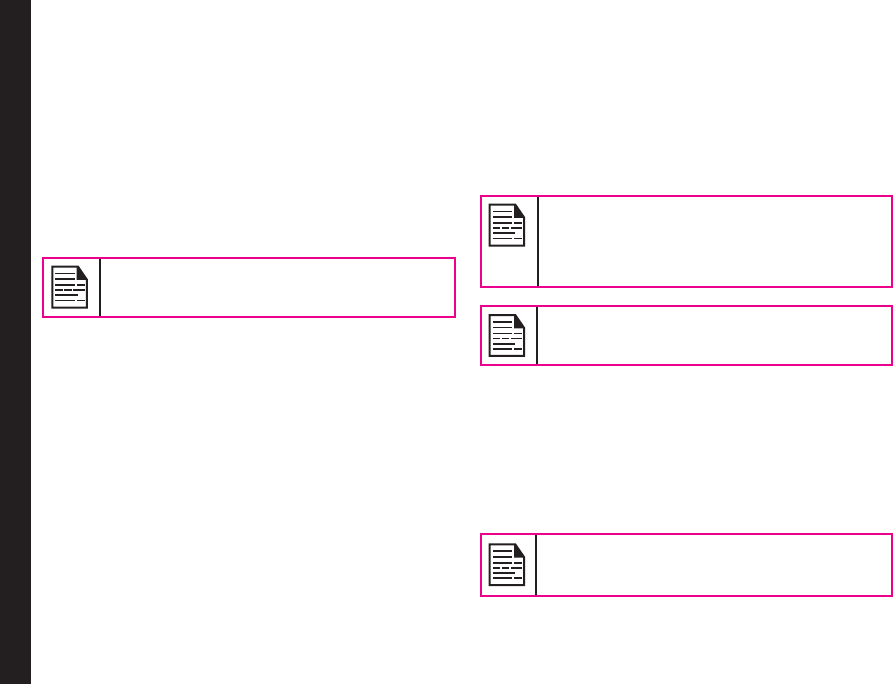
41
Managing Connectivity
You can access Bluetooth and data accounts.
Bluetooth
Bluetooth is a wireless connection that enables to
connect devices within short range, to exchange
information.
The Sonim XP5520 is compliant with Bluetooth
specication BT 3.0 supporting the following proles:
SPP, SAP, HFP, HSP, A2DP, AVRCP, DUN, PBAP, OPP, and
FTP. This device can send images and audio les using
Bluetooth connection.
There may be restrictions on using Bluetooth
technology in some locations. Check with your
local authorities or service providers.
Activate Bluetooth
Select Menu > Settings > Connectivity > Bluetooth >
Power > On. Use the menu key to toggle between on
and off. When Bluetooth is activated, the Bluetooth icon
is displayed on the home screen.
Deactivate Bluetooth
Select Menu > Settings > Connectivity > Bluetooth >
Power > Off. Use the menu key to toggle between on
and off.
Pairing Devices
1. Select Menu > Settings > Connectivity >
Bluetooth > Search new device.
2. Select the device of your choice. Select Pair.
3. Enter the passcode (for example, 0000) in the Enter
passcode screen. The same passcode must be
entered for the other device also.
4. Select OK.
5. When the other device accepts your request the
message Pairing Done is displayed on the screen.
6. When the other device rejects your request the
message Pairing Failed is displayed on the screen.
Prior to pairing the devices, ensure that the
visibility settings for the pairing devices are
activated. To activate the visibility settings,
select Menu > Settings > Connectivity >
Bluetooth > Settings > Visibility > On.
Do not pair with an unknown device for
security reasons.
Connecting a Bluetooth Headset
You can connect a bluetooth headset after pairing it with
your phone.
1. Select Menu > Settings > Connectivity >
Bluetooth > My device.
2. Select the paired Bluetooth headset.
3. Select Options > Connect.
For more details, refer the user manual of the
Bluetooth headset.
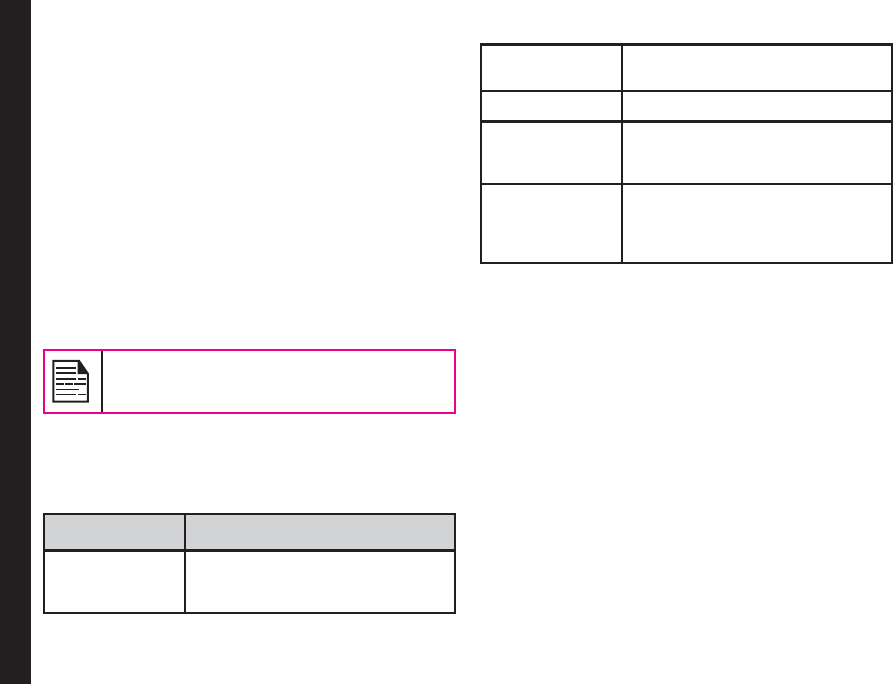
42
Rename Paired Device
1. Select Menu > Settings > Connectivity >
Bluetooth > My device.
2. Select the paired device.
3. Select Options > Rename.
4. Enter the new name.
5. Select OK.
Delete Paired Device
1. Select Menu > Settings > Connectivity >
Bluetooth > My device.
2. Select the paired device.
3. Select Options > Delete.
If you cancel the pairing with a device that
is connected, pairing is removed and the
connection is switched off immediately.
Bluetooth Settings
1. Select Menu > Settings > Connectivity >
Bluetooth > Settings.
2. Edit the following details.
Options
Description
Visibility Select On to show your presence
to other devices. Select Off to hide
your presence from other devices.
My name Select this option to change the
name of your device.
Storage Select the storage location.
Remote SIM
Mode
Select this option to access the
SIM card inserted in your phone
using Bluetooth car kit.
Sharing
Permissions
Select this option to provide full
control or read-only permission to
the other device connected to your
device.
About
You can view the device name, address and other
support services.
Sending Data via Bluetooth
You can transfer les to another compatible device.
1. Select Menu > My files.
2. To send an image le, select Images > select the le
OR To send an audio le, select Audio > select the
le OR To send any other le, select Others > select
the le.
3. Select Options > Send > via Bluetooth.
4. Select the paired device to which you want to send
the le.
Managing Connectivity
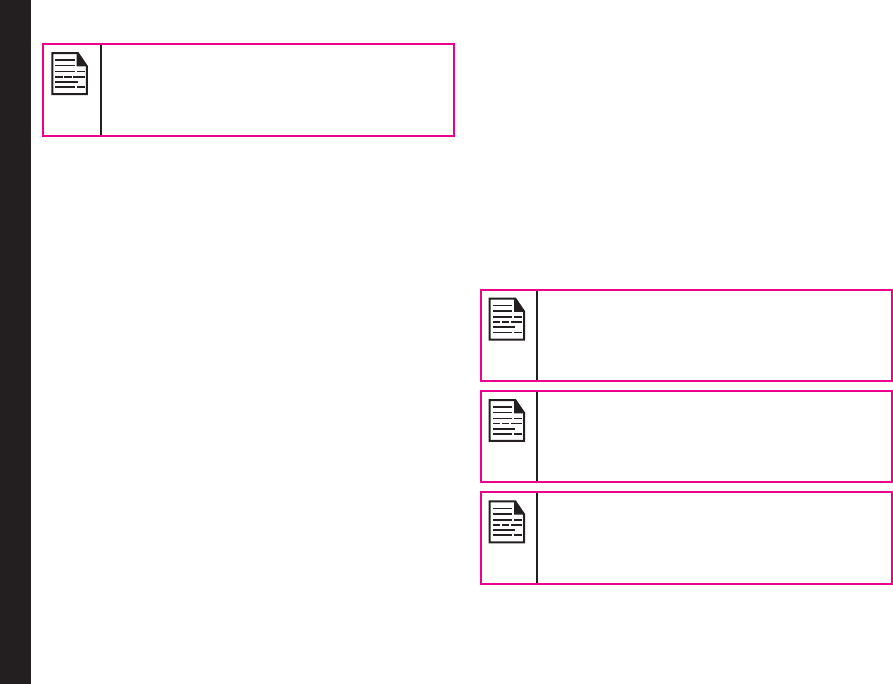
43
Managing Connectivity
My devices screen displays the paired
devices. To send a data to an unpaired
device, select Search new device. Select
the unpaired device of your choice. Enter the
passcode when you are asked to enter.
5. When the other device accepts your le, the
message Done is displayed on the screen.
6. When the other device rejects the le, the message
Unfinished is displayed on the screen.
Receiving Data via Bluetooth
To receive data using Bluetooth, your device should be
Bluetooth activated and must be visible to other devices.
1. When you receive a data, you are asked if you want
to accept it.
2. Select Accept to receive data OR select Reject to
refuse the data.
3. If you accept, the data will be stored in My files >
Images or Audio or Others.
Data Account
You can set the Network account and view the data
connection information.
To set the data account, select Menu > Settings >
Connectivity > Data account and create a new data
account.
You can create, edit and delete the accounts. You can
edit the following information in the accounts: Account
name, APN, User name, Password and Authority type,
Primary DNS and Secondary DNS. Make the changes
and select OK. Then Add new packet data account’ will
pop up, select Yes .
USB Function
Phone can be connected to PC as a Mass storage
using USB cable. When the phone is connected to the
computer via a USB cable, the following two options are
displayed:
• Mass storage: Select this to use the USB cable as
mass storage device to transfer and synchronize
data between the Sonim XP5520 phone and your
computer.
• COM port: Select this to use the phone with
PC-Sync software.
When the phone is connected to the computer
via USB cable, you can select only to charge
the phone by pressing the Back button. You
need not select the Mass storage or COM port
option.
When the phone is connected to the computer
via USB cable and the memory Card is also
present in the phone, the memory card and the
phone memory are displayed as two separate
drives in the computer.
When the phone is connected to the computer
as mass storage, you cannot access the My
les menu in the phone. To access the My
les menu, disconnect the phone from the
computer and reconnect in COM port mode.
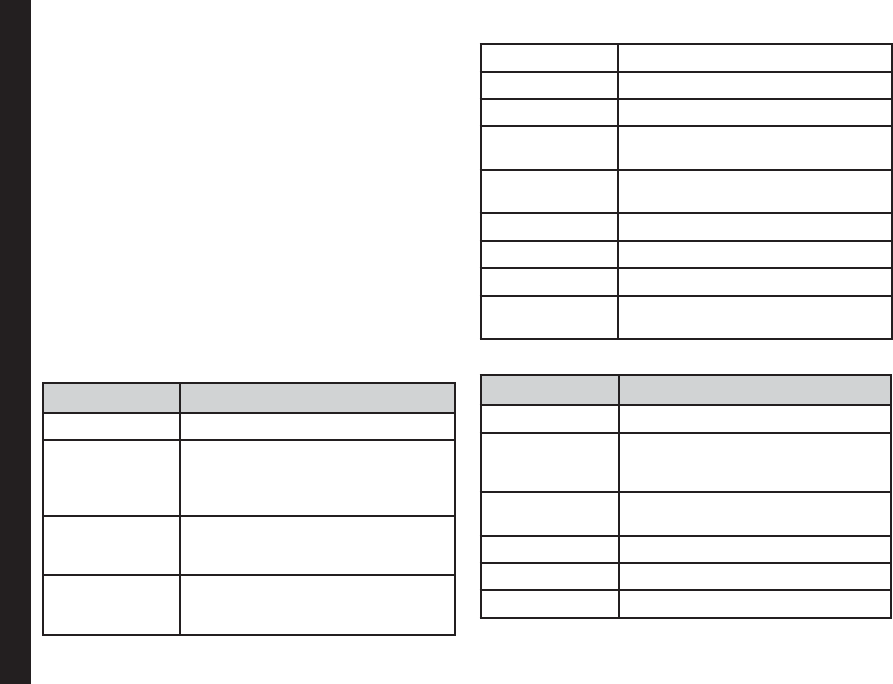
44
Managing Your Files
Using the My files menu, you can store and manage
audio, video les, image les, .jar les, .jad les and
.txt les. You can preview the les, view their details
and delete les. The internal storage capacity is
approximately 40 MB.
1. To view your les select Menu > My files > select
phone/memory card > Options > Open.
2. Scroll to a category and select one of the categories
: Audio, Images, Java, Others or Videos and select
OK.
3. For pictures, select the images that you would have
saved.
4. For sounds, select the audio files that you would
have saved.
5. Scroll to le from the displayed list and select
Options to display further options.
For an image le, the following options are present.
Options Function
View View the image in full screen mode.
Edit Resize the image or edit the
image to add photo effects, adjust
contrast and brightness, ip and
rotate the images.
Send Send the image to any phone as a
multimedia message, E-mail or via
Bluetooth.
Use as Use the image as wallpaper, screen
saver, power On/Off display and
caller picture.
New folder Create a new folder.
Rename Rename the image.
Delete Delete the image.
Sort by Sort the images by name, type,
time, and size.
Mark several Select all the images or select one
by one.
Copy Copy a le to different folder.
Move Move a le to different folder.
Delete all files Delete all the images.
Details View the creation date, size, and
copyright details of the le.
For an audio le, the following options are present.
Options Function
Play Play the audio le.
Send Send the audio le to any phone as
multimedia message, as an E-mail,
or via Bluetooth.
Use as Use the audio as ring tone for
incoming call.
New folder Create a new folder.
Rename Rename a le.
Delete Delete the audio le.
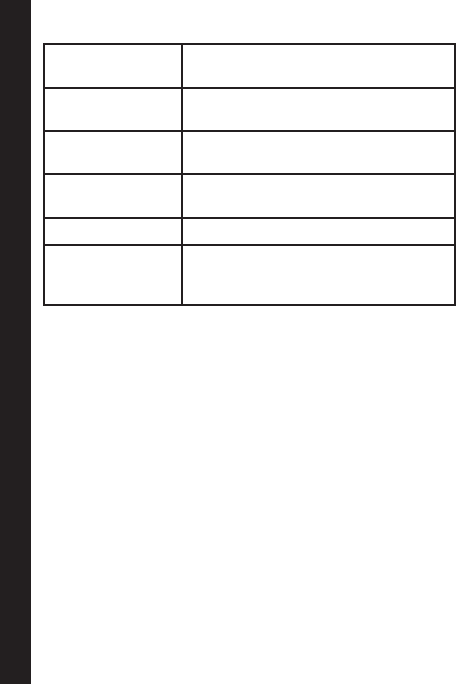
45
Managing Your Files
Sort by Sort the audio les by name, type,
time, or size.
Mark several Select all the audio les or select
one by one.
Copy You can copy a le to different
folder.
Move You can move a le to different
folder.
Delete all files You can delete all the audio les.
Details You can view the creation date,
size, and copyright details of the
le.
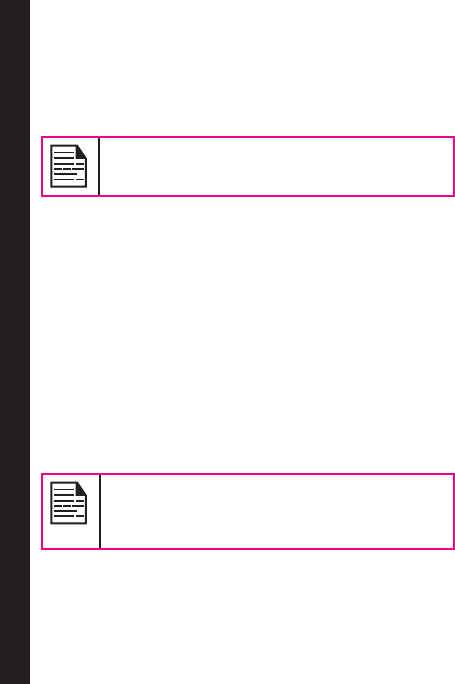
46
Managing Contacts
You can use the phonebook to maintain phone numbers
of your contacts. This feature enables you to add, delete,
dial phone numbers, send SMS and MMS messages. To
access the contacts, select Menu > Phonebook. The
contacts are displayed.
You can also use the volume keys to scroll
through the contacts.
Add a New Contact
• To add a new contact, select Menu > Phonebook >
Options > Add new contact. Press the menu key.
Enter the name and phone number, select SIM or
phone to save and and select Save.
• Alternatively, you can directly enter a number and
select Options > Save to Phonebook > Add new
contact. Enter the name of the contact, select SIM
or phone to save and select Save.
• You can also add a contact from Call history menu
(refer “Managing Call History” on page 31) and Write
message menu (refer “Write Message” on page 51).
The new number is updated in the Contacts list.
If Phone is selected as the storage location,
then the user can add many details apart from
the name and phone number. The user can
add a maximum of 1000 contacts.
View the Contact Details
On the home screen, select Menu > Phonebook. Select
the contact. Select Options > View or press the Menu
key.
Sending a Message from Contacts
You can send SMS and MMS messages to the contacts.
Sending SMS
1. On the home screen, select Menu > Phonebook.
Select the contact.
2. Select Options > Send message.
3. Enter the message and select Options > Send to.
Select additional recipients, if any.
4. Select Options > Send, to send the message.
Sending MMS
1. On the home screen, select Menu > Phonebook.
Select the contact.
2. Select Options > Send message > Options
> Switch to MMS or select Options > Send
Message.
3. Enter the message and select Options. You can
add the required picture, sound, video, subject, and
slides to the message. Select the required file.
4. Select Options > Send to. Select additional
recipients, if any.
5. Select Options > Send, to send the message.
Dialing a Number from Contacts
On the home screen, select Menu > Phonebook. Select
the contact. Select Options > Call or press the call key.

47
Managing Contacts
Edit the Contact Details
You can enter or edit the contact details. On the home
screen, select Menu > Phonebook. Select the contact.
Select Options > Edit.
Delete Contact
To delete a contact, select Menu > Phonebook. Select
the contact and select Options > Delete > A message
appears Delete? Select Yes to delete.
Copy Numbers between Phone and SIM
• To copy a selected number from SIM card to Phone
memory, select Menu > Phonebook > Options>
Copy > To phone. Select OK.
• To copy a selected number from Phone memory to
SIM card, select Menu > Phonebook > Options >
Copy > To SIM. Select OK.
• To copy a selected number from SIM card or Phone
memory to a le, select Menu > Phonebook >
Options > Copy > To file. Select OK.
Move Numbers between Phone and SIM
To move a selected number from SIM card to Phone
memory or Phone memory to SIM card, select Menu
> Phonebook > Options > Move. Select OK. Moved
records are deleted from the source location.
When the contact details are moved from
Phone to SIM, only the contact name and
mobile number is saved in the SIM card.
Sending Contact
You can send contact information by SMS, MMS, e-mail
or Bluetooth.
Send Contact by SMS
1. Select Menu > Phonebook. Select the contact.
2. Select Options > Send business card > As text
message. Select additional recipients, if any.
3. Select Options > Send to send the contact
information.
Send Contact by MMS
1. Select Menu > Phonebook. Select the contact.
2. Select Options> Send business card > As MMS.
3. Enter the message and select Options. You can
add the required picture, sound, video, subject, and
slides to the message. Select the required file.
4. Select Options > Send to. Select additional
recipients, if any.
5. Select Options > Send, to send the contact
information.
Send Contact by e-mail
1. Select Menu > Phonebook. Select the contact.
2. Select Options > Send business card > As Email.
Enter the following details:
• To: You can enter the recipient’s e-mail
address.
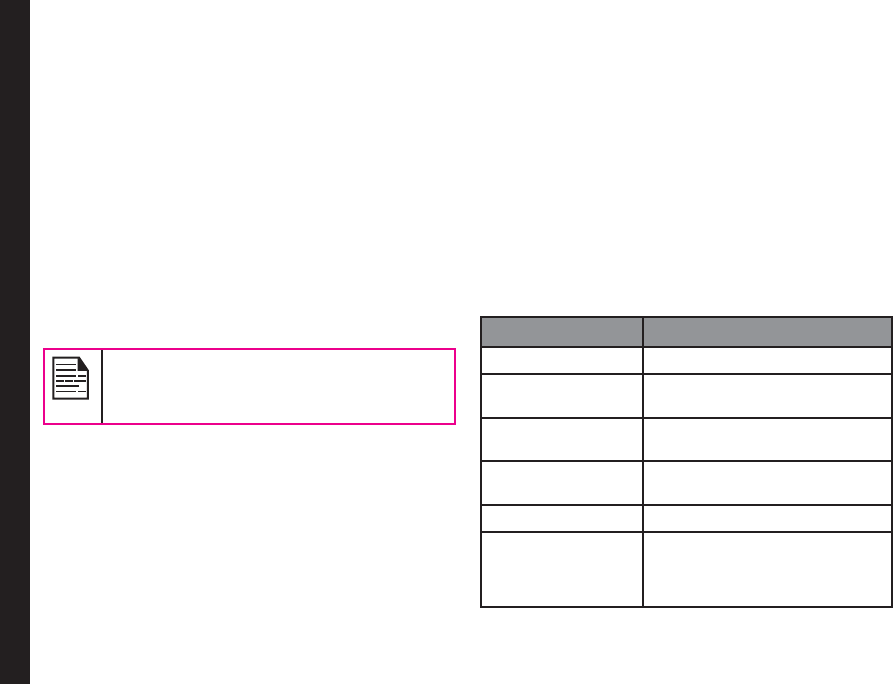
48
Managing Contacts
• CC: You can enter the e-mail address of the
recipient, to whom a copy of the e-mail has to
be sent.
• BCC: You can enter the e-mail address of the
recipient, to whom a blind copy of the e-mail
has to be sent.
• Subject: You can enter the subject of the
e-mail.
• Attachments: By default the selected contact
details are attached. You can also include other
attachments, if any.
• Priority: You can set the priority for the
message.
3. Select Done > A message appears displaying
the size of the message > Select Yes to send the
message.
You will not be able to send the contact by
e-mail, if e-mail account is not congured.
To congure the e-mail account, refer Refer
“Configuring Email Accounts” on page 55.
Send Contact by Bluetooth
1. Select Menu > Phonebook. Select the contact.
2. Select Options > Send business card > Via
Bluetooth.
3. If Bluetooth is not on, the user will get a prompt to
turn it on.
4. Select the paired device to which you want to send
the name card.
5. If the device is not paired, select Search new
device and then select the device.
6. When the other device accepts the contact, Done
message will be displayed.
Selecting Multiple Contacts
To select multiple contacts, select Menu > Phonebook >
Options > Mark several. To select the contacts, scroll to
the required contacts and do one of the following:
• Select Options > Mark.
• Press the menu key.
• Select Options > Mark all to select all the contacts
in the phonebook.Once the contacts are marked,
the following options are displayed:
Options Function
Unmark Unmark the selected contact.
Send message Send an SMS/MMS message to
all the marked contacts.
Send business
card
Send a business card to the
marked contacts
Export UDX file Export the contact details of the
marked contacts as UDX le.
Delete marked Delete all the selected contacts.
Mark all Select all the contacts in the
phonebook. This option is
displayed only if all the contacts
are not selected.
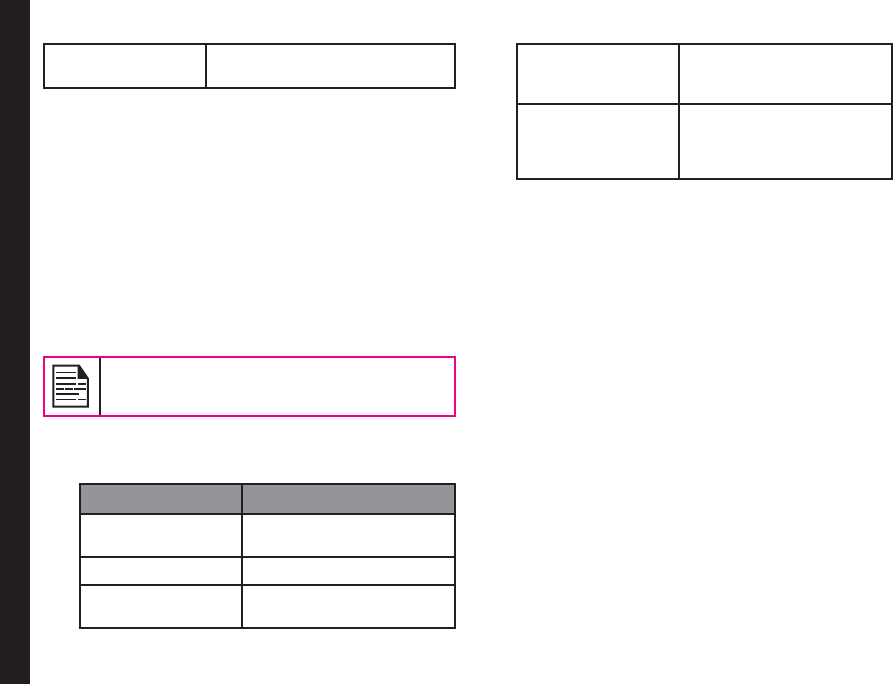
49
Unmark all Unmark all the selected
contacts.
Caller Groups
You can create a new group, add a new contact to the
group, and manage the groups.
• To create a new group, select Menu > Phonebook
> Options > Caller groups > Add new group. You
can assign a name, ringtone and picture for the
group.
• To add a new contact in a group, select Menu >
Phonebook. Select the contact. Select Options >
Caller groups. Select a group. Select Options >
View members > Options > Add. The phonebook
is displayed. Select the phone numbers to be added
to the group.
Only the contacts stored in phone memory can
be added to the group.
• To manage a group, select Menu > Phonebook >
Options > Caller groups. Select a group and then
select Options. The following options are displayed.
Options Function
View members You can view the contacts
in the group.
Delete You can delete the group.
Delete all You can delete all the
groups.
Send message You can send an SMS/
MMS message to the
contacts in the group.
Group settings You can rename the group,
assign a ring tone to the
group, and add a picture to
the group.
Phonebook Settings
To view or dene settings for your phonebook, select
Menu > Phonebook > Options > Phonebook settings.
• Preferred storage: You can select either SIM or
Phone or both as the default memory location to
store the contacts.
• My number: You can manage your own information.
The following sub-menus are present.
• Edit my number: Enter your name and other
personal details such as Mobile number, Home
number, Company name, Email address, Ofce
number, and Fax number. Select OK and Save.
• Send my number: You can send your
information to any number via SMS, MMS,
e-mail and bluetooth.
• Delete my Number: Delete the contact
information.
• Extra Numbers: You can view some special
purpose phone numbers. The following sub-menus
are present.
• Owner numbers: Contains the number and
name of the owner. You can edit or delete the
information.
Managing Contacts

50
• Service numbers: Contains the service
numbers provided by the operator.
• SOS Number: Contains emergency contact
numbers stored in SIM.
• Memory status: You can view the number of
contacts stored in the SIM and mobile phone.
• Copy contacts: You can copy all the selected
records from SIM card to phone memory and from
phone memory to SIM card.
• Move contacts: You can move all the selected
records from SIM card to phone memory and from
phone memory to SIM card.
• Delete all contacts: You can delete all the contact
records stored in the SIM card and phone memory.
Searching Contacts
1. Select Menu > Phonebook
2. Enter the contact name.
3. The contact will be displayed.
Managing Contacts
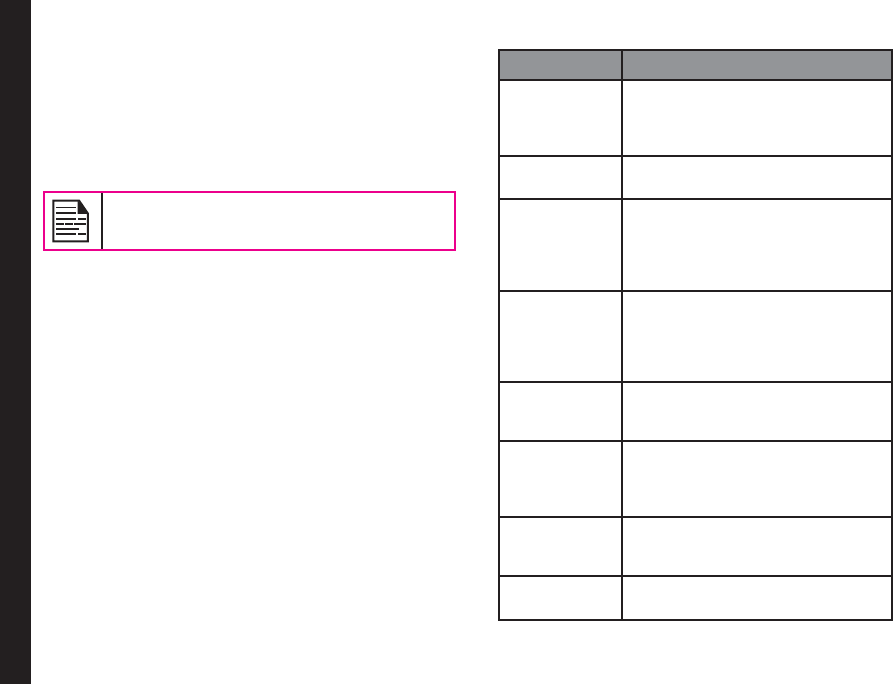
51
Managing Messages
SMS and MMS are convenient and inexpensive means
of communication. You can send a text message to
other people via SMS service. MMS allows you to send
messages by including multimedia content such as
pictures, audio les, video les, and so on.
You can use the Messages menu in your phone to send
an SMS and MMS message to other mobile phones or
any other equipment that can receive SMS and MMS.
The MMS facility is available only if you
subscribe it from your network operator.
To access the messages function select Menu >
Messages. The list of options are displayed.
Write Message
You can create SMS and MMS messages.
SMS Messages
1. To create a SMS message select Menu > Messages
> Write message.
2. Enter the message in the text pane. The text input
mode is displayed at the top left of the screen. Press
and release # to select the appropriate text input
mode (refer “Text Input Mode” on page 53).
3. Enter the message and select Options. The
following options are present:
Options Function
Send to You can select recipients for
the message. You can enter a
new number or select from the
Phonebook.
Insert symbol You can select the required symbol
to include in the message.
Input Method
Options
You can set the input options to
T9, add a new T9 word or enable
auto completion and alphabetic
prediction under Advanced
Settings.
Edit options You can mark the required text of
a message, select Copy all to copy
the complete text or Cut all to cut
the complete message and paste
at a desired location.
Add picture You can add a picture to the
message. You can also Take new
Picture from Camera
Add sound You can add a sound to the
message. You can also record a
new sound using a sound recorder
and save it in the folder.
Add video You can add a video to the
message. You can also record new
video from Camera.
Add subject You can add a subject to the
message.
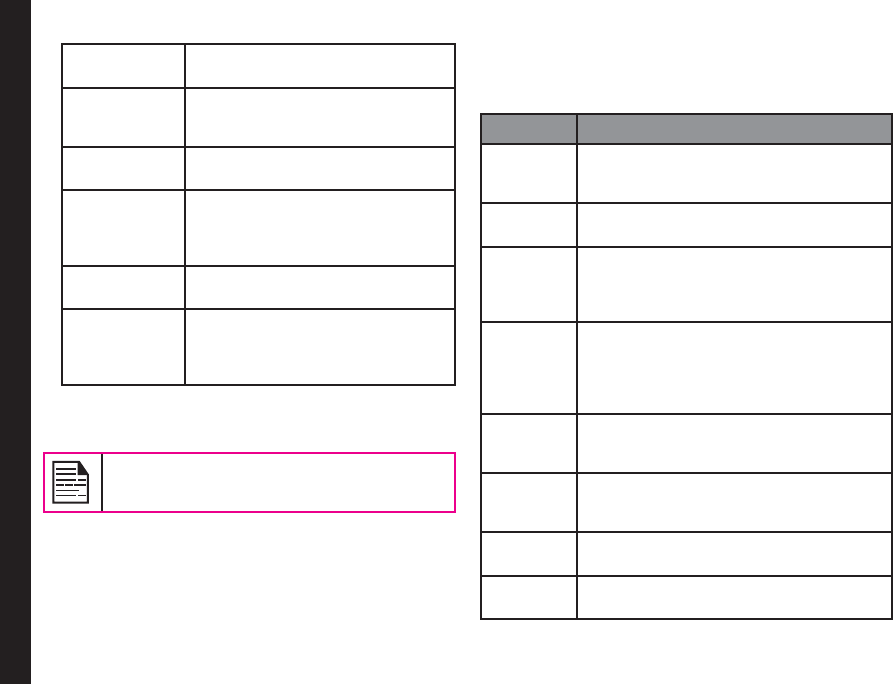
52
Preview MMS You can preview the message
before sending.
Slide options You can set to display a slide either
behind or before the message and
set the slide display timings.
Switch to
MMS
You can switch to MMS and send
the message as a MMS.
Advanced You can use a message template
stored in Templates folder.
You can attach a le, contact
details, and insert bookmarks.
Save to drafts You can save the message as a
draft in Draft folder.
Details You can view the details of the
message such as message type,
subject, size, number of recipients,
and attachment list.
4. Select Send to and select the recipients of the
message.
5. Select Options > Send, to send the message.
Instead of selecting Options, press the menu
key to quickly send the message to a number
in Phonebook.
MMS Messages
1. To write a MMS message select Menu > Messages
> Write message.
2. Enter the message in the text pane. The text input
mode is displayed at the top left of the screen. Press
and release # to select the appropriate text input
mode.
3. Enter the message and select Options. The
following options are present:
Options Function
Send to You can select recipients for the
message. You can enter a new number or
select from the Phonebook.
Insert
symbol
You can select the required symbol to
include in the message.
Input
Method
Options
You can set the input options to T9, add
a new T9 word or enable auto completion
and alphabetic prediction under
Advanced Settings.
Edit
options
You can mark the required text of a
message, select Copy all to copy the
complete text or Cut all to cut the
complete message and paste at a
desired location.
Add
picture
You can add a picture to the message.
You can also Take new Picture from
Camera
Add
sound
You can add a sound to the message.
You can also record a new sound using a
sound recorder and save it in the folder.
Add video You can add a video to the message. You
can also record new video from Camera.
Add
subject
You can add a subject to the message.
Managing Messages
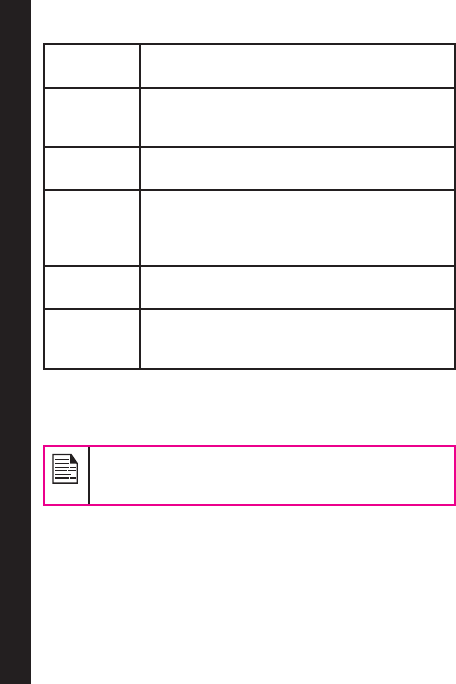
53
Preview
MMS
You can preview the message before
sending.
Slide
options
You can set to display a slide either
behind or before the message and set the
slide display timings.
Switch to
SMS
You can switch to SMS and send the
message as a SMS.
Advanced You can use a message template stored
in Templates folder.
You can attach a le, contact details, and
insert bookmarks.
Save to
drafts
You can save the message as a draft in
Draft folder.
Details You can view the details of the message
such as message type, subject, size,
number of recipients, and attachment list.
4. Select Options > Send to and select the recipients
of the message.
5. Select Options > Send, to send the message.
Instead of selecting Options, press the menu
key to quickly send the message to a number in
Phonebook.
Manage Your Messages
The inbox, draft, outbox and sent folders display the
number of stored messages in parenthesis.
Inbox
The Inbox stores and displays all the incoming SMS and
MMS messages.
To access the Inbox, select Menu > Messages > Inbox.
The Inbox displays a list of messages.
1. Scroll to a message and select Options to view the
following list of options.
• View: You can view the message.
• Reply: You can send a text or multimedia
message to the sender of that message.
• Call sender: You can call the sender of the
message.
• Forward: You can send the message to
another recipient.
• Delete: You can delete the message.
• Delete all: You can delete all the messages.
• Save to Phonebook: You can save the
numbers to the phonebook.
• Sort by: You can sort the messages based on
Sender, Subject, unread/read, Message size
and Message type.
• Move to Archive: You can move the selected
message to archive.
• Mark several: You can select multiple
messages, one by one.
• Mark as unread: You can mark a message as
unread.
• Advanced: You can copy and move messages
Managing Messages

54
Managing Messages
from the phone memory to SIM card or from
SIM card to phone memory.
• Details: You can view the details of the
message such as message type, subject, size,
number of recipients, and attachment list.
2. To open a message, scroll to a message and press
the menu key.
3. After a message is opened other functions can
be performed. Select Options to list the following
options: Reply, Call sender, Forward, Delete, Edit,
Save as Template, Save to Phonebook and also
other Advanced options to use the number, URL,
e-mail, USSD, copy or move the messages from
phone memory to SIM card or from SIM card to
phone memory.
Drafts
Messages that have been saved to be sent later are
stored in Draft.
1. To access unsent messages, select Menu >
Messages > Drafts.
2. Select Options to view the following list of options.
• View: You can view the message.
• Send: You can send the message.
• Edit: You can edit the message.
• Delete: You can delete the message.
• Delete all: You can delete all the messages.
• Sort by: You can sort the messages based on
Sender, Subject, unread/read, Message size
and Message type.
• Mark several: You can select multiple
messages, one by one.
• Advanced: You can copy and move messages
from phone memory to SIM card or from SIM
card to phone memory.
• Details: You can view the details of the
multimedia or e-mail message.
3. Press the menu key to view the message.
4. Select Options > Send to send the message.
Outbox
Messages that were undelivered to the recipient due to
some reason are stored in Outbox.
1. To access undelivered messages, select Menu >
Messages > Outbox.
2. Select Options to view the following list of options.
• View: You can view the message.
• Resend: You can resend the message.
• Edit: You can edit the message.
• Delete: You can delete the message.
• Delete all: You can delete all the messages.
• Sort by: You can sort the messages based on
Sender, Subject, unread/read, Message size
and Message type.
• Mark several: You can select multiple
messages, one by one.
• Advanced: You can copy and move messages
from phone memory to SIM card or from SIM
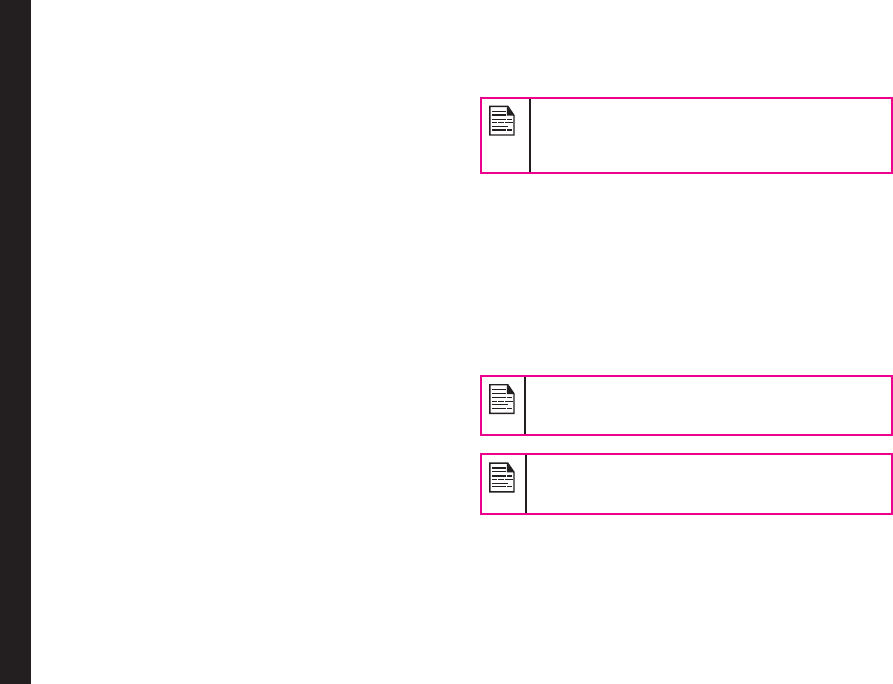
55
card to phone memory.
• Details: You can view the details of the
multimedia or e-mail message.
3. Press the Menu key to view the message.
4. Press Options > Resend to send the message.
Sent Messages
Messages that have been sent and delivered are stored
in Sent.
1. To access sent messages, select Menu >
Messages > Sent.
2. Select Options to view the following list of options.
• View: You can view the message.
• Forward: You can send the message to
another recipient.
• Delete: You can delete the message.
• Delete all: You can delete all the messages.
• Sort by: You can sort the messages based on
Sender, Subject, unread/read, Message size
and Message type.
• Move to Archive: You can move the selected
message to archive.
• Mark several: You can select multiple
messages, one by one.
• Advanced: You can copy and move messages
to the phone memory.
• Details: You can view the details of the
message such as message type, subject, size,
number of recipients, and attachment list.
3. Press the menu key to view the message.
The messages are saved in Sent, only if it is
activated in Messages > Message settings >
Common settings. Refer “Message Settings”
on page 57.
Archive
You can save the received or sent messages in the
archive folder. To archive a message, select Menu
> Messages > Inbox/Sent Messages > select the
message > select Move to Archive.
Email Messages
You can send, receive, and manage e-mail messages. To
access, select Menu > Messages > Email.
The E-mail acccount has to be congured
created and activated to access the e-mail
messages.
You can store total number of 100 e-mail
messages and maximum of 50 e-mail messages
per e-mail account.
Configuring Email Accounts
You have to congure and create an e-mail account to
access the e-mail functionalities.
1. To create an e-mail account Menu > Messages
> Email > A message appears Start to create
Managing Messages
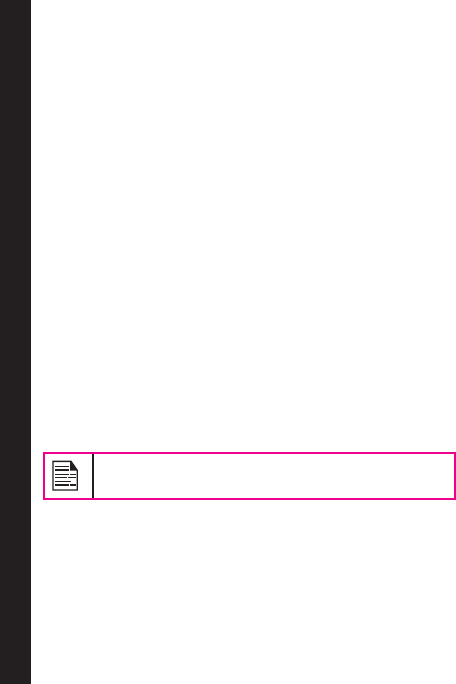
56
account? > Select Yes.
2. Select the specic predened email service provider.
3. Enter the e-mail address and password and select
Ok.
If you want to create other Email accounts,
1. Select Other Email accounts.
2. Enter the e-mail address and select Options > Next.
3. Select a protocol and select Options > Next.
4. Select a data account and select Options > Next.
5. Enter the incoming server address and select
Options > Next
6. Enter the outgoing server address and select
Options > Next.
7. Enter the user name and select Options > Next.
8. Enter the password and select Options > Next.
9. Enter the account name (if it is not displayed) and
select Options > Done. The e-mail account is
saved.
Instead of selecting Options > Next, press the
menu key to quickly go to the next step.
Write Email
1. To write an e-mail, select Menu > Messages >
Email > Select the Email Account > Options >
Write Email.
2. Enter the following details:
• To: You can enter the recipient’s e-mail
address.
• Subject: You can enter the subject of the
e-mail.
3. Select Options to enter the following details:
• Edit: You can edit the subject or content.
• Address: You can enter the e-mail address of
the receipient, to whom a copy or blind copy of
the e-mail has to be sent.
• Add Attachments: You can also include
attachments.
• Priority: You can set the priority for the
message.
• Save to Drafts : You can save the e-mail to
draft and send later.
• Size: View the size of the mail.
• Exit: Exit without sending.
4. Select Options > Send.
Email Inbox
The Inbox stores and displays all the incoming messages.
1. To access the inbox, select Menu > Messages >
Email > Select the Email Account > Options >
View > Inbox. The inbox displays a list of messages.
2. Scroll to a message and select Options to view the
list of inbox options.
3. To open a message, scroll to a message and press
the Menu key.
Managing Messages

57
Email Outbox
Messages that were undelivered to the recipient due to
some reason are stored in Outbox.
1. To access undelivered messages, select Menu >
Messages > Email > Select the Email Account >
Options > View > Outbox.
2. Select Options to display the outbox options.
3. Press the Menu key to view the message.
4. Press Options > Send to send the message.
Email Sent
Messages that have been sent and delivered are stored
in Sent.
1. To access sent messages, select Menu >
Messages > Email > Select the Email Account >
Options > View > Sent.
2. Select Options to display the sent options.
3. Press the Menu key to view the message.
4. Press Options > Send to resend the message.
Email Draft
Messages that have been saved to be sent later are
stored in Drafts.
1. To access unsent messages, select Menu >
Messages > Email > Select the Email Account >
Options > View > Draft.
2. Select Options to view the draft options.
3. Press the menu key to view the message.
4. Press Options > Send to send the message.
Broadcast Messages
You can select to receive broadcast messages. On the
home screen, select Menu > Messages > Broadcast
message.
• Receive mode: Select On to get information about
the reception tower.
• Read message: Select this to read the message.
• Languages: Select the required language.
• Channel settings: Select, add, edit, and delete
channels.
Templates
When you send messages to contacts, you can use the
predened messages stored in Templates folder. You can
use a text message template for an SMS message and
multimedia message template for an MMS message.
Message Settings
To view or dene settings for your messages, select
Menu > Messages > Message settings.
SMS Settings
Select Message settings > Text message to edit the
following SMS settings:
• Prole settings: View and edit the prole name,
SMSC address, validity period, and type of
message.
• Voicemail Server: Congure the voicemail server.
Managing Messages
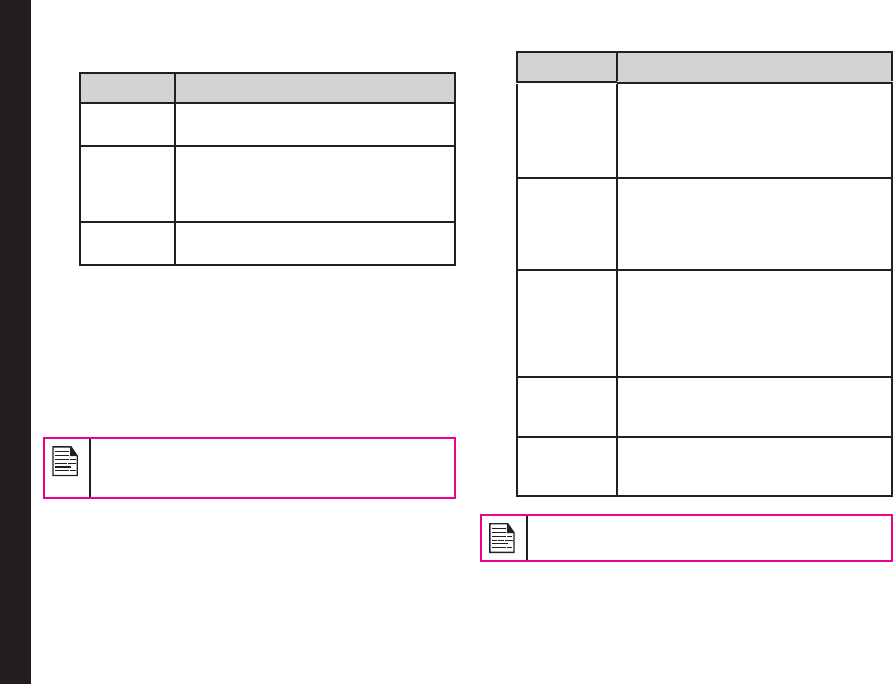
58
• Common settings: Set the following options:
Settings Function
Delivery
report
Get a confirmation report whether or
not the message has been delivered.
Reply
Path
View the message centre number,
provided by your service provider,
via which your messages are sent
and received.
Save sent
message
Save the sent messages.
• Memory status: View the number of messages
stored in the SIM and mobile phone.
• Preferred Storage: You can select mobile phone or
memory card as the storage location of messages.
MMS Settings
Select Message settings > Multimedia message to edit
the following MMS settings:
You can also update the MMS settings from
www.sonimtech.com/support and then click
Over the air Internet Settings.
• Data Account: Select the MMS data account.
• Common settings: Set the following options:
Settings Function
Compose You can set the slide time, creation
mode, picture size and select to
insert signature automatically. You
can enter the text, picture, video, or
sound for the signature.
Sending You can set the validity period,
activate to receive the delivery
report and read report, priority,
delivery time and save the sent
message.
Retrieval You can select to retrieve the
message in home network or
while roaming. You can allow
or reject anonymous mails and
advertisements, You can send the
read report and delivery report.
Preferred
storage
You can select phone or memory
card as the storage location for
messages.
Memory
status
You can view the number of
messages stored in phone and
memory card.
Pre-dened MMS Settings: You may nd some
pre-dened operator settings on the phone.
Managing Messages
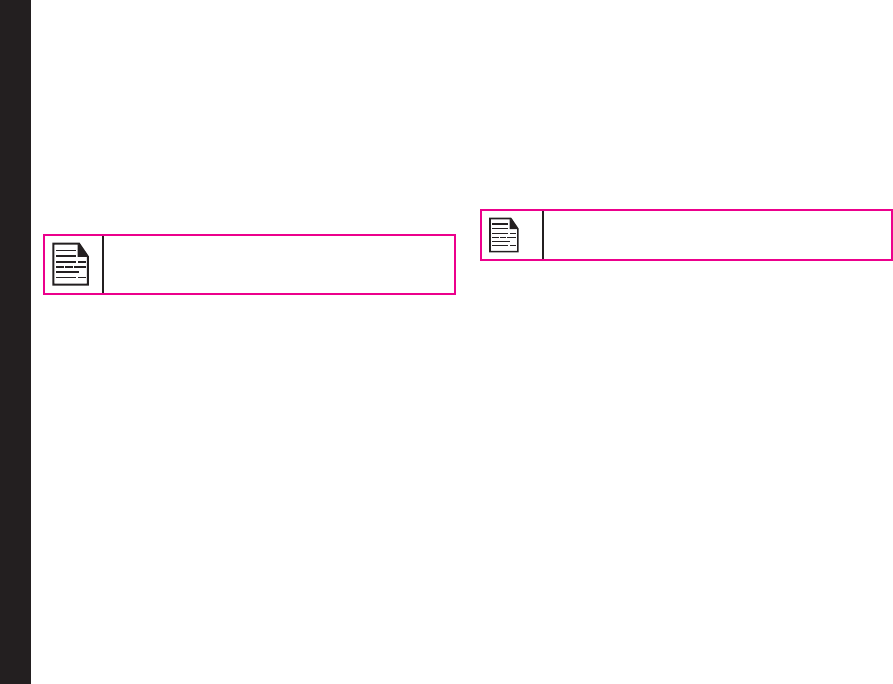
59
Managing Profiles
You can activate and modify various settings on your
Sonim XP5520 phone using Proles.
On the home screen, select Menu > Settings > Phone
settings > Profiles to display the options.
You can customise the proles to use features such
as tone settings, ring volume, alert type, ring type and
extra tone. There are six environment proles present in
this phone. General is the default prole, while the other
proles are Meeting, Outdoor, Silent, Flight mode and
Headset.
You cannot change the parameters for the
Silent mode.
• General: The default prole where all sounds are
enabled. Parameters in this mode can be changed.
Select Menu > Settings > Phone settings >
Profiles > General > Options > Customize to open
the Customize screen. You can use this screen to
choose tone settings, ring volume, alert type, ring
type or extra tone. Select Menu > Settings > Phone
settings > Profiles > General > Options > Activate
to activate this prole.
• Meeting: Here only the vibrate mode is enabled.
Parameters in this mode can be changed. Select
Menu > Settings > Phone settings > Profiles
> Meeting > Customize to open the Customize
screen. You can use this screen to choose tone
settings, ring volume, alert type, ring type or extra
tone. Select Menu > Settings > Phone settings
> Profiles > Meeting > Activate to activate this
prole. You can also press and hold the # key to
activate the meeting mode from the home screen.
• Outdoor: Here both the vibrate and ring modes are
enabled. Parameters in this mode can be changed.
Select Menu > Settings > Phone settings >
Proles > Outdoors > Options > Customize to
open the Customize screen. You can use this screen
to choose tone settings, ring volume, alert type, ring
type, or extra tone.
• Silent: Here all sounds are kept in mute. Select
Menu > Settings > Phone settings > Profiles >
Silent > Activate to activate this prole.
Alarm tone will be played even in Silent prole.
• Flight mode: Here all sounds are kept in mute.
Select Menu > Settings > Phone settings >
Profiles > Flight mode to open the Flight mode
screen. Select Flight mode to activate this prole.
In this mode, you cannot make or receive calls but
can play Media player. You can deactivate the ight
mode only by selecting Menu > Settings > Phone
settings > Proles > Flight mode > Normal mode.
• Headset: Headset mode is activated automatically
when wired headset is inserted. User cannot change
to other proles except Flight mode when wired
headset is inserted Parameters in this mode can be
changed. Select Menu > Settings > Phone settings
> Profiles > Headset > Customize to open the
Customize screen. You can use this screen to
choose Tone settings, Volume, Alert type, Ring type
or Extra tone.
Sound Settings
Select Menu > Settings > Phone settings > Profiles >
General > Customize. Changing it effects the current set
prole. The following sound settings are displayed:
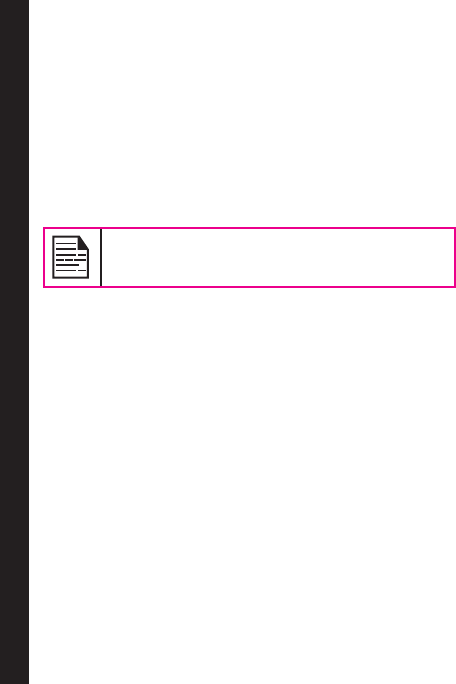
60
1. Tone settings: You can set the tone for incoming
calls, messages, and keypad.
2. Volume: You can set the volume for ringtone and
keytone.
3. Alert Type: You can set the alert type for incoming
calls and messages. You can select Ring only,
Vibrate only, Vibrate and Ring, Vibrate then ring.
4. Ring type: You can set the ringtype for your calls.
You can select Repeat, Ascending or Beep once.
You can download and store ring tones over
Bluetooth or WAP. The supported ringtone
formats are MIDI, MP3, WAV, AAC and AMR.
5. Extra tone: You can set tones for warning, error, and
connections.
Managing Profiles
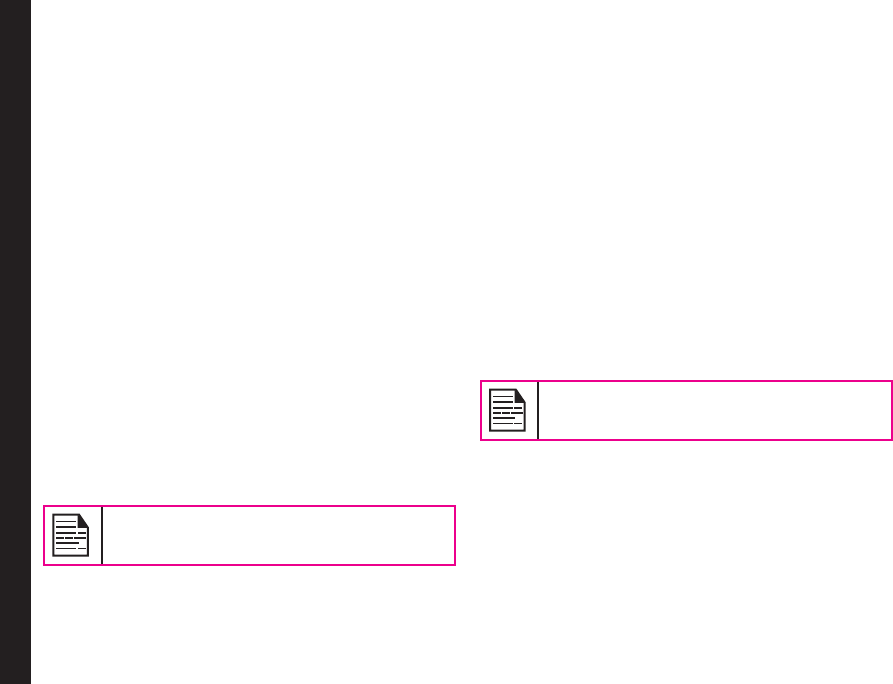
61
Tools
This section contains miscellaneous features supported
by the handset.
Calendar
The calendar enables you to set appointments, schedule
reminders when required, set alerts and repeat specic
settings. Tasks can be viewed on daily and weekly basis.
1. To access the Organizer and its associated
functions, select Menu > Tools > Calendar. The
calendar for the current month is displayed. Use the
navigation keys to navigate across months.
2. Select Options to view the list of options available.
• View: You can view the list of events for the
day.
• View all: You can view all the events.
• Add event: You can enter a new event.
• Delete event: You can delete an event.
• Jump to date: You can go to a particular date
and view the events for that date.
• Go to today: You can access the current date.
• Go to weekly view: You can view the list of
events for the week.
When you are in weekly view, the option
changes to Go to monthly view to view the
calendar of the month.
Edit Events
Select Menu > Tools > Calendar > Options > View.
Select the event. Select Options > Edit. Make the
changes. Select Done and Save.
Alarm
You can set alarm for a particular time. Select Menu >
Tools > Alarm.
1. To set a simple alarm, select Menu > Tools > Alarm
> Edit > On. Enter the time and select Repeat >
Once. Select Done.
2. To set a recurrent alarm, select Menu > Tools
> Alarm > Edit > On. Enter the time and select
Repeat > Everyday or Custom. Using the menu
key, select the day and select Done.
3. To set the alarm tone, select Menu > Tools > Alarm
> Edit > Alarm tone > Tone. Select the alarm tone.
4. To enable snooze, select Menu > Tools > Alarm >
Edit > Snooze. Use the left and right arrow keys to
set the time for snooze.
The alarm will work even if the phone is
switched off or is in Silent mode.
Calculator
The calculator in this phone is designed to perform
simple mathematical calculations.
1. Select Menu > Tools > Calculator.
2. To enter the numbers, press the numeric keys.
3. To use mathematical operators use the navigation
keys.
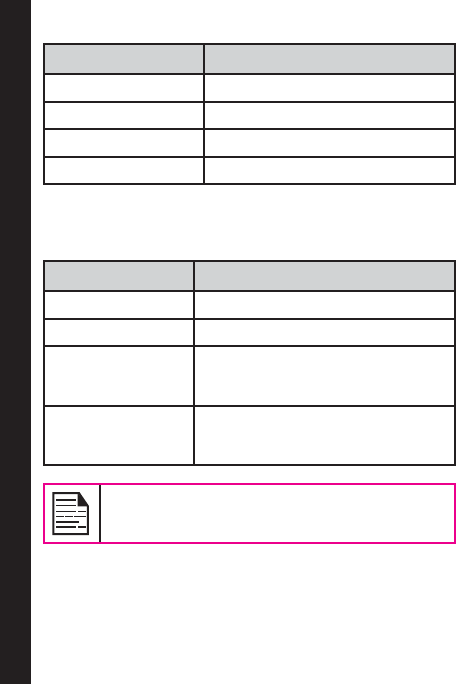
62
Navigation Key Operation
Up + (Addition)
Down - (Subtraction)
Left * (Multiplication)
Right / (Division)
4. After performing the calculations, press the menu
key for the nal result.
The following calculator options are also displayed.
Options Function
MC Clears number from memory
MR Reads the number from memory
M+ Adds a number to the number in
memory and stores the result in
memory
M- Subtracts a number to the
number in memory and stores the
result in memory
This phone accepts numbers up to a maximum
of 12 digits per entry.
Unit Converter
You can convert one type of physical units to another
type. Select Menu > Tools > Unit converter.
1. Select the type of physical unit. Use the Right or Left
navigation keys to scroll. For example, Weight from
Kg to Pound.
2. Scroll down and enter the value in Kg slot or Pound
slot, for example, 10 Kg and select OK.
3. The Weight for 10 Kgs is converted to pounds and is
displayed in the Pound slot.
You can select Unit converter > Currency converter to
convert the currency based on rate. Enter the rate and
then enter the local value of the currency. The equivalent
foreign value of the currency is displayed.
World Clock
You can view the time of major cities in different time
zones using this function. You also have the option to use
Daylight Saving Time (DST).
The local time is displayed in the lower half of the screen.
1. To view the international clock, select Menu > Tools
> World clock.
2. To view the time of different cities, select the
required city using the navigation keys and the time
is displayed.
3. To set Daylight Saving Time (DST), select Menu >
Tools > World clock > Options > Daylight saving
time for foreign city > On.
4. To set the home city, select Menu > Tools > World
clock > select the home city and select Options >
Set Home city.
Tools

63
Tools
Sound Recorder
Select Menu > Tools > Sound recorder.
1. To record an audio le, select Options > New
record.
2. To temporarily stop the recording, select Pause.
3. To continue with the recording, select Continue.
4. To end the recording, select Stop. A message
appears Save audio? > Select Yes . The recorded
audio le is stored under My les. For more
information refer “Managing Your Files” on page 44.
Audio Playback
The user can do instant playback of the recorded audio
within the sound recorder. To listen to a recorded audio
le, select Menu > Tools > Sound recorder > Options
> List. You can also select Menu > My files > Open >
Audio > Open to access the audio les.
Notes
Select Menu > Tools > Notes to store the required
information.
Stopwatch
Select Menu > Tools > Stopwatch to start and stop the
timer, as required.
Text Reader
Select Menu > Tools > Text reader to view and read the
.txt les.
SIM Card Menu
You can access certain services provided by the operator
using this menu. This feature can be accessed via Menu
> Tools > Operator service.
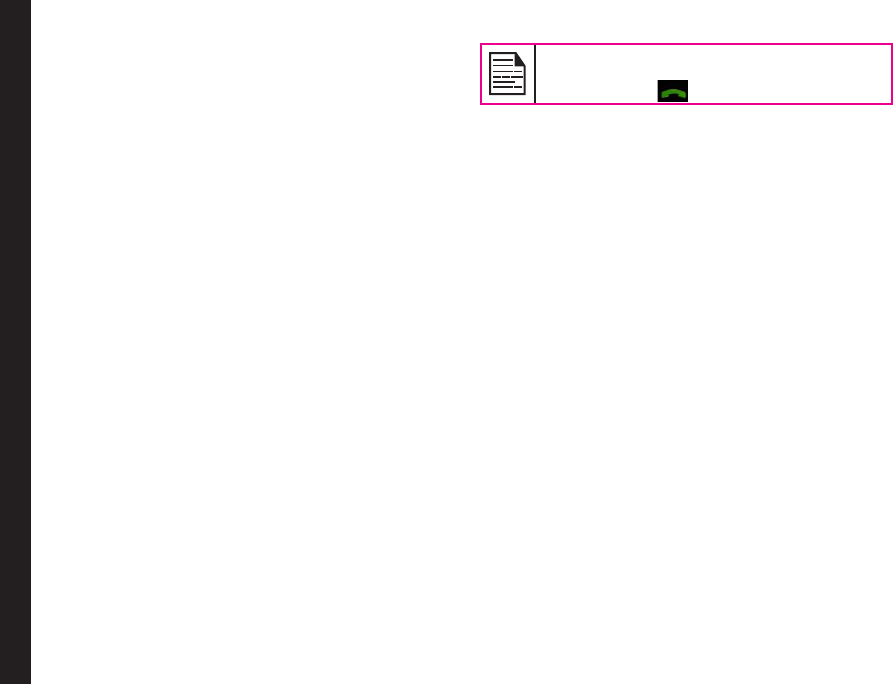
64
Applications
You can download more Java applications via WAP,
Bluetooth, SD Card or Java Application Manager.
Network Profile Settings
To use the applications requiring internet service, the
network prole must be set.
Select Menu > Settings > Connectivity > Java Settings.
Select the required data account and save.
GPS Navigator
The application provides information on longitude,
latitude, and altitude. To access this application, select
Menu -> GPS Navigator.
Self Serve
This will allow the user to access Bell Self Serve mobile
site. Details about the Self Serve are available at the site.
Installing Java Application from WAP
Congure WAP as described in “WAP Browser” on page
65. Launch WAP. Browse to the http/WAP link where the
le (.jar or .jad) is present. Select the le. The installation
process begins. Once the application is installed
successfully, it will be displayed in the Applications
(Java box).
Installing Java Application from Memory Card
Select Menu > My les > Memory card. Select the le
(.jar or .jad). The installation process begins. Once the
application is installed successfully, it will be displayed in
the Java box.
Some Java applications running in the
foreground can be pushed to the background
by pressing the key.
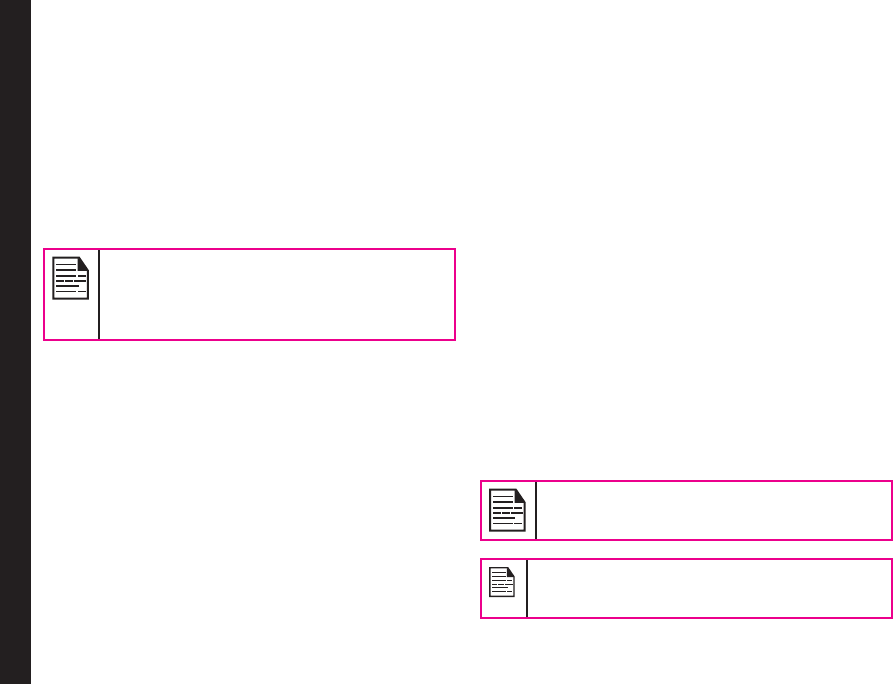
65
WAP Browser
This mobile phone has an internal WAP browser that
allows you to browse contents of various WAP websites
on the Internet. This facility is made available only if
you subscribe to a data service from your network
operator for Internet access. You need to consult your
local operator for more details. Congure the WAP when
you use it for the rst time. Some WAP parameters on
your phone have already been set to a specic network
operator. If you utilize the services of the same network
operator you can directly operate the WAP service with
the available conguration. If not, you need to recongure
the settings.
If you are unable to view WAP web pages
because of change in WAP parameters or
change in WAP web address or contents,
please consult your network operator and
Internet Content Provider (ICP) for updates.
Select Menu > Browser. The following sub menus are
displayed:
• Homepage: This is the page that is displayed rst
when you open the WAP browser.
• Bookmarks: Use this menu to add and
manage your bookmarks and go directly to the
corresponding web address. You can also edit or
delete bookmarks via this menu.
• Input address: Enter a web address directly and
browse.
• Last Web Address: View the last visited Web page.
• Recent Pages: View web pages which you have
viewed previously. Click on them to open the pages.
• Stored pages: You can view the pages that are
saved.
• Service messages: This is the inbox for WAP push
messages.
• Settings: The following congurations can be set via
this menu:
• Homepage: Set the homepage.
• Data Accounts: In this menu, existing
accounts are listed on the display. Scroll to the
required account and select OK.
• Browser options: You can clear cache,
cookies and authentication information.
• Preferences: You can set the time out, select
to display or not display images in the web
pages and you can enable or disable the
cookies and cache.
• Security settings: You can view the trusted
certificates.
• Service message settings: You can decide
whether or not to receive the push messages
from operators and web portals. You can
enable service loading.
• Restore browser settings: You can restore to
the original browser settings.
You can also update the WAP settings from
www.sonimtech.com/support and then click
Over the air Internet Settings.
Pre-dened Browser Settings: You may nd
some pre-dened operator settings on the
phone.
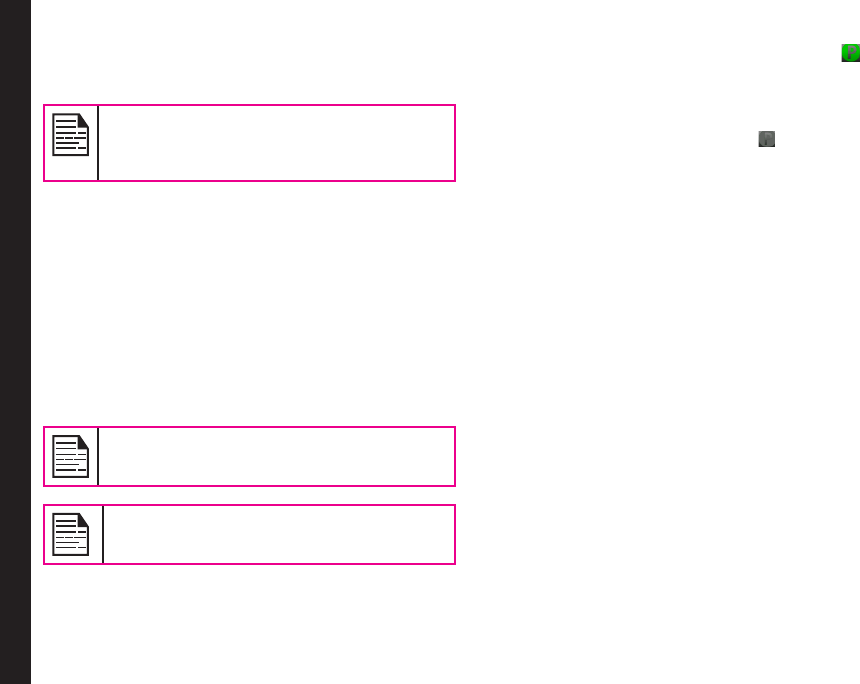
66
Managing PTT Services
PTT application is available on your XP5520 phone. You
can access this application only if the PTT service is
enabled.
This feature is subject to phone model and
subscription support. If PTT icon is not
displayed in the menu, then the feature is not
supported.
Activating the PTT service
1. Select Menu > Push-to-Talk > Select Yes to
activate PTT service.
You can also press the PTT button located in the left
side of the phone.
The PTT service is activated and contacts the server
to retrieve groups and contacts.
2. Once registered, “Synchronization successful”
message is displayed and the PTT service is
registered.
During the next power on cycle, the PTT
application is automatically enabled.
When the PTT service is enabled, a green
circle is displayed at the top left corner of the
home screen.
Login and Logout the PTT Service
• To login, select Menu > Push-to-Talk > Select
Yes . Once activated, Login successful message
is displayed. Once you login the PTT service, is
displayed at the top left corner of the home screen
indicating your available status.
• To logout the PTT service, select Menu > Push-to-
Talk > Options > Settings > Logout > Select Yes .
Once you logout the PTT service, is displayed.
Public Subscriber Privilege
A public subscriber has the capability to initiate PTT
features to other public contacts or groups.
Allowed Public Subscriber Rights
A public subscriber will be able to:
• Create public contact or groups. You can add upto
300 contacts and 30 groups each containing 30
members.
• Delete public contacts or groups.
• Edit public contacts or groups.
• Make public PTT calls.
• Initiate a xed PTT group call.
• Initiate a PTT quick group call to other public
contacts.
• Send personal alerts to other public contacts.
• Availability status change.
• Log off.
Corporate Subscriber Privilege
A corporate subscriber has the capability to initiate PTT
features only to the administrator-provisioned corporate
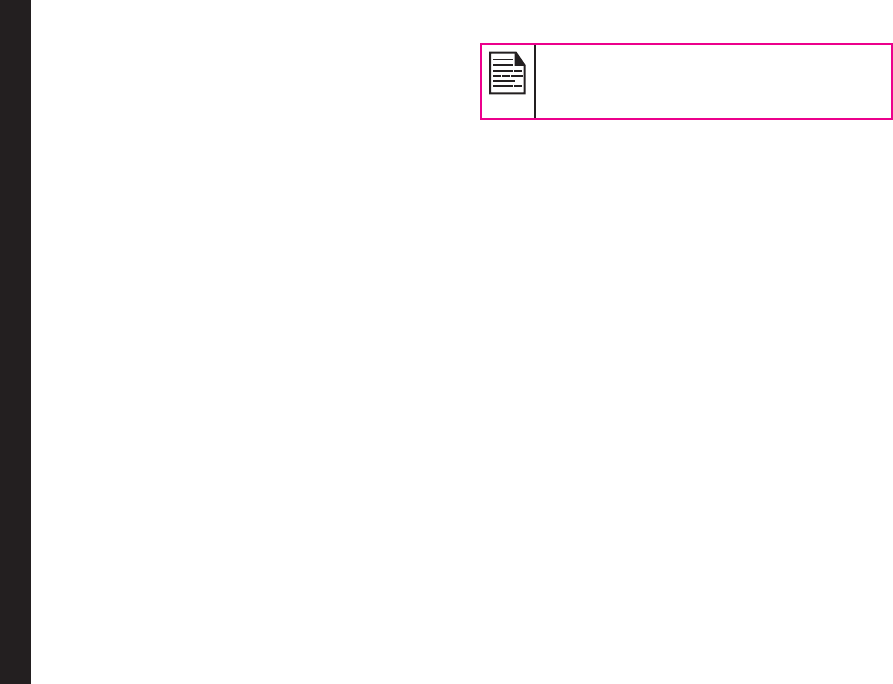
67
contacts, corporate groups, and group members.
Allowed Corporate Subscriber Rights
A corporate subscriber will be able to:
• Make corporate PTT calls.
• Initiate a corporate xed PTT group call.
• Initiate a PTT quick group call to other corporate
contacts.
• Availability status change.
• Send personal alerts to other corporate contacts.
• Add contacts and groups as favorites.
• Log off.
Disallowed Corporate Subscriber Rights
A corporate subscriber will not be able to:
• Create any contacts or groups. Administrator
can add upto 1000 contacts and 70 groups each
containing 100 members.
• Add group members to a group.
• Edit contacts or groups. The user can only add
contacts and groups as favorites.
• Delete any contacts or groups and its members.
Corporate-Public Subscriber Privilege
A corporate-public subscriber is allowed to perform
all PTT services to other public and corporate-public
subscribers.
A corporate-public subscriber’s handset
includes both corporate PTT features and
public PTT features.
Allowed Corporate-Public Subscriber Rights
A corporate-public subscriber will be able to:
• Create a public contact. You can add upto 300
contacts and 30 groups each containing 30
members.
• Create groups with other public contacts.
• Create group with mix of public and corporate
contacts.
• Rename public contacts, groups or any group
members.
• Delete public contacts.
• Delete any groups created by the corporate-public
subscriber.
• Make PTT calls to public and corporate contacts.
• Initiate a PTT quick group call to public contacts.
• Initiate a PTT quick group call to a mix of corporate
and public contacts.
• Initiate a PTT xed group call to a mix of corporate
and public contacts.
• Send personal alerts to public and corporate
contacts.
• Add contacts and groups as favorites.
• Availability status change.
Managing PTT Services
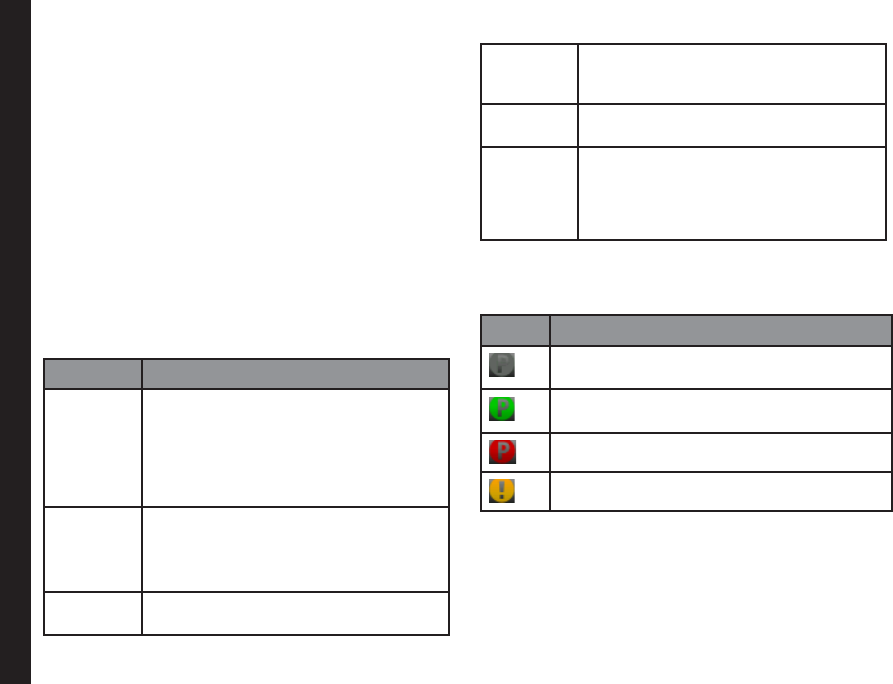
68
• Log off.
Disallowed Corporate-Public subscriber Rights
A corporate-public subscriber will not be able to:
• Add corporate contacts or groups. Administrator
can add upto 1000 contacts and 70 corporate
groups each containing 100 members.
• Add group members to a corporate group.
• Edit contacts or groups. The user can only add
contacts and groups as favorites.
• Delete corporate contacts or corporate groups and
its members.
PTT Key Functions
PTT related keys present in your XP5520 phone are:
Key Function
PTT key • Displays the PTT home tab.
• Initiate a PTT call.
• Initiate a call to the Call me Alert
contact.
• Used for Floor control
Volume
keys
• Adjusts the volume during an PTT
conversation.
• Navigates up and down the PTT
Contacts list.
LSK Activates the menu options displayed at
the bottom of the screen.
RSK • Sends alert to a selected contact.
• Toggles between favorite groups
and contacts in Favorites tab.
Navigation
keys
Scrolls horizontally or vertically to
access a desired menu option.
Power on/
Power off/
End call
key
• Switch on/off the phone.
• Return to the home screen when
the phone is in any other screen.
• Ends an PTT call.
PTT Display Icons
The common PTT display icons are:
Icon Description
Indicates you are connected to PTT service
but not logged in.
Indicates you are logged-on to PTT service
and in Available status.
Indicates contact is in Do not disturb status.
Indicates a new notication.
Manage PTT Settings
To access the PTT Settings, select Menu > Push-to-
Talk. The Home tab with call history is displayed. Select
a contact and select Options. By default the rst contact
in the call history is selected. The following options are
displayed.
Managing PTT Services
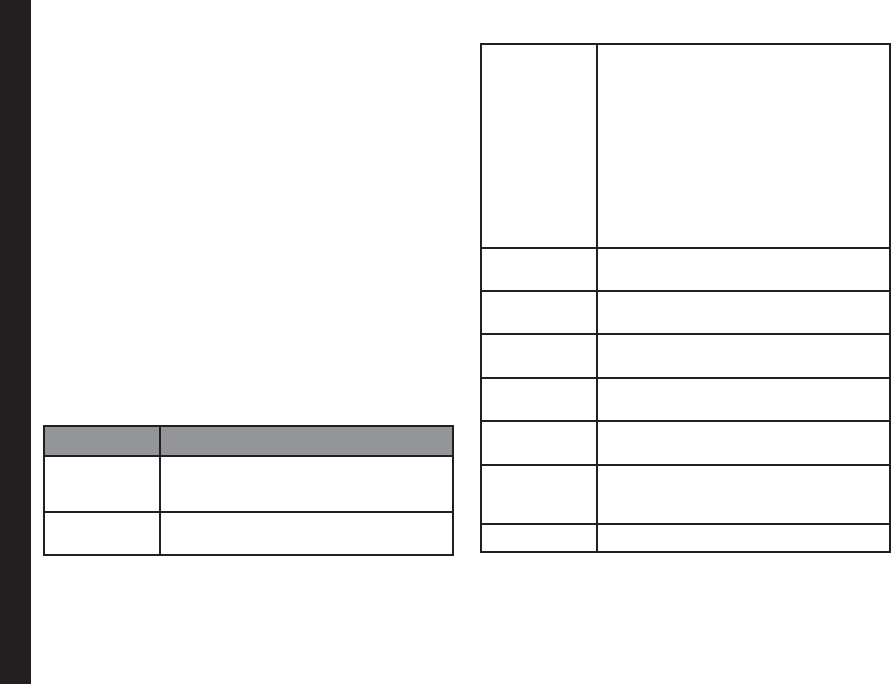
69
Managing PTT Services
• My Presence: Set one of the following options to
indicate your online presence.
• Available - Indicates your online presence to
other contacts all the time.
• Do not Disturb - Indicates that you are not to
be interrupted by other contacts.
• View History : View call/alert history specic to the
selected contact.
• Search: Search for a contact in the Contacts tab.
• Call: Dial a PTT call to the selected contact.
• Personal Alert: Send a personal alert to the
selected contact.
• Delete: Delete the selected contact from the call
history.
• Delete All: Delete all the calls and alerts from the
call history.
• Settings: You can set the availability status, alerts,
name, sort and so on.
Options Details
Vibrate Alert Enable or disable vibrate alerts for
incoming PTT calls and alerts.
Audible Alert Enable or disable audible alerts for
incoming PTT calls and alerts.
Alert Repeat Set the incoming alert notication to
• Once - The audible alert occurs
once when the notication is
displayed.
• Repeat - The audible alert
occurs immediately, and every
20 seconds for up to 10 minutes,
until user clear the notication.
• Continuous - The audible alert
occurs immediately, and every 20
seconds until the user clears the
notication.
Notication
Control
Enable or disable alert notications for
personal alerts and missed PTT calls.
Sort Contact
List
Sort the contacts based in
alphabetical order or online presence
Volume Increase or decrease the alert and call
volume
Display
Name
Edit the existing login name .
Capacity View the contacts, groups and
favorites storage capacity.
Restore
Factory
Defaults
Restore PTT settings to factory default
settings.
Logout Logout of PTT session.
Managing PTT Calls
A user can make one-to-one call, one-to-many call,
group call, and receive an incoming PTT call.
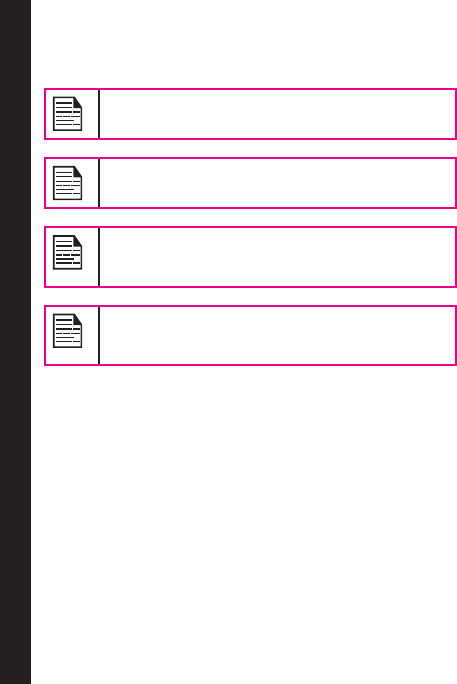
70
Calls can be dialled directly, or from the PTT contacts list,
or from the Call history.
You cannot establish a PTT call when the
receiver is busy.
You cannot call any recipient who is in Do not
disturb or Ofine status.
If a call has no response from both initiator and
receiver, is automatically disconnected after a
short time interval.
For one-to-one calls, the terminated call will be
considered by the client as a ‘Missed call’ if the
initiator never answers during the entire call.
Direct PTT Calls
To dial a PTT call directly:
1. Enter the number of a contact on the home screen
2. Press and hold the PTT key.
3. Continue to hold the PTT key to speak.
4. Release the PTT key when you nish speaking.
5. To end the call, press End Call (RSK) key.
Calls from PTT Contacts List
You can make a one-to-one call, quick group call, and
group call from the PTT Contacts.
One-to-One Call
This is a simple PTT session where just one caller and
one recipient are involved in the conversation.
1. Select Menu > Push-to-Talk > Contacts tab
or press and release the PTT key to display the
existing list of PTT Contacts.
2. Scroll to the contact you want to call. Press and
hold the PTT key. The Screen displays PTT Private
Call.
3. Continue to hold the PTT key to speak.
4. Release the PTT key when you nish speaking.
5. To end the call, press End Call (RSK) key.
Quick Group Call
You can quickly make a single call to many contacts in
the PTT Contacts list.
1. Select Menu > Push-to-Talk > Contacts tab
or press and release the PTT key to display the
existing list of PTT Contacts.
2. Mark the required contacts to whom you want to
call. You can add up to 10 contacts to initiate a
quick group call.
3. Press and release the PTT Key. You can also select
Options > Call to initiate a quick group call.
4. Continue to hold the PTT key while you are
speaking. Release the PTT key when you nish
speaking.
5. To end the call, press End Call (RSK) key.
PTT Group Call
Managing PTT Services
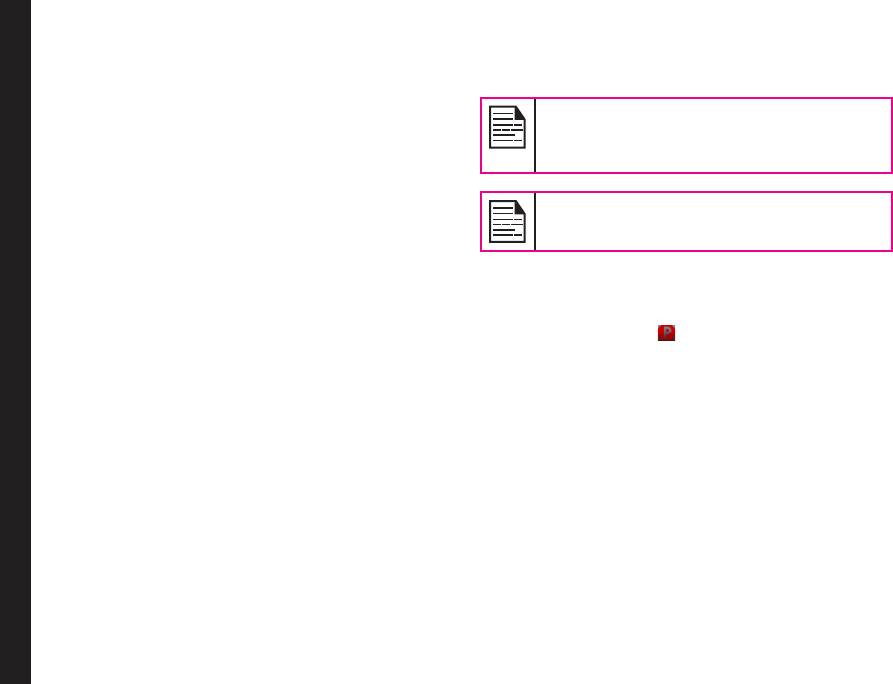
71
You can make a call to all the members of a group in the
PTT Contacts list.
1. Select Menu > Push-to-Talk > Groups tab or press
and release the PTT key to display the existing list of
PTT groups.
2. Scroll to the PTT group you want to call. Press and
hold the PTT key to call the selected group. The
Screen displays PTT Group Call.
3. Continue to hold the PTT key while you are
speaking.
4. Release the PTT key when you nish speaking.
5. To end the call, press End Call (RSK) key.
PTT Call History
The PTT Call history maintains logs of all outgoing PTT
calls, received PTT calls and missed PTT calls and alerts.
1. Select Menu > Push-to-Talk > Options > View
history.
2. Scroll to the contact you want to call. Press and
hold the PTT key to initiate the call.
3. Continue to hold the PTT key while you are
speaking.
4. Release the PTT key when you nish speaking.
5. To end the call, press End Call (RSK) key.
Sending Alerts
You can send a call me alert to the required individual
PTT Contact or a group member.
1. Select Menu > Push-to-Talk > Contacts tab.
2. Select a contact and press RSK Alert.
3. The alert is sent to the contact.
The popup alert is displayed for 6 minutes and
an alert sound is played every 10 seconds.
Alert pop and alert sound are dependent on the
respective settings.
You can send an alert only to the individuals/
group members who are online. If your status is
set to DND, you cannot send an alert.
Block Incoming PTT Calls
Select Menu > Push-to-Talk > Options > Settings > My
Presence > Do not disturb, to block incoming calls from
the other PTT members. is displayed at the top of the
screen indicating that Do not disturb option is enabled.
This icon is also displayed next to the contact name in
the PTT Contacts list of the other contacts.
When the Do not disturb option is enabled, any other
PTT contact trying to contact will receive a User busy
message.
Manage PTT Contact List
To access the PTT Contacts, select Menu > Push-to-
Talk > Contacts tab. The contacts tab contains the list
of members whom you want to call or send alerts. Your
contact list can be created or copied from your existing
list of contacts in your phonebook.
Select a contact and select Options. By default the rst
contact is selected. The following options are displayed.
• View Details : View contact details for the selected
Managing PTT Services

72
contact.
• View History : View call/alert history specic to the
selected contact.
• Search: Search for a contact in the Contacts.
• Delete: Delete the selected contact from the
Contacts.
• Call: Dial a PTT call to the selected contact.
• Personal Alert: Send a call me alert to the selected
contact.
• New group: You can add a new group and also
include a new member to the group.
• Settings: You can edit PTT settings such as the
alerts, volume, and display name, and also logout
of the PTT session. For more information refer,
“Manage PTT Settings” on page 68.
Add Contact
To add a new contact to the PTT Contacts list, do the
following:
1. Select Menu > Push-to-Talk > Contact tab > New
Contact.
2. Select Manual to add the contact details
manually or select Phone to select a contact from
phonebook.
3. Enter the Contact name and Contact number or
select the specic contact from the phonebook.
4. Select ON to add the contact to the Favorite
Contacts list.
5. Select Save. The contact is added to the PTT
Contacts.
Contact Options
1. Select a Contact in the Contacts tab and then
select Options >View Details > Options to view
following Contact Options:
• Add as Favorite: Add the selected contact to
Favorites Contacts.
• Call: Make a PTT call to the selected contact.
• Personal Alert: Send a call me alert to the
selected contact. For more information refer,
“Sending Alerts” on page 71.
• Edit: Edit the contact details
• Delete: You can delete a selected contact from
the Contacts list.
Manage PTT Groups
To access the PTT groups, select Menu > Push-to-Talk
> Groups tab. The Groups tab contains the list of groups
with contacts whom you want to call.
Select a group and select Options. By default the rst
group is selected. The following options are displayed.
• View Details : View details for the selected group.
• View History : View call history specic to the
selected group.
• Search: Search for a group in the groups list.
• Delete: Delete the selected group from the groups
list.
• Call: Dial a PTT call to the selected group.
• New group: You can add a new group and also
Managing PTT Services
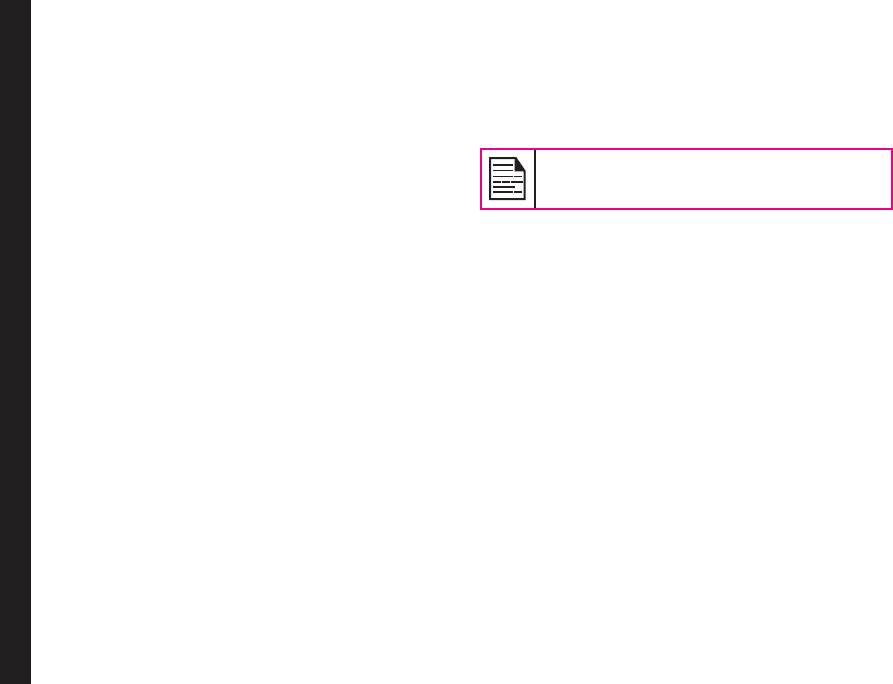
73
include a new member to the group.
• Settings: You can edit PTT settings such as the
alerts, volume, and display name, and also logout
of the PTT session. For more information refer,
“Manage PTT Settings” on page 68.
Add Group
To add a new group to the PTT groups list, do the
following:
1. Select Menu > Push-to-Talk > Groups tab > New
Group.
2. Enter the Group name.
3. Select ON to add the group to the Favorite Groups
list.
4. Select Add Members. Select members from PTT
Contacts and select Add.
5. Select Save. The new group is created.
Groups Options
1. Select a Group in the Groups tab and then select
Options >View Details > Options to view the
following group Options:
• Call Group: Make a PTT call to the selected
contact.
• Edit Group: Edit the group details.
• Delete Group: Delete a selected group from
the Groups list.
• Rename : Edit the selected group name.
• Add as Favorite: Add the selected group to
Favorite Groups.
Manage PTT Favorite Contacts
To access the PTT Favorite contacts, select Menu >
Push-to-Talk > Favorites tab. The Favorite Contacts tab
contains the list of PTT contacts added as favorites for
easy access.
If Favorite Groups is displayed, press RSK to
toggle to Favorite Contacts.
Select a Contact and select Options. By default the rst
contact is selected. The following options are displayed.
• View Details : View details for the selected contact.
• View History : View call/alert history specic to the
selected contact.
• Search: Search for a contact in the favorite contacts
list.
• New Favorite: Add a contact from PTT contacts to
the Favorite contacts list.
• Remove Favorite: Delete a contact from the
Favorite contacts list.
• Call: Dial a PTT call to the selected contact.
• New group: You can add a new group and also
include a new member to the group.
• Settings: You can edit PTT settings such as the
alerts, volume, and display name, and also logout
of the PTT session. For more information refer,
“Manage PTT Settings” on page 68.
Add Favorite Contact
To add a contact to the PTT favorite contacts list, do the
Managing PTT Services

74
following:
1. Select Menu > Push-to-Talk > Favorite Contact
tab > Add Contact.
2. Select the contact from the phonebook.
3. Add the contact to the Favorite Contacts list.
4. Select Save. The contact is added to the PTT
Favorite Contacts.
Favorite Contact Options
1. Select a Contact in the Favorite Contacts tab and
then select Options >View Details > Options to
view following Contact Options:
• Remove as Favorite: Remove the selected
contact from Favorites Contacts.
• Call: Make a PTT call to the selected contact.
• Personal Alert: Send personal alert to the
selected contact.
• Edit: Edit the contact details.
• Delete: You can delete a selected contact from
the Contacts list.
Manage PTT Favorite Groups
To access the PTT Favorite groups, select Menu >
Push-to-Talk > Favorites tab. The Favorite Groups tab
contains the list of PTT groups added as favorites for
easy access.
If Favorite Contacts is displayed, press RSK to
toggle to Favorite Groups.
Select a group and select Options. By default the rst
group is selected. The following options are displayed.
• View Details : View details for the selected group.
• View History : View call history specic to the
selected group.
• Search: Search for a group in the groups list.
• Delete: Delete the selected group from the groups
list.
• New Favorite: Add a group from PTT groups to the
Favorite groups list.
• Remove Favorite: Delete a group from the Favorite
groups list.
• Call: Dial a PTT call to the selected group.
• New group: You can add a new group and also
include a new member to the group.
• Settings: You can edit PTT settings such as the
alerts, volume, and display name, and also logout
of the PTT session. For more information refer,
“Manage PTT Settings” on page 68.
Add Favorite Group
To add a group to the PTT Groups favorite list, do the
following:
1. Select Menu > Push-to-Talk > Favorite Group tab
> Add Group.
2. Select the group from the phonebook.
3. Select the group to the Favorite Groups list.
4. Select Save. The group is added to the PTT Favorite
Groups.
Managing PTT Services

75
Favorite Group Options
1. Select a Contact in the Favorite Contacts tab and
then select Options >View Details > Options to
view following Contact Options:
• Call Group: Make a PTT call to the selected
group.
• Edit Group: Edit the group details.
• Delete Group: You can delete a selected group
from the Groups list.
• Rename: Edit the group name.
• Remove as Favorite: Remove the selected
group from Favorites Groups.
Managing PTT Services
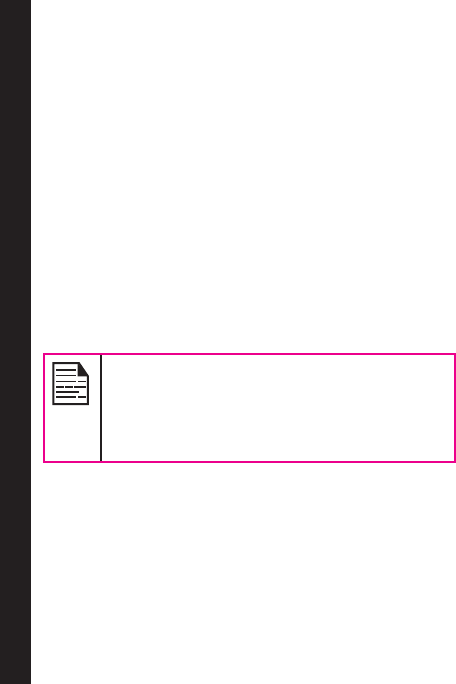
76
Managing Multimedia Files
Camera
The Sonim XP5520 has a 2MP (megapixel) camera for
taking pictures. The pictures can then be saved in your
phone.
• Select Menu > Multimedia > Camera OR press the
camera key. The camera is switched on.
• Select the menu key OR press the camera key to
shoot the picture. The picture is automatically saved
in Menu > My files > Phone > Images.
• After clicking the picture, select Options to display
the following options:
• Forward: You can send the picture to another
phone as multimedia message, e-mail or via
Bluetooth.
• Delete: You can delete the selected le.
Select Menu > Multimedia > Camera > Press
LSK > Photo Album > Select an image >
Options > Use as to set the saved image as
wallpaper, screensaver, and caller picture.
Refer “Managing Your Files” on page 44 for
further information.
Camera Options
To view the camera options, select Menu > Multimedia
> Camera > Press LSK. The following options are
displayed:
• Video Recorder/Camera: You can switch to Video
recorder mode or Camera mode, to shoot a video
or take photographs, or select Photo Album to
view the saved images. Select an image and click
Options to view the image options such as send the
photo, rename the photo, delete the photo, and so
on. Refer “Managing Your Files” on page 44 for further
information.
• Capture Mode: You can select the required
Capture mode, from the following options: Normal,
Continuous Shot, and Add frame.
• Scene mode: You can select Auto for the scene
mode to be automatic or Night mode for the image
shot at night.
• Image Size: You can select the picture size from the
following options: QVGA, VGA, 1MP and 2MP.
• Highlight: You can enable or disable automatic
ash.
• Self-timer: You can enable the self-time and set it to
5 or 10 seconds. The picture will be shot only after
the set time, after pressing the menu key.
• White balance: You can select the required white
background color balance.
• Effects: You can select the required color effects for
the image to be taken.
• Advanced Settings:
• Storage: You can set the default storage
location for pictures as Phone memory OR
Memory card.
• Image Quality: You can select the picture
quality from the following options: Fine, Good
or normal.
• Time Stamp: You can add time stamps to the
photographs and videos.
• Shutter Sound: You can select the shutter
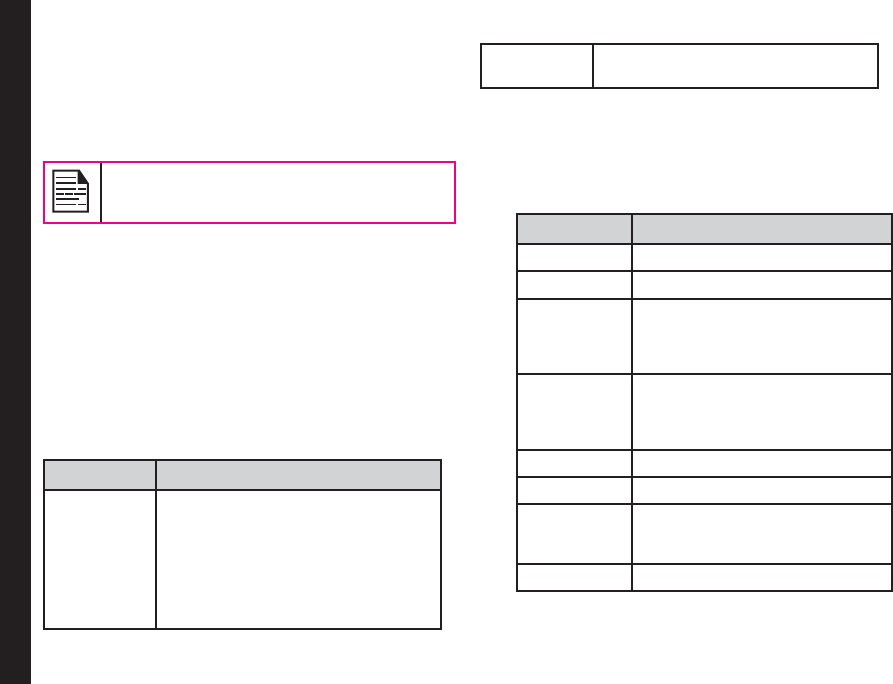
77
Entertainment
sound from the provided options.
• Anti-Flicker : You can set the frequency of
icker as 50 Hz OR 60 Hz.
• Restore default: Select this to reset the
camera settings to the original factory camera
settings.
While taking a picture, you can use the
navigation arrow keys and alphanumeric keys
to quickly access various camera options.
Media Player
You can use the built-in media player to play the audio
and video les. To access media player, select Menu >
Multimedia > Media player. The following sub-menus
are listed:
Now Playing
You can view the audio/video files that is currently being
played. You can pause, stop, play the previous song, or
the next following song by using the navigation arrow
keys. Select Options > Settings to display and set the
following settings:
Settings Function
Player
settings
Dene the background display
settings, shufe the playlist, and song
repeat sequence of the playlist. You
can play the audio in background.
A strip in the home screen indicates
that audio is playing in background.
You can also dene the sound effects
and Bass enhancement.
Audio
settings
You can dene the play speed of the
audio.
Music Playlists
You can view all the stored playlists. Select Options to
display the following options:
• Open: You can open a playlist and select Options.
The following options are displayed:
Options Function
Play Play a selected le.
Details View the details of the le.
Move up Select a le that is at the top of
the list by moving up. This option
is available only if there are more
than one le.
Move down Select a le that is at the bottom
of the list by moving down. This
option is available only if there are
more than one le.
Add Include a new le to the playlist.
Remove Remove a le from the playlist.
Send Send a le as a multimedia
message, E-mail, or via bluetooth
to another user.
Use Use the le as a ringtone.
• New: You can add a new playlist.
• Delete all: You can delete all the playlists.
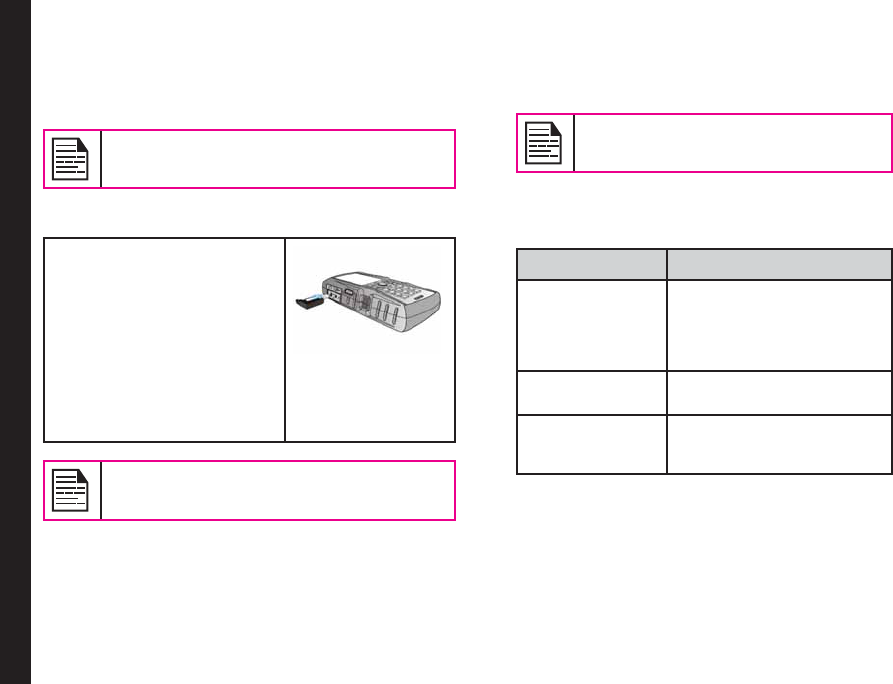
78
Entertainment
• Delete: You can delete a playlist.
• Rename: You can rename a playlist.
• Storage: You can store the playlist in phone/memory
card (if present on the phone).
You can play .mp3, .wav, .amr, and .aac audio
files. You can play MPEG and 3GP video files.
FM Radio
The FM radio is built-in and
offers instant and easy access
to FM radio channels in your
phone. A wired headset must
be attached to the phone, as
the wire works as an antenna
for the radio. To connect the
headset to the phone, lift the
cover with the headset sign
located on the left side of the
phone. You can then listen to
the radio via the wired headset.
You should connect only 3.5 mm stereo
headset to use the FM radio.
Select Menu > Multimedia > FM radio. The radio starts
playing. You can use the navigation keys to stop, play,
and search the required channel. Select Options to
display the following options.
• Channel list: You can view the channels that have
already been saved. Select a Channel > Options >
Play to play.
• Manual input: You can manually enter the frequency
to play a channel.
Select ‘#’ key to input decimals while
entering the frequency.
• Auto search: You can automatically search and
save the radio channels.
• Settings: You can dene the following settings:
Settings Function
Background play You can play the radio in
background. A strip in the
home screen indicates
that radio is playing in
background.
Skin You can dene the
background display settings.
Loudspeaker You can select On to play
FM radio in the phone
speaker.
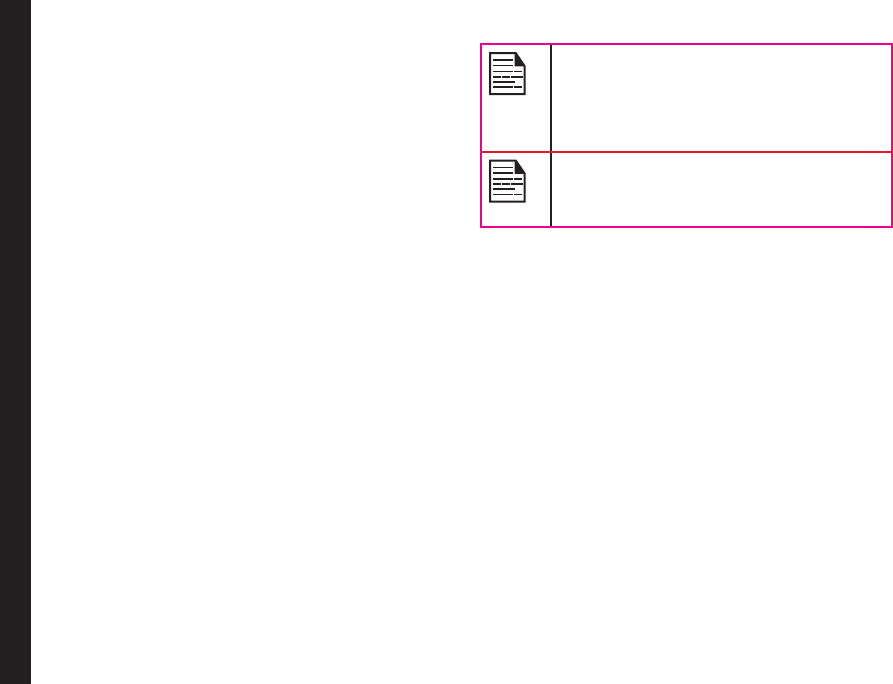
79
Hardcoded Shortcuts
The following are a set of special shortcuts related to
voice calls. Some of these features may require network
support.
• Enter 0 followed by SEND - releases all held calls
or sets User Determined User Busy (UDUB) for a
waiting call.
• Enter 1 followed by SEND - Releases all active calls
(if any exist) and accepts the other (held or waiting)
call.
• Enter 1X followed by SEND - Releases a specic
active call X.
• Enter 2 followed by SEND - Places all active calls (if
any exists) on hold and accepts the other (held or
waiting) call.
• Enter 2X followed by SEND - Places all active calls
on hold except call X with which communication
shall be supported.
• Enter 3 followed by SEND - Adds a held call to the
conversation.
• Enter 4 followed by SEND - Connects two calls and
disconnects the subscriber from both calls (ECT).
• Enter 4 * “Directory Number” followed by SEND
- Redirects an incoming or a waiting call to the
specied directory number.
• Enter 5 followed by SEND - Activates the completion
of calls to busy subscriber request.
• Enter “Directory Number” followed by SEND -
Places all active calls (if any exists) on hold and sets
up a new call to the specied directory number.
• Enter END - Releases the subscriber from all calls
(except a possible waiting call).
“X” is the numbering (starting with 1) of the
call given by the sequence of setting up or
receiving the calls (active, held or waiting)
as seen by the served subscriber. Calls hold
their number until they are released. New
calls take the lowest available number.
Where both a held and a waiting call exist,
the above procedures shall apply to the
waiting call (that is, not to the held call) in
conicting situation.
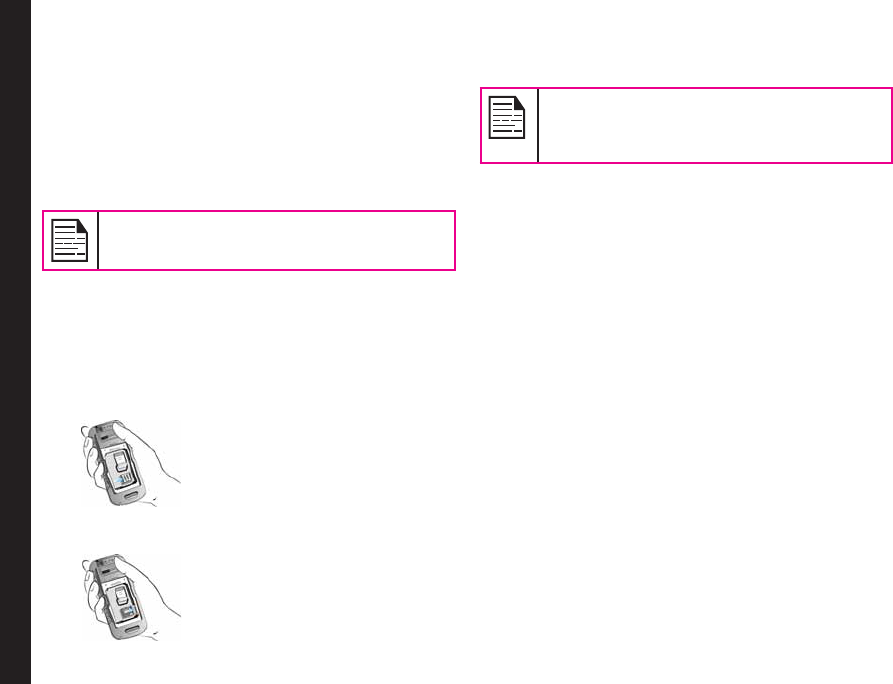
80
Using Menory Card
In Sonim XP5520 phone, you can insert a removable
memory Card to increase the storage capacity. This card
is inserted into the slot inside the phone. You can perform
the following functions on the SD card.
• Formatting of the memory card.
• Viewing memory details such as free space and total
space.
• Storing user data.
The maximum capacity supported is up to 16
GB.
Inserting Memory card into the Phone
1. Ensure the phone is switched off.
2. Lift the battery cover and remove the battery. For
instructions refer “Inserting the Battery” on page 15.
3. Slide and lift the silver clip over the designated slot
located below the SIM card slot.
4. Place the memory card in the designated slot and
close the silver clip.
5. Replace the battery and the cover. Turn the battery
cover screws clockwise to lock the battery cover.
When the Sonim XP5520 phone is connected
to a computer in mass storage mode, the
Micro SD card is displayed as a separate drive
in the computer.
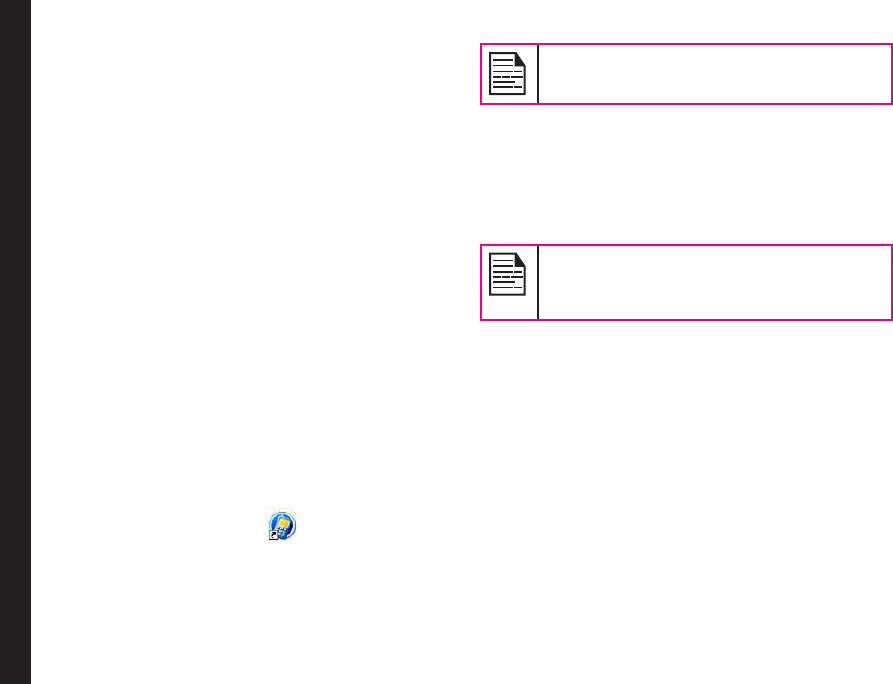
81
Using PC- TOOLS
Sonim XP5520 PC Tools application provides
synchronization of contacts, calendar and related data
between your computer and XP5520 phone to ensure
that both media have complete up-to-date data at the
same time. You can also easily data transfer between a
computer and an XP5520 phone.
Installation of PC-Tools
You can download the Sonim PC Tools Installer from
http://www.sonimtech.com/support/downloads.php and
install as follows:
1. Connect to http://www.sonimtech.com/support/
downloads.php.
2. Select the appropriate phone model.
3. Click Accept to accept the terms of the disclaimer
and to continue downloading.
4. Select the destination folder in your computer to
save the zipped le.
5. Navigate to the destination folder and click the
Autorun.exe le to install the PC-Tools on your
computer.
Using PC-Tools with XP5520 Phone
To use the PC-Tools with your XP5520 Phone, do the
following:
1. Click the PC-Tools icon ( ) on your computer
desktop.
2. Connect the XP5520 phone to the USB port of the
computer using a USB cable.
If the phone is not connected to the computer,
then all the menus in the PC-Tools application
are disabled except Setup menu.
4. Once the USB cable is connected, the USB cong
screen is displayed on the phone. Select COM port
and click OK.
5. Use Sync Manager application to synchronize
data including contacts and calendar, between your
computer and mobile phone to ensure both media
have complete up-to-date data.
For complete information on PC-Tools
installation procedures and using the PC-Tools,
refer XP5520 PC-Tools Installation and User
Guide.

82
End User License Agreement
This wireless device, (the “Device”) contains software
owned by Sonim Technologies, Inc. (“Sonim”) and its
third party suppliers and licensors (collectively, the
“Software”). As user of this Device, Sonim grants you a
non-exclusive, non-transferable, non-assignable license
to use the software solely in conjunction with the Device
on which it is installed and/or delivered with. Nothing
herein shall be construed as a sale of the Software to a
user of this Device.
You shall not reproduce, modify, distribute, reverse
engineer, decompile, otherwise alter or use any other
means to discover the source code of the Software
or any component of the Software. For avoidance of
doubt, you are at all times entitled to transfer all rights
and obligations to the Software to a third party, solely
together with the Device with which you received the
Software, provided always that such third party agrees in
writing to be bound by these rules.
You are granted this license for a term of the useful life of
this Device. You can terminate this license by transferring
all your rights to the Device on which you have received
the Software to a third party in writing. If you fail to
comply with any of the terms and conditions set out in
this license, it will terminate with immediate effect Sonim
and its third party suppliers and licensors are the sole and
exclusive owner of and retain all rights, title and interest
in and to the Software. Sonim, and, to the extent that the
Software contains material or code of a third party, such
third party, shall be entitled third party beneciaries of
these terms. The validity, construction and performance
of this license shall be governed by the laws of Delaware,
United States.
Comprehensive 3 Year Warranty
Sonim provides this Comprehensive three year warranty
for your mobile phone (hereinafter referred to as
Product”).
To activate the three year comprehensive warranty,
register your phone within 30 days at www.sonimtech.
com/register.
Should your Product need service, please contact your
local Sonim Customer Service Center. The online support
and country specic contact information can be found at:
www.sonimtech.com/support.
Our Warranty
Subject to the conditions of this Comprehensive 3 year
Warranty Sonim warrants this product to be free from
major defects in design, material and workmanship at
the time of its original purchase by a consumer, and for a
subsequent period of Three (3) years.
What We Will Do
If during the guarantee period, this product fails to
operate under normal use and service, due to defects
in design, material or workmanship, Sonim’s authorised
distributors or service partners, in the country/region
where you purchased the product, will repair or replace
at the sole discretion of Sonim, with the same or better
model in the same or better condition. Sonim and its
service partners reserve the right to charge a handling fee
if a returned product is found not to be under warranty
according to the conditions below.
Please note that some of your personal settings,
downloads or other information may be lost when your
Sonim Product is repaired or replaced. Sonim does not

83
take any responsibility for any lost information of any kind
and will not reimburse you for any such loss. You should
always make backup copies of all the information stored
on your Sonim Product such as downloads, calendar and
contacts before handing in your Sonim Product for repair
or replacement.
Phone Care
The Sonim XP5520 is designated class IP68 for dust and
water protection, according to the IEC Ingress Protection
(IP) Standard 60529. This means that the phone is dust
protected and can be submerged into 2m deep water for
up to 30 minutes. Immersion in deeper water can damage
it and must be avoided.
The Sonim XP5520 is solid and built for heavy duty use.
Its design protects against disassembly or mechanical
damage when subjected to forces equal to free fall from
the height of 2 meters. Subjecting the phone to stronger
impact and forces can damage it and must be avoided.
Conditions
1. The warranty is valid only if the product has been
registered within 30 days of date of purchase, and
sonim reserves the right to refuse warranty service
otherwise.
2. Should the phone not be registered, the warranty is
valid only if the original proof of purchase issued to
the original purchaser by a Sonim authorised dealer,
specifying the date of purchase and serial number
for this Product, is presented with the Product to
be repaired or replaced. Sonim reserves the right to
refuse warranty service if this information has been
removed or changed after the original purchase of
the Product from the dealer.
3. If Sonim repairs or replaces the Product, the
repaired or replaced Product shall be warranted
for the remaining time of the original warranty
period or for ninety (90) days from the date of
repair, whichever is longer. Repair or replacement
may involve the use of functionally equivalent
reconditioned units. Replaced parts or components
will become the property of Sonim.
4. This warranty does not cover any failure of the
Product due to normal wear and tear, or due to
misuse or abuse, including but not limited to use
in other than the normal and customary manner, in
accordance with the Sonim instructions for use and
maintenance of the Product. Nor does this warranty
cover any failure of the Product due to software or
hardware modication or adjustment, acts of God
or damage resulting from liquid interacting with the
product beyond what is described as acceptable
in the user guide for the product. A rechargeable
battery can be charged and discharged hundreds of
times. However, it will eventually wear out - this is
not a defect. When the talk-time or standby time is
noticeably shorter, it is time to replace your battery.
Sonim recommends that you use only batteries and
chargers approved by Sonim. Minor variations in
display brightness and colour may occur between
phones. There may be tiny bright or dark dots on
the display. These are called defective pixels and
occur when individual dots have malfunctioned and
can not be adjusted. Several defective pixels are
deemed acceptable.
End User License Agreement

84
5. This warranty does not cover Product failures
caused by installations, modications, or repair or
opening of the Product performed by a non-Sonim
authorised person. Tampering with any of the seals
on the Product will void the warranty.
6. The warranty does not cover Product failures which
have been caused by use of accessories or other
peripheral devices which are not Sonim branded
original accessories intended for use with the
Product.
7. The 3 year warranty does not cover battery,
accessories or any 3rd party SW applications, which
are instead covered to the extent provided by the
original vendor guarantee for these products.
8. THERE ARE NO EXPRESS WARRANTIES,
WHETHER WRITTEN OR ORAL, OTHER THAN
THIS PRINTED LIMITED WARRANTY. ALL
IMPLIED WARRANTIES, INCLUDING WITHOUT
LIMITATION THE IMPLIED WARRANTIES OF
MERCHANTABILITY OR FITNESS FOR A
PARTICULAR PURPOSE, ARE LIMITED TO THE
DURATION OF THIS LIMITED WARRANTY. IN NO
EVENT SHALL SONIM OR ITS LICENSORS BE
LIABLE FOR INCIDENTAL OR CONSEQUENTIAL
DAMAGES OF ANY NATURE WHATSOEVER,
INCLUDING BUT NOT LIMITED TO LOST PROFITS
OR COMMERCIAL LOSS; TO THE FULL EXTENT
THOSE DAMAGES CAN BE DISCLAIMED BY LAW.
End User License Agreement

85
FCC Statement
WARNING: Changes or modications made to
this equipment not expressly approved by Sonim
Technologies, Inc. for compliance could void the user’s
authority to operate the equipment.
FCC Statement
The XP55520-A-R1 device complies with Part 15 of the
FCC rules. Operation is subject to the following two
conditions:
1. This device may not cause harmful interference.
2. This device must accept any interference received,
including interference that may cause undesired
operation.
This equipment has been tested and found to comply
with the limits for a Class B digital device, pursuant to
part 15 of the FCC Rules. These limits are designed
to provide reasonable protection against harmful
interference in a residential installation. This equipment
generates uses and can radiate radio frequency energy
and, if not installed and used in accordance with the
instructions, may cause harmful interference to radio
communications. However, there is no guarantee that
interference will not occur in a particular installation.
If this equipment does cause harmful interference to
radio or television reception, which can be determined
by turning the equipment off and on, the user is
encouraged to try to correct the interference by one or
more of the following measures:
• Reorient or relocate the receiving antenna.
• Increase the separation between the equipment
and receiver.
• Connect the equipment into an outlet on a
circuit different from that to which the receiver is
connected.
• Consult the dealer or an experienced radio/TV
technician for help.
IC Statement
The following is valid for the XP5520-A-R1 device:
1. This Class B digital apparatus complies with
Canadian ICES-003.
2. This device complies with RSS-310 of Industry
Canada. Operation is subject to the condition that
this device does not cause harmful interference.

86
A
Activating PTT service 66
Add a Favorite PTT Group 74
Add a new contact 73
Add a new PTT contact 72
Add a new PTT Group 73
Alarm clock 61
Audio
Playback 63
B
Battery
Charging indicator 16
Usage Information 15
Block Incoming PTT Calls 71
Bluetooth connectivity 41
Activation 41
Connecting headset 41
Deactivation 41
Deleting paired device 42
Device pairing 41
Renaming paired device 42
Sending data to paired device 42
Settings 42
Specications 41
Supported Proles 41
Bookmarks 65
C
Calendar 61
Editing events 61
Call accept/Send key 20
Call history/list 31
Calls on hold/waiting 32
Camera 76
Options 76
Clear key 20
Contact Options 72, 74, 75
Contacts
Add 46
Caller groups 49
Multiple contacts 48
My number 49
Phonebook settings 49
Search 50
Send message 46
View details 46
Corporate-public Subscriber 67
Corporate subscriber 66
D
Direct PTT call 70
Display settings 35
E
E-mail 55
Conguring Email account 56
Draft 57
Inbox 56
Outbox 57
Sent 57
Write 56
F
Fixed number dialing 33
Flight mode 59
FM radio 78
H
Hardcoded Shortcuts 79
Homepage 65
I
International number dialling 31
J
Java
Installing Java Application From
Memory Card 64
Installing Java Application From
WAP 64
K
Keypad
Accept/Send 23
Back 23
Clear 23, 62
End call 23
Function keys 18
LSK/RSK 23
Navigation keys 24
Index

87
Power On/Off 23
L
Language Settings 35
Left Selection Key 20
Login and Logout of PTT Service
66
M
Memory card 80
Insert 80
Messages
Broadcast 57
Drafts 54
e-mail 53
Inbox 53
MMS 52
Outbox 54
Sent 55
Settings 57
SMS 51
Template 57
N
Network Connectivity 41
O
One-to-One PTT Call 70
P
PC-TOOLS 81
Proles 59
Flight 59
General 59
Headset 59
Meeting 59
Outdoor 59
Silent 59
PTT Call History 71
PTT call me alerts 71
PTT Calls 69
PTT Group Call 70
PTT Key Functions 68
PTT Settings 68
PTT subgroup Call 71
Public subscriber 66
Q
Quick Group PTT Call 70
R
Recording a call 34
S
Security Settings 40
Send a PTT call me alert 71
Silent mode 59
Sound Recorder 63
Speed dial 36
T
Themes 35
Tools
Alarm clock 61
Calculator 61
Calendar 61
Notes 63
SIM card menu 63
Sound recorder 63
Stopwatch 63
Text reader 63
Unit converter 62
World clock 62
U
Unit converter 62
USB function 43
V
Voicemail
Server settings 58
W
WAP
Address 65
Service inbox 65
Settings 65
World clock 62
Write Messages 51
Index